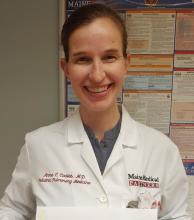User login
Chest Infections & Disaster Response Network
Disaster Response and Global Health Section
Physician response to Ukraine and beyond
Displaced persons, international refugee crises, gun violence, and other disasters remain prevalent in current news. Recent events highlight the need for continued civilian physician leadership and response to disasters.
Before the Ukraine crisis, the United Nations Refugee Agency estimated displaced persons more than doubled to greater than 82 million persons over the last decade (unhcr.org). Since that analysis, there have been over 6.5 million externally displaced persons, 7.5 million internally displaced persons, and significant numbers of injured patients from the Ukraine crisis alone. The Ukraine Ministry of Health has shown preparedness in its ability to handle significant patient surges with minimal assistance.
However, organizations like the Ukraine Medical Association of North America, Razom for Ukraine, Doctors Without Borders (MSF), MedGlobal, Samaritan’s Purse, Global Response Management, and many more have deployed to assist in Ukraine. These NGOs continue to help with medical care, fulfill critical supply needs, and provide training in cutting-edge medicine (POCUS, trauma updates).
Challenges posed by unstable environments, from wars to active shooter situations, further underscore the need for continued education, advances in technology, and preparedness. Providers responding to these events often treat vulnerable populations suffering from physical and mental violence, requiring physicians to step out of their comfort zone.
Physicians should continue to be leaders in the care of vulnerable displaced persons.
Christopher Miller, DO, MPH
Fellow-in-Training Member
Thomas Marston, MD
Member-at-Large
Disaster Response and Global Health Section
Physician response to Ukraine and beyond
Displaced persons, international refugee crises, gun violence, and other disasters remain prevalent in current news. Recent events highlight the need for continued civilian physician leadership and response to disasters.
Before the Ukraine crisis, the United Nations Refugee Agency estimated displaced persons more than doubled to greater than 82 million persons over the last decade (unhcr.org). Since that analysis, there have been over 6.5 million externally displaced persons, 7.5 million internally displaced persons, and significant numbers of injured patients from the Ukraine crisis alone. The Ukraine Ministry of Health has shown preparedness in its ability to handle significant patient surges with minimal assistance.
However, organizations like the Ukraine Medical Association of North America, Razom for Ukraine, Doctors Without Borders (MSF), MedGlobal, Samaritan’s Purse, Global Response Management, and many more have deployed to assist in Ukraine. These NGOs continue to help with medical care, fulfill critical supply needs, and provide training in cutting-edge medicine (POCUS, trauma updates).
Challenges posed by unstable environments, from wars to active shooter situations, further underscore the need for continued education, advances in technology, and preparedness. Providers responding to these events often treat vulnerable populations suffering from physical and mental violence, requiring physicians to step out of their comfort zone.
Physicians should continue to be leaders in the care of vulnerable displaced persons.
Christopher Miller, DO, MPH
Fellow-in-Training Member
Thomas Marston, MD
Member-at-Large
Disaster Response and Global Health Section
Physician response to Ukraine and beyond
Displaced persons, international refugee crises, gun violence, and other disasters remain prevalent in current news. Recent events highlight the need for continued civilian physician leadership and response to disasters.
Before the Ukraine crisis, the United Nations Refugee Agency estimated displaced persons more than doubled to greater than 82 million persons over the last decade (unhcr.org). Since that analysis, there have been over 6.5 million externally displaced persons, 7.5 million internally displaced persons, and significant numbers of injured patients from the Ukraine crisis alone. The Ukraine Ministry of Health has shown preparedness in its ability to handle significant patient surges with minimal assistance.
However, organizations like the Ukraine Medical Association of North America, Razom for Ukraine, Doctors Without Borders (MSF), MedGlobal, Samaritan’s Purse, Global Response Management, and many more have deployed to assist in Ukraine. These NGOs continue to help with medical care, fulfill critical supply needs, and provide training in cutting-edge medicine (POCUS, trauma updates).
Challenges posed by unstable environments, from wars to active shooter situations, further underscore the need for continued education, advances in technology, and preparedness. Providers responding to these events often treat vulnerable populations suffering from physical and mental violence, requiring physicians to step out of their comfort zone.
Physicians should continue to be leaders in the care of vulnerable displaced persons.
Christopher Miller, DO, MPH
Fellow-in-Training Member
Thomas Marston, MD
Member-at-Large
Bronchiectasis, microplastics, and end-of-life
Airways disorders network, bronchiectasis section
Phenotyping bronchiectasis: Focus on eosinophilic bronchiectasis
Bronchiectasis has been often linked to neutrophilic inflammation; however, 20% may have a predominantly eosinophilic inflammation.
Eosinophilic bronchiectasis has been associated with a distinct airway microbiome. Shoemark and colleagues showed in an analysis of 1,007 patients from five countries that 22.6% of patients had blood eosinophil counts (BEC) of >300 cells/μL. BEC of <100 cells/μL were associated with higher bronchiectasis severity and increased mortality (Shoemark et al. Am J Respir Crit Care Med. 2022;205[8]:894-902).
BEC of >300 cells/μL were correlated with Streptococcus- and Pseudomonas-dominated microbiome profiles. Compared with patients with BEC of <100 cells/μL, patients with 100-299 cells/μL (hazard ratio [HR], 2.38; 95% confidence interval, 1.33–4.25; P = .003) and those with >300 cells/μL (HR, 3.99; 95% confidence interval, 2.20–7.85; P = .0001) were associated with shorter time to exacerbation.
Eosinophilic inflammation is a risk factor for exacerbations in patients with P. aeruginosa infection and may be considered as a treatable trait. Shoemark and colleagues’ data show that quality of life was improved with inhaled corticosteroid treatment in patients with bronchiectasis who had blood eosinophil counts of >3%, and eosinophils contribute to bronchiectasis exacerbations.
Dharani Narendra, MD
Navitha Ramesh, MD, FCCP
Diego Maselli Caceres, MD, FCCP
Section Members-at-Large
Diffuse lung disease and lung transplant network, occupational and environmental health section
A ubiquitous invasion: The rise of microplastics
About 6.3 billion tons of plastic waste were produced between 1950 and 2015.1 Their degradation into submillimeter fragments of 1 μm to 5 mm, is called microplastics (MP).2 MP are vectors of pollutants, pathologic microorganisms, and chemical additives used in their fabrication.3 Exposure to MP is unavoidable as they are bio-persistent and ubiquitous, even indoors.4 MP have been detected in the snow of large metropolitan areas and in remote locations.5 Humans are exposed to MP via oral ingestion and inhalation. A Brazilian study of human lung autopsy specimens revealed the presence of MP in 13 of 20 subjects.3
In vitro studies have suggested a causal role of polystyrene-MP in the development of chronic pulmonary disease through the formation of reactive oxygen species, inhibition of cell proliferation, and cellular morphology aberration.6 MP can cause local effects due to macrophage-induced inflammation, or alternatively, be transported distantly to the pleura and the systemic circulation.
In addition, MP may disrupt the endocrine pathway due to its estrogenic effects.7 Larger MPs of 8 to 10 µm, like nylon, have been associated with interstitial lung disease.8 Lung biopsies from workers exposed to airborne synthetic fibers (acrylic, polyester, and terylene) have revealed different degrees of inflammation, granulomas, and interstitial fibrosis.9 Factory workers exposed to polyvinyl chloride dust have increased risk of exertional dyspnea and decreased pulmonary function.10 Due to the pervasive nature of MP, it is essential to establish the global burden of airborne MP and to determine its role in lung health.
Bathmapriya Balakrishnan, MD
Member-at-Large
*Tyler Church, DO
Fellow-in-Training Member
*Disclaimer: The views expressed in this article are those of the author(s) and do not reflect the official policy of the Department of Army/Navy/Air Force, Department of Defense, or U.S. Government.
References
1. Rhodes CJ. Plastic pollution and potential solutions. Sci Prog. 2018;101(3):207-60.
2. Danopoulos E et al. Microplastic contamination of drinking water: A systematic review. PLoS One. 2020;15(7):e0236838.
3. Amato-Lourenço LF et al. Presence of airborne microplastics in human lung tissue. J Hazard Mater. 2021;416:126.
4. Al Horr Y et al. Occupant productivity and office indoor environment quality: A review of the literature. Building and Environment. 2016;105:369-89.
5. Bergmann M et al. White and wonderful? Microplastics prevail in snow from the Alps to the Arctic. Sci Adv. 2019;5:eaax1157.
6. Dong CD et al. Polystyrene microplastic particles: In vitro pulmonary toxicity assessment. J Hazard Mater. 2020;385:121575.
7. Amato-Lourenço LF et al. An emerging class of air pollutants: Potential effects of microplastics to respiratory human health. Sci Total Environ. 2020;749:141676.
8. Kern DG et al. Flock worker’s lung: Chronic interstitial lung disease in the nylon flocking industry. Ann Intern Med. 1998;129[4]:261-72. Erratum in: Ann Intern Med. 1999;130[3]:246.
9. Pimentel JC et al. Respiratory disease caused by synthetic fibers: a new occupational disease. Thorax. 1975;30:204-19.
10. Soutar CA et al. Epidemiological study of respiratory disease in workers exposed to polyvinyl chloride dust. Thorax. 1980;35:644-52.
Critical care network, palliative and end-of-life section
Discussing code status with families of critically ill patients
Discussing code status with patients is complex and emotional, especially when critically ill.
The complexity further increases when these conversations have to take place with family members.
Here are some practical tips to help have these conversations in a concise and compassionate manner.
Introduction
- Introduce yourself, and make sure to identify the correct decision-maker.
- Get to know the patient.
–What kind of person are they?
–What brings them joy?
- Find out what the family knows about the current clinical condition of their family member.
–What have you been hearing from the medical team?
–What are you worried about?
Update
- Fill in the gaps – update them on the clinical condition and ongoing management.
- Discuss how you think they will respond to current management and further management options.
- Allow them to process the information.
Provide a medical recommendation
- Example: We are worried he might die, and if his heart stops, interventions like CPR or intubation would not work, and we would not recommend them.
- Do not pressure for a decision right away. (You can say “We do not need a decision today, so please take time to process this information.”)
Respond to emotions
- I can’t image how hard this must be.
- Offer chaplain services if that is important to them.
Things to avoid
- Avoid aggressive language.
–We will have to pound on their chest, break ribs.
–They would be suffering.
- Blaming or judgmental language.
While this complex discussion r equires individualization, these tips will help set a framework for goals of care conversations that lead to high quality care for patients that aligns with their goals.
Reference
Goldfish and Rosielle. Language for Routine Code Status Discussions, Fast Facts and Concepts #365, Palliative Care Network of Wisconsin.
Syed Nazeer Mahmood, MD
Fellow-in-Training Member
Anne Kelemen, LCSW
Member-at-Large
Airways disorders network, bronchiectasis section
Phenotyping bronchiectasis: Focus on eosinophilic bronchiectasis
Bronchiectasis has been often linked to neutrophilic inflammation; however, 20% may have a predominantly eosinophilic inflammation.
Eosinophilic bronchiectasis has been associated with a distinct airway microbiome. Shoemark and colleagues showed in an analysis of 1,007 patients from five countries that 22.6% of patients had blood eosinophil counts (BEC) of >300 cells/μL. BEC of <100 cells/μL were associated with higher bronchiectasis severity and increased mortality (Shoemark et al. Am J Respir Crit Care Med. 2022;205[8]:894-902).
BEC of >300 cells/μL were correlated with Streptococcus- and Pseudomonas-dominated microbiome profiles. Compared with patients with BEC of <100 cells/μL, patients with 100-299 cells/μL (hazard ratio [HR], 2.38; 95% confidence interval, 1.33–4.25; P = .003) and those with >300 cells/μL (HR, 3.99; 95% confidence interval, 2.20–7.85; P = .0001) were associated with shorter time to exacerbation.
Eosinophilic inflammation is a risk factor for exacerbations in patients with P. aeruginosa infection and may be considered as a treatable trait. Shoemark and colleagues’ data show that quality of life was improved with inhaled corticosteroid treatment in patients with bronchiectasis who had blood eosinophil counts of >3%, and eosinophils contribute to bronchiectasis exacerbations.
Dharani Narendra, MD
Navitha Ramesh, MD, FCCP
Diego Maselli Caceres, MD, FCCP
Section Members-at-Large
Diffuse lung disease and lung transplant network, occupational and environmental health section
A ubiquitous invasion: The rise of microplastics
About 6.3 billion tons of plastic waste were produced between 1950 and 2015.1 Their degradation into submillimeter fragments of 1 μm to 5 mm, is called microplastics (MP).2 MP are vectors of pollutants, pathologic microorganisms, and chemical additives used in their fabrication.3 Exposure to MP is unavoidable as they are bio-persistent and ubiquitous, even indoors.4 MP have been detected in the snow of large metropolitan areas and in remote locations.5 Humans are exposed to MP via oral ingestion and inhalation. A Brazilian study of human lung autopsy specimens revealed the presence of MP in 13 of 20 subjects.3
In vitro studies have suggested a causal role of polystyrene-MP in the development of chronic pulmonary disease through the formation of reactive oxygen species, inhibition of cell proliferation, and cellular morphology aberration.6 MP can cause local effects due to macrophage-induced inflammation, or alternatively, be transported distantly to the pleura and the systemic circulation.
In addition, MP may disrupt the endocrine pathway due to its estrogenic effects.7 Larger MPs of 8 to 10 µm, like nylon, have been associated with interstitial lung disease.8 Lung biopsies from workers exposed to airborne synthetic fibers (acrylic, polyester, and terylene) have revealed different degrees of inflammation, granulomas, and interstitial fibrosis.9 Factory workers exposed to polyvinyl chloride dust have increased risk of exertional dyspnea and decreased pulmonary function.10 Due to the pervasive nature of MP, it is essential to establish the global burden of airborne MP and to determine its role in lung health.
Bathmapriya Balakrishnan, MD
Member-at-Large
*Tyler Church, DO
Fellow-in-Training Member
*Disclaimer: The views expressed in this article are those of the author(s) and do not reflect the official policy of the Department of Army/Navy/Air Force, Department of Defense, or U.S. Government.
References
1. Rhodes CJ. Plastic pollution and potential solutions. Sci Prog. 2018;101(3):207-60.
2. Danopoulos E et al. Microplastic contamination of drinking water: A systematic review. PLoS One. 2020;15(7):e0236838.
3. Amato-Lourenço LF et al. Presence of airborne microplastics in human lung tissue. J Hazard Mater. 2021;416:126.
4. Al Horr Y et al. Occupant productivity and office indoor environment quality: A review of the literature. Building and Environment. 2016;105:369-89.
5. Bergmann M et al. White and wonderful? Microplastics prevail in snow from the Alps to the Arctic. Sci Adv. 2019;5:eaax1157.
6. Dong CD et al. Polystyrene microplastic particles: In vitro pulmonary toxicity assessment. J Hazard Mater. 2020;385:121575.
7. Amato-Lourenço LF et al. An emerging class of air pollutants: Potential effects of microplastics to respiratory human health. Sci Total Environ. 2020;749:141676.
8. Kern DG et al. Flock worker’s lung: Chronic interstitial lung disease in the nylon flocking industry. Ann Intern Med. 1998;129[4]:261-72. Erratum in: Ann Intern Med. 1999;130[3]:246.
9. Pimentel JC et al. Respiratory disease caused by synthetic fibers: a new occupational disease. Thorax. 1975;30:204-19.
10. Soutar CA et al. Epidemiological study of respiratory disease in workers exposed to polyvinyl chloride dust. Thorax. 1980;35:644-52.
Critical care network, palliative and end-of-life section
Discussing code status with families of critically ill patients
Discussing code status with patients is complex and emotional, especially when critically ill.
The complexity further increases when these conversations have to take place with family members.
Here are some practical tips to help have these conversations in a concise and compassionate manner.
Introduction
- Introduce yourself, and make sure to identify the correct decision-maker.
- Get to know the patient.
–What kind of person are they?
–What brings them joy?
- Find out what the family knows about the current clinical condition of their family member.
–What have you been hearing from the medical team?
–What are you worried about?
Update
- Fill in the gaps – update them on the clinical condition and ongoing management.
- Discuss how you think they will respond to current management and further management options.
- Allow them to process the information.
Provide a medical recommendation
- Example: We are worried he might die, and if his heart stops, interventions like CPR or intubation would not work, and we would not recommend them.
- Do not pressure for a decision right away. (You can say “We do not need a decision today, so please take time to process this information.”)
Respond to emotions
- I can’t image how hard this must be.
- Offer chaplain services if that is important to them.
Things to avoid
- Avoid aggressive language.
–We will have to pound on their chest, break ribs.
–They would be suffering.
- Blaming or judgmental language.
While this complex discussion r equires individualization, these tips will help set a framework for goals of care conversations that lead to high quality care for patients that aligns with their goals.
Reference
Goldfish and Rosielle. Language for Routine Code Status Discussions, Fast Facts and Concepts #365, Palliative Care Network of Wisconsin.
Syed Nazeer Mahmood, MD
Fellow-in-Training Member
Anne Kelemen, LCSW
Member-at-Large
Airways disorders network, bronchiectasis section
Phenotyping bronchiectasis: Focus on eosinophilic bronchiectasis
Bronchiectasis has been often linked to neutrophilic inflammation; however, 20% may have a predominantly eosinophilic inflammation.
Eosinophilic bronchiectasis has been associated with a distinct airway microbiome. Shoemark and colleagues showed in an analysis of 1,007 patients from five countries that 22.6% of patients had blood eosinophil counts (BEC) of >300 cells/μL. BEC of <100 cells/μL were associated with higher bronchiectasis severity and increased mortality (Shoemark et al. Am J Respir Crit Care Med. 2022;205[8]:894-902).
BEC of >300 cells/μL were correlated with Streptococcus- and Pseudomonas-dominated microbiome profiles. Compared with patients with BEC of <100 cells/μL, patients with 100-299 cells/μL (hazard ratio [HR], 2.38; 95% confidence interval, 1.33–4.25; P = .003) and those with >300 cells/μL (HR, 3.99; 95% confidence interval, 2.20–7.85; P = .0001) were associated with shorter time to exacerbation.
Eosinophilic inflammation is a risk factor for exacerbations in patients with P. aeruginosa infection and may be considered as a treatable trait. Shoemark and colleagues’ data show that quality of life was improved with inhaled corticosteroid treatment in patients with bronchiectasis who had blood eosinophil counts of >3%, and eosinophils contribute to bronchiectasis exacerbations.
Dharani Narendra, MD
Navitha Ramesh, MD, FCCP
Diego Maselli Caceres, MD, FCCP
Section Members-at-Large
Diffuse lung disease and lung transplant network, occupational and environmental health section
A ubiquitous invasion: The rise of microplastics
About 6.3 billion tons of plastic waste were produced between 1950 and 2015.1 Their degradation into submillimeter fragments of 1 μm to 5 mm, is called microplastics (MP).2 MP are vectors of pollutants, pathologic microorganisms, and chemical additives used in their fabrication.3 Exposure to MP is unavoidable as they are bio-persistent and ubiquitous, even indoors.4 MP have been detected in the snow of large metropolitan areas and in remote locations.5 Humans are exposed to MP via oral ingestion and inhalation. A Brazilian study of human lung autopsy specimens revealed the presence of MP in 13 of 20 subjects.3
In vitro studies have suggested a causal role of polystyrene-MP in the development of chronic pulmonary disease through the formation of reactive oxygen species, inhibition of cell proliferation, and cellular morphology aberration.6 MP can cause local effects due to macrophage-induced inflammation, or alternatively, be transported distantly to the pleura and the systemic circulation.
In addition, MP may disrupt the endocrine pathway due to its estrogenic effects.7 Larger MPs of 8 to 10 µm, like nylon, have been associated with interstitial lung disease.8 Lung biopsies from workers exposed to airborne synthetic fibers (acrylic, polyester, and terylene) have revealed different degrees of inflammation, granulomas, and interstitial fibrosis.9 Factory workers exposed to polyvinyl chloride dust have increased risk of exertional dyspnea and decreased pulmonary function.10 Due to the pervasive nature of MP, it is essential to establish the global burden of airborne MP and to determine its role in lung health.
Bathmapriya Balakrishnan, MD
Member-at-Large
*Tyler Church, DO
Fellow-in-Training Member
*Disclaimer: The views expressed in this article are those of the author(s) and do not reflect the official policy of the Department of Army/Navy/Air Force, Department of Defense, or U.S. Government.
References
1. Rhodes CJ. Plastic pollution and potential solutions. Sci Prog. 2018;101(3):207-60.
2. Danopoulos E et al. Microplastic contamination of drinking water: A systematic review. PLoS One. 2020;15(7):e0236838.
3. Amato-Lourenço LF et al. Presence of airborne microplastics in human lung tissue. J Hazard Mater. 2021;416:126.
4. Al Horr Y et al. Occupant productivity and office indoor environment quality: A review of the literature. Building and Environment. 2016;105:369-89.
5. Bergmann M et al. White and wonderful? Microplastics prevail in snow from the Alps to the Arctic. Sci Adv. 2019;5:eaax1157.
6. Dong CD et al. Polystyrene microplastic particles: In vitro pulmonary toxicity assessment. J Hazard Mater. 2020;385:121575.
7. Amato-Lourenço LF et al. An emerging class of air pollutants: Potential effects of microplastics to respiratory human health. Sci Total Environ. 2020;749:141676.
8. Kern DG et al. Flock worker’s lung: Chronic interstitial lung disease in the nylon flocking industry. Ann Intern Med. 1998;129[4]:261-72. Erratum in: Ann Intern Med. 1999;130[3]:246.
9. Pimentel JC et al. Respiratory disease caused by synthetic fibers: a new occupational disease. Thorax. 1975;30:204-19.
10. Soutar CA et al. Epidemiological study of respiratory disease in workers exposed to polyvinyl chloride dust. Thorax. 1980;35:644-52.
Critical care network, palliative and end-of-life section
Discussing code status with families of critically ill patients
Discussing code status with patients is complex and emotional, especially when critically ill.
The complexity further increases when these conversations have to take place with family members.
Here are some practical tips to help have these conversations in a concise and compassionate manner.
Introduction
- Introduce yourself, and make sure to identify the correct decision-maker.
- Get to know the patient.
–What kind of person are they?
–What brings them joy?
- Find out what the family knows about the current clinical condition of their family member.
–What have you been hearing from the medical team?
–What are you worried about?
Update
- Fill in the gaps – update them on the clinical condition and ongoing management.
- Discuss how you think they will respond to current management and further management options.
- Allow them to process the information.
Provide a medical recommendation
- Example: We are worried he might die, and if his heart stops, interventions like CPR or intubation would not work, and we would not recommend them.
- Do not pressure for a decision right away. (You can say “We do not need a decision today, so please take time to process this information.”)
Respond to emotions
- I can’t image how hard this must be.
- Offer chaplain services if that is important to them.
Things to avoid
- Avoid aggressive language.
–We will have to pound on their chest, break ribs.
–They would be suffering.
- Blaming or judgmental language.
While this complex discussion r equires individualization, these tips will help set a framework for goals of care conversations that lead to high quality care for patients that aligns with their goals.
Reference
Goldfish and Rosielle. Language for Routine Code Status Discussions, Fast Facts and Concepts #365, Palliative Care Network of Wisconsin.
Syed Nazeer Mahmood, MD
Fellow-in-Training Member
Anne Kelemen, LCSW
Member-at-Large
Section reports
Pulmonary vascular & cardiovascular network: Cardiovascular medicine & surgery section
Targeted temperature management (TTM) after cardiac arrest: How cool?
Recent randomized control trials, TTM2 (Dankiewicz J. N Engl J Med. 2021;384:2283) and HYPERION (Lascarrou J-B. N Engl J Med. 2019;381:2327), of therapeutic hypothermia, as opposed to normothermia, in patients who remain comatose after return of spontaneous circulation (ROSC) after cardiac arrest have produced conflicting results regarding survival and neurologic benefit. TTM2 reported no benefit to cooling to 33°C, while HYPERION found improved neurologic outcome at 90 days in patients cooled to 33°C. The European Resuscitation Council (ERC) and European Society of Intensive Care Medicine (ESICM) recently released an evidence review and guideline for adults who remain comatose after cardiac arrest (Sandroni C. Intensive Care Med. 2022;48:261). These guidelines recommend continuous monitoring of core temperature in all patients who remain comatose after cardiac arrest, and preventing fever (>37.7°C) for 72 hours, but with no recommendation of target temperature of 32°C vs 36°C.
Differences in patient populations, presenting rhythm during arrest, duration of CPR, and time to target temperature likely each contribute to the disparate conclusions of previous trials. For example, HYPERION enrolled patients with out of hospital cardiac arrest with initial nonshockable rhythms and found benefit to cooling to 33°C. In comparison, TTM2 enrolled all patients with ROSC following arrest (regardless of rhythm), including patients with in-hospital cardiac arrest and found no benefit in therapeutic cooling. Differences in patient populations are underscored by the widely differing percentage of patients with good neurologic outcome in their respective control groups: approximately 30% in the TTM2 trial and 6% in HYPERION. The guidelines leave significant room for clinical judgment in employing therapeutic cooling but encourage the continuous monitoring of core temperature and active avoidance of fever.
Fiore Mastroianna, MD
Section Member-at-Large
Chest infections & disaster response network: Chest infections section
Update on LTBI treatment: Ensuring success by simplifying, shortening, and completing treatment
My patient has a positive IGRA test result – what’s next?
If TB disease is ruled out by clinical, radiographic, and microbiologic assessment (if indicated), then latent TB infection (LTBI) is established, and treatment should be offered, guided by shared-decision making between provider and patient.
What options are available?
While the former standard 9-month regimen of isoniazid-monotherapy can be shortened to 6 months, shorter rifamycin-based regimens are now preferred in most cases and include:
4 months rifampin daily, 3 months isoniazid plus rifampin daily, or 3 months isoniazid plus rifapentine weekly. In addition, 1 month of isoniazid plus rifapentine daily has recently been shown to be effective in people with HIV.
How to choose?
Rifamycin-based regimens have been shown to have less hepatotoxicity and higher completion rates. Drug-drug interactions are of potential concern, for example, in patients receiving anticoagulation or treatment for HIV. The clinician should be aware of rifamycins causing a flu-like illness that may be treatment-limiting. In patients with known contact to drug-resistant TB, regimens are individualized.
How to monitor?
Adherence and completion are the keys to success. Directly observed therapy may be indicated in certain scenarios. Baseline and monthly blood work is recommended for people with risk factors for hepatic or bone marrow toxicity. More importantly, patients should be instructed to discontinue LTBI medications and call the clinician with any new symptoms. HIV testing should be offered to all patients if status is unknown. Clinicians are encouraged to reach out to one of four regional TB Centers of Excellence for guidance.
Sebastian Kurz, MD, FCCP
Amee Patrawalla, MD, MPH, FCCP
Section Members-at-Large
References
Testing and Treatment of Latent Tuberculosis Infection in the United States: Clinical Recommendations. A Guide for Health Care Providers and Public Health Programs. Copyright © 2021 by the National Society of Tuberculosis Clinicians and National Tuberculosis Controllers Association
1. Shah, D. Latent tuberculosis infection. N Engl J Med. 2021;385:2271-80.
2. Official American Thoracic Society/Infectious Diseases Society of America/Centers for Disease Control and Prevention Clinical Practice Guidelines: Diagnosis of tuberculosis in adults and children. Clin Infect Dis. 2017 Jan 15;64(2):111-115.
3. Swindells et. al. One month of rifapentine plus isoniazid to prevent HIV-related tuberculosis. N Engl J Med. 2019;380:1001-11.
Thoracic oncology & chest procedures network: Lung cancer section
Adjuvant and neoadjuvant therapies in early stage lung cancer
Since the discovery of the epidermal growth factor receptor (EGFR) mutation in 2004 and the development of checkpoint blockade in 2006, personalized treatment options for non–small cell lung cancer (NSCLC) have exploded, but targeted systemic therapy medications were only recommended among patients with metastatic or locally advanced disease (Rivera MP, Matthay RA. Clin Chest Med. 2020;41[1]:ix-xi). However, in November 2020, the National Comprehensive Cancer Network (NCCN) updated guidelines to recommend EGFR testing in surgically resected stage IB-IIIA adenocarcinoma, and to consider adjuvant osimerintib in those who were mutation-positive (NCCN. Nov 2020). Interim analysis of an ongoing phase-3 trial showed 89% of patients in the osimertinib group were alive and disease-free at 24 months compared with 52% in the placebo group (hazard ratio 0.20, P < .001) (Wu YL, et al. N Engl J Med. 2020;383[18]:1711-23).
The FDA has also recently approved the use of neoadjuvant and adjuvant immunotherapy in combination with platinum-based chemotherapy. Nivolumab is now approved as neoadjuvant therapy in patients with resectable IB-IIIA NSCLC regardless of PDL-1 status. The Checkmate-816 trial showed increased median event-free survival in the immunotherapy plus chemotherapy group of 31.6 months vs 20.8 months in the chemotherapy-only group (FDA.gov. 2022, Mar 4). Atezolizumab is also now approved for adjuvant treatment following resection and platinum-based chemotherapy in patients with stage II to IIIA NSCLC whose tumors have PD-L1 expression on ≥ 1% of tumor cells. Median disease-free survival was not reached in patients in the atezolizumab groups vs 35.3 months in the best supportive care group (FDA.gov. 2021, Oct 15). With so many advances in the personalized treatment among all stages of NSCLC, this is a hopeful new chapter in the care of patients with NSCLC.
More information: https://www.nccn.org/guidelines/guidelines-process/transparency-process-and-recommendations/GetFileFromFileManager?fileManagerId=11259
Sohini Ghosh, MD
Section Member-at-Large
Diffuse lung disease and lung transplant network: Lung transplant section
Continuous distribution for lung transplant: Overhauling the wait list
Determining how to allocate the scarce resource of donor lungs to patients is a difficult task and evaluated continuously for potential improvement. Since 2005, in the United States, lung transplant recipients have been selected based primarily on location within a Donor Service Area and by lung allocation score (LAS), a composite score of urgency for transplant. This was updated in 2017 to an allocation by highest LAS within 250 nautical miles from the donor hospital. Factors such as blood type compatibility and height are also considered. Implementation of the LAS improved the sickest patients’ access to transplants while not worsening 1-year mortality (Egan TM. Semin Respir Crit Care Med. 2018;39[02]:126-37). Unfortunately, geographic hard boundaries mean a high proportion of low LAS (<50) patients receive local donors while high LAS patients receive national offers or die while on the waitlist (Iribarne A, et al. Clin Transplant. 2016:30:688-93).
A new model that employs continuous distribution has been developed based on concerns regarding equity and improving allocation. This model would prioritize patients based on factors including medical priority, efficient management of organ placement (distance), expected posttransplant outcomes, and patient access (equity). By creating a composite of these without a geographic boundary, patients would be considered more on urgency within realistic constraints of distance and outcomes.
The Organ Procurement and Transplantation Network has officially approved continuous distribution, with implementation planned for 2022; details regarding the new scoring system are to be published and further research will need to be undertaken to determine if it meets the goal of overall improvement in patient access, equity, and outcomes.
Grant A. Turner, MD, MHA
Laura Frye, MD
Section Members-at-Large
Critical care network: Non-respiratory critical care section
Update from the non-respiratory critical care section
As you’ve probably noticed, there have been some changes here at CHEST involving the Networks. Leadership here at CHEST has been hard at work restructuring the networks to make them more closely aligned with relevant clinical disciplines, and, ultimately, allow for greater participation. I am proud to have been given stewardship of the new Non-Respiratory Critical Care Section of the Critical Care Network.
So, what exactly is Non-Respiratory Critical Care? Well, that’s where I need your help. You see this network is meant to reflect the needs and wants of CHEST members like you. We need you, dear readers, to join in this venture and help us guide the content that this section will ultimately create for our members.
If you’re interested in critical care, but you don’t see your particular area of interest anywhere else in the current structure ... guess what? You’ve found the right place!
My Infectious Diseases and Nephro peeps? Welcome! Are you a surgical or anesthesia intensivist? Don’t be shy. ECMO people, let’s hear some chatter!Is therapeutic hypothermia your thing? Come on in. The water’s freezing. 33 degrees just like you folks like it. Or is it 36? Not sure. Anyway, see what I’m talking about? We really need your help!You can get involved by clicking on the Membership & Community tab at the CHEST website. Once you’re a member, you can even nominate yourself to run for the Steering Committee elections which are held periodically. Hope to see you soon!
Deep Ramachandran, MD, FCCP
Section Chair
Sleep medicine network: Non-respiratory sleep section
Unusual suspects? Breakthrough in the treatment of idiopathic hypersomnia
Idiopathic hypersomnia (IH) is a rare and debilitating disorder defined by its excessive daytime sleepiness, sleep inertia, prolonged nighttime sleep, and long, unrefreshing naps (AASM. ICSD 3rd ed. 2014). Gamma-aminobutyric acid (GABA) is one of the main inhibitory neurotransmitters in the nervous system. It is through the potentiation of GABA that substances such as alcohol and benzodiazepines yield their effects. It is also hypothesized that the “brain fog” experienced in IH may be a consequence of either higher levels of an endogenous benzodiazepines in the cerebral spinal fluid or the presence of a GABA-enhancing peptide (Rye DB. Science Transl Med. 2012;Med 4:161ra151).
Sodium oxybate (SXB), a compound that likely has its therapeutic effect through the potentiation of GABA receptors, is an effective treatment option for cataplexy and sleepiness in narcolepsy. Although there may be some overlap between narcolepsy and IH in both diagnosis and treatment (Bassetti C, et al. Brain. 1997;120:1423), it would perhaps be entirely counterintuitive (given SXB’s pharmacology) to imagine using SXB as a plausible treatment option in IH. It was, however, investigated in the treatment of refractory hypersomnia and IH. In the retrospective study looking at 46 subjects treated with SXB, 71% experienced improvement of their severe sleep inertia, 55% had a decrease in their excessive daytime sleepiness, and 52% reported a shortened nighttime sleep time (Leu-Semenescu S, et al. Sleep Med. 2016;17:38).
In a recent double-blind, randomized control trial, the lower-sodium oxybate (LXB) was trialed in 154 patients with IH. It demonstrated statistically significant and clinically meaningful improvements (compared with placebo) in the Epworth Sleepiness Scale score (P <.0001) and in the Idiopathic Hypersomnia Severity Scale (P <.0001). The effects were seen both during the up titration of LXB and the benefits were maintained during the stable phase of the intervention (Dauvilliers Y, et al. Lancet Neurol. 2022;21(1):53). In August 2021, LXB (initially launched in 2020 for the treatment of narcolepsy) is now the first FDA-approved medication to treat IH in adults. It is curious, however, that LXB’s understood therapeutic effects are secondary to the “potentiation” of the very GABA receptor we have believed to be the root cause of the debilitating symptoms in IH. Could this discovery lend to further insights into the origins of this condition?
Ruckshanda Majid, MD, FCCP
Pulmonary vascular & cardiovascular network: Cardiovascular medicine & surgery section
Targeted temperature management (TTM) after cardiac arrest: How cool?
Recent randomized control trials, TTM2 (Dankiewicz J. N Engl J Med. 2021;384:2283) and HYPERION (Lascarrou J-B. N Engl J Med. 2019;381:2327), of therapeutic hypothermia, as opposed to normothermia, in patients who remain comatose after return of spontaneous circulation (ROSC) after cardiac arrest have produced conflicting results regarding survival and neurologic benefit. TTM2 reported no benefit to cooling to 33°C, while HYPERION found improved neurologic outcome at 90 days in patients cooled to 33°C. The European Resuscitation Council (ERC) and European Society of Intensive Care Medicine (ESICM) recently released an evidence review and guideline for adults who remain comatose after cardiac arrest (Sandroni C. Intensive Care Med. 2022;48:261). These guidelines recommend continuous monitoring of core temperature in all patients who remain comatose after cardiac arrest, and preventing fever (>37.7°C) for 72 hours, but with no recommendation of target temperature of 32°C vs 36°C.
Differences in patient populations, presenting rhythm during arrest, duration of CPR, and time to target temperature likely each contribute to the disparate conclusions of previous trials. For example, HYPERION enrolled patients with out of hospital cardiac arrest with initial nonshockable rhythms and found benefit to cooling to 33°C. In comparison, TTM2 enrolled all patients with ROSC following arrest (regardless of rhythm), including patients with in-hospital cardiac arrest and found no benefit in therapeutic cooling. Differences in patient populations are underscored by the widely differing percentage of patients with good neurologic outcome in their respective control groups: approximately 30% in the TTM2 trial and 6% in HYPERION. The guidelines leave significant room for clinical judgment in employing therapeutic cooling but encourage the continuous monitoring of core temperature and active avoidance of fever.
Fiore Mastroianna, MD
Section Member-at-Large
Chest infections & disaster response network: Chest infections section
Update on LTBI treatment: Ensuring success by simplifying, shortening, and completing treatment
My patient has a positive IGRA test result – what’s next?
If TB disease is ruled out by clinical, radiographic, and microbiologic assessment (if indicated), then latent TB infection (LTBI) is established, and treatment should be offered, guided by shared-decision making between provider and patient.
What options are available?
While the former standard 9-month regimen of isoniazid-monotherapy can be shortened to 6 months, shorter rifamycin-based regimens are now preferred in most cases and include:
4 months rifampin daily, 3 months isoniazid plus rifampin daily, or 3 months isoniazid plus rifapentine weekly. In addition, 1 month of isoniazid plus rifapentine daily has recently been shown to be effective in people with HIV.
How to choose?
Rifamycin-based regimens have been shown to have less hepatotoxicity and higher completion rates. Drug-drug interactions are of potential concern, for example, in patients receiving anticoagulation or treatment for HIV. The clinician should be aware of rifamycins causing a flu-like illness that may be treatment-limiting. In patients with known contact to drug-resistant TB, regimens are individualized.
How to monitor?
Adherence and completion are the keys to success. Directly observed therapy may be indicated in certain scenarios. Baseline and monthly blood work is recommended for people with risk factors for hepatic or bone marrow toxicity. More importantly, patients should be instructed to discontinue LTBI medications and call the clinician with any new symptoms. HIV testing should be offered to all patients if status is unknown. Clinicians are encouraged to reach out to one of four regional TB Centers of Excellence for guidance.
Sebastian Kurz, MD, FCCP
Amee Patrawalla, MD, MPH, FCCP
Section Members-at-Large
References
Testing and Treatment of Latent Tuberculosis Infection in the United States: Clinical Recommendations. A Guide for Health Care Providers and Public Health Programs. Copyright © 2021 by the National Society of Tuberculosis Clinicians and National Tuberculosis Controllers Association
1. Shah, D. Latent tuberculosis infection. N Engl J Med. 2021;385:2271-80.
2. Official American Thoracic Society/Infectious Diseases Society of America/Centers for Disease Control and Prevention Clinical Practice Guidelines: Diagnosis of tuberculosis in adults and children. Clin Infect Dis. 2017 Jan 15;64(2):111-115.
3. Swindells et. al. One month of rifapentine plus isoniazid to prevent HIV-related tuberculosis. N Engl J Med. 2019;380:1001-11.
Thoracic oncology & chest procedures network: Lung cancer section
Adjuvant and neoadjuvant therapies in early stage lung cancer
Since the discovery of the epidermal growth factor receptor (EGFR) mutation in 2004 and the development of checkpoint blockade in 2006, personalized treatment options for non–small cell lung cancer (NSCLC) have exploded, but targeted systemic therapy medications were only recommended among patients with metastatic or locally advanced disease (Rivera MP, Matthay RA. Clin Chest Med. 2020;41[1]:ix-xi). However, in November 2020, the National Comprehensive Cancer Network (NCCN) updated guidelines to recommend EGFR testing in surgically resected stage IB-IIIA adenocarcinoma, and to consider adjuvant osimerintib in those who were mutation-positive (NCCN. Nov 2020). Interim analysis of an ongoing phase-3 trial showed 89% of patients in the osimertinib group were alive and disease-free at 24 months compared with 52% in the placebo group (hazard ratio 0.20, P < .001) (Wu YL, et al. N Engl J Med. 2020;383[18]:1711-23).
The FDA has also recently approved the use of neoadjuvant and adjuvant immunotherapy in combination with platinum-based chemotherapy. Nivolumab is now approved as neoadjuvant therapy in patients with resectable IB-IIIA NSCLC regardless of PDL-1 status. The Checkmate-816 trial showed increased median event-free survival in the immunotherapy plus chemotherapy group of 31.6 months vs 20.8 months in the chemotherapy-only group (FDA.gov. 2022, Mar 4). Atezolizumab is also now approved for adjuvant treatment following resection and platinum-based chemotherapy in patients with stage II to IIIA NSCLC whose tumors have PD-L1 expression on ≥ 1% of tumor cells. Median disease-free survival was not reached in patients in the atezolizumab groups vs 35.3 months in the best supportive care group (FDA.gov. 2021, Oct 15). With so many advances in the personalized treatment among all stages of NSCLC, this is a hopeful new chapter in the care of patients with NSCLC.
More information: https://www.nccn.org/guidelines/guidelines-process/transparency-process-and-recommendations/GetFileFromFileManager?fileManagerId=11259
Sohini Ghosh, MD
Section Member-at-Large
Diffuse lung disease and lung transplant network: Lung transplant section
Continuous distribution for lung transplant: Overhauling the wait list
Determining how to allocate the scarce resource of donor lungs to patients is a difficult task and evaluated continuously for potential improvement. Since 2005, in the United States, lung transplant recipients have been selected based primarily on location within a Donor Service Area and by lung allocation score (LAS), a composite score of urgency for transplant. This was updated in 2017 to an allocation by highest LAS within 250 nautical miles from the donor hospital. Factors such as blood type compatibility and height are also considered. Implementation of the LAS improved the sickest patients’ access to transplants while not worsening 1-year mortality (Egan TM. Semin Respir Crit Care Med. 2018;39[02]:126-37). Unfortunately, geographic hard boundaries mean a high proportion of low LAS (<50) patients receive local donors while high LAS patients receive national offers or die while on the waitlist (Iribarne A, et al. Clin Transplant. 2016:30:688-93).
A new model that employs continuous distribution has been developed based on concerns regarding equity and improving allocation. This model would prioritize patients based on factors including medical priority, efficient management of organ placement (distance), expected posttransplant outcomes, and patient access (equity). By creating a composite of these without a geographic boundary, patients would be considered more on urgency within realistic constraints of distance and outcomes.
The Organ Procurement and Transplantation Network has officially approved continuous distribution, with implementation planned for 2022; details regarding the new scoring system are to be published and further research will need to be undertaken to determine if it meets the goal of overall improvement in patient access, equity, and outcomes.
Grant A. Turner, MD, MHA
Laura Frye, MD
Section Members-at-Large
Critical care network: Non-respiratory critical care section
Update from the non-respiratory critical care section
As you’ve probably noticed, there have been some changes here at CHEST involving the Networks. Leadership here at CHEST has been hard at work restructuring the networks to make them more closely aligned with relevant clinical disciplines, and, ultimately, allow for greater participation. I am proud to have been given stewardship of the new Non-Respiratory Critical Care Section of the Critical Care Network.
So, what exactly is Non-Respiratory Critical Care? Well, that’s where I need your help. You see this network is meant to reflect the needs and wants of CHEST members like you. We need you, dear readers, to join in this venture and help us guide the content that this section will ultimately create for our members.
If you’re interested in critical care, but you don’t see your particular area of interest anywhere else in the current structure ... guess what? You’ve found the right place!
My Infectious Diseases and Nephro peeps? Welcome! Are you a surgical or anesthesia intensivist? Don’t be shy. ECMO people, let’s hear some chatter!Is therapeutic hypothermia your thing? Come on in. The water’s freezing. 33 degrees just like you folks like it. Or is it 36? Not sure. Anyway, see what I’m talking about? We really need your help!You can get involved by clicking on the Membership & Community tab at the CHEST website. Once you’re a member, you can even nominate yourself to run for the Steering Committee elections which are held periodically. Hope to see you soon!
Deep Ramachandran, MD, FCCP
Section Chair
Sleep medicine network: Non-respiratory sleep section
Unusual suspects? Breakthrough in the treatment of idiopathic hypersomnia
Idiopathic hypersomnia (IH) is a rare and debilitating disorder defined by its excessive daytime sleepiness, sleep inertia, prolonged nighttime sleep, and long, unrefreshing naps (AASM. ICSD 3rd ed. 2014). Gamma-aminobutyric acid (GABA) is one of the main inhibitory neurotransmitters in the nervous system. It is through the potentiation of GABA that substances such as alcohol and benzodiazepines yield their effects. It is also hypothesized that the “brain fog” experienced in IH may be a consequence of either higher levels of an endogenous benzodiazepines in the cerebral spinal fluid or the presence of a GABA-enhancing peptide (Rye DB. Science Transl Med. 2012;Med 4:161ra151).
Sodium oxybate (SXB), a compound that likely has its therapeutic effect through the potentiation of GABA receptors, is an effective treatment option for cataplexy and sleepiness in narcolepsy. Although there may be some overlap between narcolepsy and IH in both diagnosis and treatment (Bassetti C, et al. Brain. 1997;120:1423), it would perhaps be entirely counterintuitive (given SXB’s pharmacology) to imagine using SXB as a plausible treatment option in IH. It was, however, investigated in the treatment of refractory hypersomnia and IH. In the retrospective study looking at 46 subjects treated with SXB, 71% experienced improvement of their severe sleep inertia, 55% had a decrease in their excessive daytime sleepiness, and 52% reported a shortened nighttime sleep time (Leu-Semenescu S, et al. Sleep Med. 2016;17:38).
In a recent double-blind, randomized control trial, the lower-sodium oxybate (LXB) was trialed in 154 patients with IH. It demonstrated statistically significant and clinically meaningful improvements (compared with placebo) in the Epworth Sleepiness Scale score (P <.0001) and in the Idiopathic Hypersomnia Severity Scale (P <.0001). The effects were seen both during the up titration of LXB and the benefits were maintained during the stable phase of the intervention (Dauvilliers Y, et al. Lancet Neurol. 2022;21(1):53). In August 2021, LXB (initially launched in 2020 for the treatment of narcolepsy) is now the first FDA-approved medication to treat IH in adults. It is curious, however, that LXB’s understood therapeutic effects are secondary to the “potentiation” of the very GABA receptor we have believed to be the root cause of the debilitating symptoms in IH. Could this discovery lend to further insights into the origins of this condition?
Ruckshanda Majid, MD, FCCP
Pulmonary vascular & cardiovascular network: Cardiovascular medicine & surgery section
Targeted temperature management (TTM) after cardiac arrest: How cool?
Recent randomized control trials, TTM2 (Dankiewicz J. N Engl J Med. 2021;384:2283) and HYPERION (Lascarrou J-B. N Engl J Med. 2019;381:2327), of therapeutic hypothermia, as opposed to normothermia, in patients who remain comatose after return of spontaneous circulation (ROSC) after cardiac arrest have produced conflicting results regarding survival and neurologic benefit. TTM2 reported no benefit to cooling to 33°C, while HYPERION found improved neurologic outcome at 90 days in patients cooled to 33°C. The European Resuscitation Council (ERC) and European Society of Intensive Care Medicine (ESICM) recently released an evidence review and guideline for adults who remain comatose after cardiac arrest (Sandroni C. Intensive Care Med. 2022;48:261). These guidelines recommend continuous monitoring of core temperature in all patients who remain comatose after cardiac arrest, and preventing fever (>37.7°C) for 72 hours, but with no recommendation of target temperature of 32°C vs 36°C.
Differences in patient populations, presenting rhythm during arrest, duration of CPR, and time to target temperature likely each contribute to the disparate conclusions of previous trials. For example, HYPERION enrolled patients with out of hospital cardiac arrest with initial nonshockable rhythms and found benefit to cooling to 33°C. In comparison, TTM2 enrolled all patients with ROSC following arrest (regardless of rhythm), including patients with in-hospital cardiac arrest and found no benefit in therapeutic cooling. Differences in patient populations are underscored by the widely differing percentage of patients with good neurologic outcome in their respective control groups: approximately 30% in the TTM2 trial and 6% in HYPERION. The guidelines leave significant room for clinical judgment in employing therapeutic cooling but encourage the continuous monitoring of core temperature and active avoidance of fever.
Fiore Mastroianna, MD
Section Member-at-Large
Chest infections & disaster response network: Chest infections section
Update on LTBI treatment: Ensuring success by simplifying, shortening, and completing treatment
My patient has a positive IGRA test result – what’s next?
If TB disease is ruled out by clinical, radiographic, and microbiologic assessment (if indicated), then latent TB infection (LTBI) is established, and treatment should be offered, guided by shared-decision making between provider and patient.
What options are available?
While the former standard 9-month regimen of isoniazid-monotherapy can be shortened to 6 months, shorter rifamycin-based regimens are now preferred in most cases and include:
4 months rifampin daily, 3 months isoniazid plus rifampin daily, or 3 months isoniazid plus rifapentine weekly. In addition, 1 month of isoniazid plus rifapentine daily has recently been shown to be effective in people with HIV.
How to choose?
Rifamycin-based regimens have been shown to have less hepatotoxicity and higher completion rates. Drug-drug interactions are of potential concern, for example, in patients receiving anticoagulation or treatment for HIV. The clinician should be aware of rifamycins causing a flu-like illness that may be treatment-limiting. In patients with known contact to drug-resistant TB, regimens are individualized.
How to monitor?
Adherence and completion are the keys to success. Directly observed therapy may be indicated in certain scenarios. Baseline and monthly blood work is recommended for people with risk factors for hepatic or bone marrow toxicity. More importantly, patients should be instructed to discontinue LTBI medications and call the clinician with any new symptoms. HIV testing should be offered to all patients if status is unknown. Clinicians are encouraged to reach out to one of four regional TB Centers of Excellence for guidance.
Sebastian Kurz, MD, FCCP
Amee Patrawalla, MD, MPH, FCCP
Section Members-at-Large
References
Testing and Treatment of Latent Tuberculosis Infection in the United States: Clinical Recommendations. A Guide for Health Care Providers and Public Health Programs. Copyright © 2021 by the National Society of Tuberculosis Clinicians and National Tuberculosis Controllers Association
1. Shah, D. Latent tuberculosis infection. N Engl J Med. 2021;385:2271-80.
2. Official American Thoracic Society/Infectious Diseases Society of America/Centers for Disease Control and Prevention Clinical Practice Guidelines: Diagnosis of tuberculosis in adults and children. Clin Infect Dis. 2017 Jan 15;64(2):111-115.
3. Swindells et. al. One month of rifapentine plus isoniazid to prevent HIV-related tuberculosis. N Engl J Med. 2019;380:1001-11.
Thoracic oncology & chest procedures network: Lung cancer section
Adjuvant and neoadjuvant therapies in early stage lung cancer
Since the discovery of the epidermal growth factor receptor (EGFR) mutation in 2004 and the development of checkpoint blockade in 2006, personalized treatment options for non–small cell lung cancer (NSCLC) have exploded, but targeted systemic therapy medications were only recommended among patients with metastatic or locally advanced disease (Rivera MP, Matthay RA. Clin Chest Med. 2020;41[1]:ix-xi). However, in November 2020, the National Comprehensive Cancer Network (NCCN) updated guidelines to recommend EGFR testing in surgically resected stage IB-IIIA adenocarcinoma, and to consider adjuvant osimerintib in those who were mutation-positive (NCCN. Nov 2020). Interim analysis of an ongoing phase-3 trial showed 89% of patients in the osimertinib group were alive and disease-free at 24 months compared with 52% in the placebo group (hazard ratio 0.20, P < .001) (Wu YL, et al. N Engl J Med. 2020;383[18]:1711-23).
The FDA has also recently approved the use of neoadjuvant and adjuvant immunotherapy in combination with platinum-based chemotherapy. Nivolumab is now approved as neoadjuvant therapy in patients with resectable IB-IIIA NSCLC regardless of PDL-1 status. The Checkmate-816 trial showed increased median event-free survival in the immunotherapy plus chemotherapy group of 31.6 months vs 20.8 months in the chemotherapy-only group (FDA.gov. 2022, Mar 4). Atezolizumab is also now approved for adjuvant treatment following resection and platinum-based chemotherapy in patients with stage II to IIIA NSCLC whose tumors have PD-L1 expression on ≥ 1% of tumor cells. Median disease-free survival was not reached in patients in the atezolizumab groups vs 35.3 months in the best supportive care group (FDA.gov. 2021, Oct 15). With so many advances in the personalized treatment among all stages of NSCLC, this is a hopeful new chapter in the care of patients with NSCLC.
More information: https://www.nccn.org/guidelines/guidelines-process/transparency-process-and-recommendations/GetFileFromFileManager?fileManagerId=11259
Sohini Ghosh, MD
Section Member-at-Large
Diffuse lung disease and lung transplant network: Lung transplant section
Continuous distribution for lung transplant: Overhauling the wait list
Determining how to allocate the scarce resource of donor lungs to patients is a difficult task and evaluated continuously for potential improvement. Since 2005, in the United States, lung transplant recipients have been selected based primarily on location within a Donor Service Area and by lung allocation score (LAS), a composite score of urgency for transplant. This was updated in 2017 to an allocation by highest LAS within 250 nautical miles from the donor hospital. Factors such as blood type compatibility and height are also considered. Implementation of the LAS improved the sickest patients’ access to transplants while not worsening 1-year mortality (Egan TM. Semin Respir Crit Care Med. 2018;39[02]:126-37). Unfortunately, geographic hard boundaries mean a high proportion of low LAS (<50) patients receive local donors while high LAS patients receive national offers or die while on the waitlist (Iribarne A, et al. Clin Transplant. 2016:30:688-93).
A new model that employs continuous distribution has been developed based on concerns regarding equity and improving allocation. This model would prioritize patients based on factors including medical priority, efficient management of organ placement (distance), expected posttransplant outcomes, and patient access (equity). By creating a composite of these without a geographic boundary, patients would be considered more on urgency within realistic constraints of distance and outcomes.
The Organ Procurement and Transplantation Network has officially approved continuous distribution, with implementation planned for 2022; details regarding the new scoring system are to be published and further research will need to be undertaken to determine if it meets the goal of overall improvement in patient access, equity, and outcomes.
Grant A. Turner, MD, MHA
Laura Frye, MD
Section Members-at-Large
Critical care network: Non-respiratory critical care section
Update from the non-respiratory critical care section
As you’ve probably noticed, there have been some changes here at CHEST involving the Networks. Leadership here at CHEST has been hard at work restructuring the networks to make them more closely aligned with relevant clinical disciplines, and, ultimately, allow for greater participation. I am proud to have been given stewardship of the new Non-Respiratory Critical Care Section of the Critical Care Network.
So, what exactly is Non-Respiratory Critical Care? Well, that’s where I need your help. You see this network is meant to reflect the needs and wants of CHEST members like you. We need you, dear readers, to join in this venture and help us guide the content that this section will ultimately create for our members.
If you’re interested in critical care, but you don’t see your particular area of interest anywhere else in the current structure ... guess what? You’ve found the right place!
My Infectious Diseases and Nephro peeps? Welcome! Are you a surgical or anesthesia intensivist? Don’t be shy. ECMO people, let’s hear some chatter!Is therapeutic hypothermia your thing? Come on in. The water’s freezing. 33 degrees just like you folks like it. Or is it 36? Not sure. Anyway, see what I’m talking about? We really need your help!You can get involved by clicking on the Membership & Community tab at the CHEST website. Once you’re a member, you can even nominate yourself to run for the Steering Committee elections which are held periodically. Hope to see you soon!
Deep Ramachandran, MD, FCCP
Section Chair
Sleep medicine network: Non-respiratory sleep section
Unusual suspects? Breakthrough in the treatment of idiopathic hypersomnia
Idiopathic hypersomnia (IH) is a rare and debilitating disorder defined by its excessive daytime sleepiness, sleep inertia, prolonged nighttime sleep, and long, unrefreshing naps (AASM. ICSD 3rd ed. 2014). Gamma-aminobutyric acid (GABA) is one of the main inhibitory neurotransmitters in the nervous system. It is through the potentiation of GABA that substances such as alcohol and benzodiazepines yield their effects. It is also hypothesized that the “brain fog” experienced in IH may be a consequence of either higher levels of an endogenous benzodiazepines in the cerebral spinal fluid or the presence of a GABA-enhancing peptide (Rye DB. Science Transl Med. 2012;Med 4:161ra151).
Sodium oxybate (SXB), a compound that likely has its therapeutic effect through the potentiation of GABA receptors, is an effective treatment option for cataplexy and sleepiness in narcolepsy. Although there may be some overlap between narcolepsy and IH in both diagnosis and treatment (Bassetti C, et al. Brain. 1997;120:1423), it would perhaps be entirely counterintuitive (given SXB’s pharmacology) to imagine using SXB as a plausible treatment option in IH. It was, however, investigated in the treatment of refractory hypersomnia and IH. In the retrospective study looking at 46 subjects treated with SXB, 71% experienced improvement of their severe sleep inertia, 55% had a decrease in their excessive daytime sleepiness, and 52% reported a shortened nighttime sleep time (Leu-Semenescu S, et al. Sleep Med. 2016;17:38).
In a recent double-blind, randomized control trial, the lower-sodium oxybate (LXB) was trialed in 154 patients with IH. It demonstrated statistically significant and clinically meaningful improvements (compared with placebo) in the Epworth Sleepiness Scale score (P <.0001) and in the Idiopathic Hypersomnia Severity Scale (P <.0001). The effects were seen both during the up titration of LXB and the benefits were maintained during the stable phase of the intervention (Dauvilliers Y, et al. Lancet Neurol. 2022;21(1):53). In August 2021, LXB (initially launched in 2020 for the treatment of narcolepsy) is now the first FDA-approved medication to treat IH in adults. It is curious, however, that LXB’s understood therapeutic effects are secondary to the “potentiation” of the very GABA receptor we have believed to be the root cause of the debilitating symptoms in IH. Could this discovery lend to further insights into the origins of this condition?
Ruckshanda Majid, MD, FCCP
Asthma, IPF, mechanical ventilation and more...
Airway disorders network: Asthma and COPD section
Betting on asthma: The over and under of diagnosis
Asthma is one of the major chronic respiratory diseases worldwide (WHO 2020), yet it is a clinical syndrome that lacks a consensus on its definition, is comprised of nonspecific respiratory symptoms, and is without a gold standard diagnostic test or a set guideline on confirmation of bronchial hyperresponsiveness (Sá-Sousa A et al. Clin Transl Allergy. 2014 Aug 4;4:24). In addition, once adequately treated, there is an absence of an algorithm to diagnose disease remission (Aaron SD et al. Am J Respir Crit Care Med. 2018 Oct 15;198[8]:1012-20). It is estimated that 20%-70% of people with asthma worldwide across the spectrum of all ages remain undiagnosed.
Spirometry and bronchoprovocation challenges with fixed cut-off values demonstrate reduced sensitivity with day-to-day, diurnal, and long-term variation in airflow obstruction, inflammation, and bronchial hyperresponsiveness (Wang R et al. Thorax. 2021 Jun;76[6]:624-31). Inflammatory biomarkers like fractional exhaled nitric oxide (FeNO) have higher specificity but are subject to diurnal variation and confounding diagnoses.
Overdiagnosis of asthma can result in lost opportunity to diagnose significant cardiopulmonary diseases, unnecessary escalation of the asthma treatment regimen for poorly controlled respiratory symptoms, potential for medication adverse effects, and, increased cost burden to the patient and to the health care system (Aaron SD et al. JAMA. 2017;317:269-79; Shaw D et al. Prim Care Respir J. 2012;21:283-7). Among the newly physician-diagnosed asthmatics, <50% have spirometry performed within 1 year of diagnosis (Sokol KC et al. Am J Med. 2015 May;128[5]:502-8). Spirometry was further underutilized with limit on aerosol-generating procedures during COVID-19 pandemic (Kankaanranta H et al. J Allergy Clin Immunol Pract. 2021 Dec;9[12]:4252-3); 30%-35% obese and nonobese patients with physician-diagnosed asthma did not have current asthma when objectively assessed for airflow limitation (Aaron SD et al. JAMA. 2017;317:269-79; van Huisstede A, et al. Respir Med. 2013;107:1356-64).
Clinical remission is greater in early-onset asthma as compared with late-onset asthma (De Marco R et al. J Allergy Clin Immunol. 2002;110:228-35). If asthma is well controlled, a stepping down treatment regimen is suggested (Global Initiative for Asthma 2021;Usmani et al. J Allergy Clin Immunol Pract. 2017 Sep-Oct;5[5]:1378-87.e5; Hagan JB et al. Allergy. 2014 Apr;69[4]:510-6), and although a randomized trial is lacking, it may be feasible to “undiagnose” patients who don’t experience clinical worsening, airflow obstruction, or bronchial hyperresponsiveness after being tapered off all asthma medications with a low relapse rate (Aaron SD et al. JAMA. 2017;317:269-79; J Fam Pract. 2018;67(11):704-7).
Asthma over- and underdiagnosis is prevalent and has clinical and global health consequences. New standardized algorithms with improved biomarkers may help alter this oversight.
Richa Nahar, MD
Network Member-at-Large
Allen J. Blaivas, DO, FCCP
Network Steering Committee Chair
Diffuse lung disease and lung transplant network: Interstitial lung disease section
Future therapies for IPF
Idiopathic pulmonary fibrosis (IPF) is a chronic lung disease characterized by progressive fibrosis, respiratory failure, and a mortality rate of 80% at 5 years. Only two drugs are currently FDA-approved for IPF treatment.
The antifibrotics pirfenidone and nintedanib reduce the rate of forced vital capacity (FVC) decline and improve progression free survival (King TE et al. N Engl J Med. 2014;370:2083-92; King TE et al. N Engl J Med. 2014;370:2071-82). While considered revolutionary when introduced, these medications neither reverse disease progression nor improve symptoms. More recently, the Galapagos ISABELA Phase III clinical trial of ziritaxestat in IPF was discontinued due to an unfavorable risk-benefit profile. Despite this, several prospects for IPF therapy exist.
Post hoc analysis of the INCREASE Trial demonstrated a positive effect of inhaled treprostinil on FVC in patients with IPF and group 3 pulmonary hypertension (Waxman A et al. N Engl J Med. 2021;384:325-34). Consequently, a phase 3 randomized trial investigating its safety and efficacy in patients with IPF alone is ongoing. Additional targeted therapies for IPF are also emerging. Recombinant human pentraxin-2, an inhibitor of monocyte differentiation into proinflammatory macrophages, and pamrevlumab, a recombinant human monoclonal antibody against connective tissue growth factor, both demonstrated attenuation of FVC decline compared with placebo in phase 2 trials. Both are currently in phase 3 studies (Raghu G et al. JAMA. 2018 Jun 12;319[22]:2299-307; Sgalla G et al. Expert Opin Investig Drugs. 2020 Aug;29[8]:771-7) Lastly, in February the Food and Drug Administration granted breakthrough therapy designation to BI 1015550 for treatment of IPF based on a 12-week phase 2 randomized, double-blind, placebo-controlled trial. (Data will be presented at ATS). BI 1015550 is an oral, phosphodiesterase 4B (PDE4B) inhibitor with both antifibrotic and anti-inflammatory properties. These advances in drug development provide hope for a future where IPF is transformed from a fatal disease to one manageable over many years.
Adrian Shifren, MD
Network Member-at-Large
Gabriel Schroeder, MD
Network Member-at-Large
Sleep medicine network: Home-based mechanical ventilation and neuromuscular section
Role of airway clearance therapies in neuromuscular disease
Individuals with neuromuscular weakness have an impaired ability to cough and clear secretions from the airway, which can result in atelectasis and pneumonia. Proximal airway clearance therapies (ACT), including manual lung volume recruitment (LVR) and mechanical in-exsufflation (MI-E), mobilize secretions, improve cough efficacy, maintain chest wall compliance, and slow progression of restrictive lung impairment (Chatwin et al. Respir Med. 2018;136:98-110; Sheers et al. Respirology. 2019;24:512-520).
ACT are recommended in international care guidelines for respiratory management of individuals with neuromuscular disease. At a recent Home-based Mechanical Ventilation and Neuromuscular Disease Section “PEEPS Talking PAP” rounds, participants discussed their approach to ACT. Practices varied by country and between adult/pediatric care providers. MI-E is most often used in the United States, but elsewhere in the world, LVR with a self-inflating bag and one-way valve is first-line therapy. Clinical care guidelines suggest initiation of regular ACT when cough peak flow is < 270 L/minute, forced vital capacity < 40%-60% predicted, or with subjectively weak cough (Hull et al. Thorax. 2012;67(7):654-655; Amin et al. Can J Resp Crit Care Sleep Med. 2017;1(1):7-36; McKim et al. Can Resp J. 2011;18(4):197-215; Birnkrant et al. Lancet Neurol. 2018;17(4):347-361; Sheehan et al. Pediatrics. 2018;142(Suppl 2):S62-s71).
Optimal timing for initiation of routine ACT, however, is not clear. A newly published randomized controlled trial of twice daily LVR in boys with Duchenne muscular dystrophy with relatively normal baseline lung function did not demonstrate a significant slowing of decline in forced vital capacity over 2 years. In individuals with preserved lung function, the burden of regular therapy may outweigh benefit (Katz et al. Thorax. 2022; doi: 10.1136/thoraxjnl-2021-218196). (While we are still learning about how best to apply this therapy in less advanced neuromuscular disease, ACT has demonstrated benefits during respiratory exacerbations, and routine use plays a role in preservation of lung function in more advanced disease (Katz et al. Ann Am Thorac Soc. 2016;13(2):217-222; McKim et al. Arch Phys Med Rehab. 2012;93(7):1117-1122; O’Sullivan et al. Arch Phys Med Rehabil. 2021;102(5):976-983; Bach et al. Am J Phys Med Rehab. 2008;87(9):720-725).
Sherri Katz, MD, FCCP
Section Steering Committee Chair
Critical care network: Mechanical ventilation and airways management section
NIV following extubation: Which devices and which patients?
For those of us interested in studying mechanical ventilation, an interesting paradox exists: despite our interest and enthusiasm in studying it, our patients benefit from avoiding it! Patients who require re-intubation are at high risk of in-hospital mortality (Frutos-Vivar et al. J Crit Care. 2011;26:502-9).
Studies in high-risk patients receiving mechanical ventilation have demonstrated that patients treated with immediate noninvasive ventilation (NIV) following extubation had reduced risk of re-intubation. CHEST guidelines focused on ventilator liberation considered these studies in a metanalysis which led to recommendations to employ NIV immediately after extubation in high-risk patients to reduce re-intubation rates (Ouellette D et al. Chest. 2017;151:166-80).
In the years since the publication of the CHEST guidelines, more information has been forthcoming. Evidence has emerged that treatment with high-flow nasal cannula devices following extubation may mitigate against re-intubation. An interesting strategy from the High-Wean Study Group suggested that postextubation combination therapy with both a high-flow cannula and NIV leads to improved outcomes compared with high-flow alone (Thille AW et al. JAMA. 2019;322:1465-75).
Thille and coworkers recently broadened our concept of patients who may benefit from NIV post extubation. They examined a cohort of obese patients requiring mechanical ventilation, finding that when patients were treated with NIV and high-flow nasal cannula post extubation, that they had a reduced risk of re-intubation compared with a group receiving high flow alone (Thille AW, et al. Am J Respir Crit Care Med. 2022;205:440-9).
As the incoming chair of the Mechanical Ventilation and Airways Management Section of the CHEST Critical Care Network, I look forward during the next 2 years to having interesting conversations about topics like this one and working with section members to develop exciting new projects concerning mechanical ventilation.
Daniel Ouellette, MD, MS, FCCP
Section Steering Committee Chair
Thoracic oncology and chest procedures network: Pleural disease section
Management of recurrent transudative pleural effusions (REDUCE trial)
Nonmalignant pleural effusions contribute significantly to health care costs and mortality (Mummadi SR et al. CHEST. 2021 Oct;160[4]:1534-51; Walker SP et al. CHEST. 2017 May;151[5]:1099-105). Management of transudative effusions has traditionally been to treat the underlying etiology. However, despite maximal medical therapies, these recurrent effusions may add to patients’ symptom burden and often create a challenge for the clinician. In 2017, the FDA approved the use of indwelling pleural catheters (IPC) in patients with recurrent transudative effusions, but data are limited.
In a recent prospective multicenter randomized control trial, Walker and colleagues (Eur Respir J. 2022 Feb;59:2101362) aimed to compare IPCs to repeated therapeutic thoracentesis (TT) in the management of transudative effusions. Pleural fluid etiologies included heart (68%), liver (24%), and renal failure (8%). The primary outcome was mean dyspnea score (daily visual analog scales) over 12 weeks, and there was no significant difference noted (39.7 vs. 45.0, mean difference –2.9 mm, 95% confidence interval [CI] –16.1 to 10.3; P = .67). Secondary outcomes demonstrated increased overall drainage in the IPC vs. TT group (17,412 mL vs. 2,901 mL, difference 13,892 mL, 95% CI, 7,669-20,116 mL; P < .001) and fewer invasive procedures required in the IPC group. Adverse events were noted in 59% of the IPC group compared with 37% managed with TT (OR, 3.13, 95% CI, 1.07-9.13, P = .04).
The REDUCE trial offers valuable data, but failure to meet primary outcome, study size, and adverse events highlight limitations to a definitive change in practice. Further study with specific-disease processes (ie, cardiac) may be helpful in the future. As in malignant pleural effusions, the selection of definitive pleural intervention should be tailored for each patient.
Maria Azhar, MD
Network Member-at-Large
Saadia A. Faiz, MD FCCP
Section Steering Committee Chair
Airway disorders network: Asthma and COPD section
Betting on asthma: The over and under of diagnosis
Asthma is one of the major chronic respiratory diseases worldwide (WHO 2020), yet it is a clinical syndrome that lacks a consensus on its definition, is comprised of nonspecific respiratory symptoms, and is without a gold standard diagnostic test or a set guideline on confirmation of bronchial hyperresponsiveness (Sá-Sousa A et al. Clin Transl Allergy. 2014 Aug 4;4:24). In addition, once adequately treated, there is an absence of an algorithm to diagnose disease remission (Aaron SD et al. Am J Respir Crit Care Med. 2018 Oct 15;198[8]:1012-20). It is estimated that 20%-70% of people with asthma worldwide across the spectrum of all ages remain undiagnosed.
Spirometry and bronchoprovocation challenges with fixed cut-off values demonstrate reduced sensitivity with day-to-day, diurnal, and long-term variation in airflow obstruction, inflammation, and bronchial hyperresponsiveness (Wang R et al. Thorax. 2021 Jun;76[6]:624-31). Inflammatory biomarkers like fractional exhaled nitric oxide (FeNO) have higher specificity but are subject to diurnal variation and confounding diagnoses.
Overdiagnosis of asthma can result in lost opportunity to diagnose significant cardiopulmonary diseases, unnecessary escalation of the asthma treatment regimen for poorly controlled respiratory symptoms, potential for medication adverse effects, and, increased cost burden to the patient and to the health care system (Aaron SD et al. JAMA. 2017;317:269-79; Shaw D et al. Prim Care Respir J. 2012;21:283-7). Among the newly physician-diagnosed asthmatics, <50% have spirometry performed within 1 year of diagnosis (Sokol KC et al. Am J Med. 2015 May;128[5]:502-8). Spirometry was further underutilized with limit on aerosol-generating procedures during COVID-19 pandemic (Kankaanranta H et al. J Allergy Clin Immunol Pract. 2021 Dec;9[12]:4252-3); 30%-35% obese and nonobese patients with physician-diagnosed asthma did not have current asthma when objectively assessed for airflow limitation (Aaron SD et al. JAMA. 2017;317:269-79; van Huisstede A, et al. Respir Med. 2013;107:1356-64).
Clinical remission is greater in early-onset asthma as compared with late-onset asthma (De Marco R et al. J Allergy Clin Immunol. 2002;110:228-35). If asthma is well controlled, a stepping down treatment regimen is suggested (Global Initiative for Asthma 2021;Usmani et al. J Allergy Clin Immunol Pract. 2017 Sep-Oct;5[5]:1378-87.e5; Hagan JB et al. Allergy. 2014 Apr;69[4]:510-6), and although a randomized trial is lacking, it may be feasible to “undiagnose” patients who don’t experience clinical worsening, airflow obstruction, or bronchial hyperresponsiveness after being tapered off all asthma medications with a low relapse rate (Aaron SD et al. JAMA. 2017;317:269-79; J Fam Pract. 2018;67(11):704-7).
Asthma over- and underdiagnosis is prevalent and has clinical and global health consequences. New standardized algorithms with improved biomarkers may help alter this oversight.
Richa Nahar, MD
Network Member-at-Large
Allen J. Blaivas, DO, FCCP
Network Steering Committee Chair
Diffuse lung disease and lung transplant network: Interstitial lung disease section
Future therapies for IPF
Idiopathic pulmonary fibrosis (IPF) is a chronic lung disease characterized by progressive fibrosis, respiratory failure, and a mortality rate of 80% at 5 years. Only two drugs are currently FDA-approved for IPF treatment.
The antifibrotics pirfenidone and nintedanib reduce the rate of forced vital capacity (FVC) decline and improve progression free survival (King TE et al. N Engl J Med. 2014;370:2083-92; King TE et al. N Engl J Med. 2014;370:2071-82). While considered revolutionary when introduced, these medications neither reverse disease progression nor improve symptoms. More recently, the Galapagos ISABELA Phase III clinical trial of ziritaxestat in IPF was discontinued due to an unfavorable risk-benefit profile. Despite this, several prospects for IPF therapy exist.
Post hoc analysis of the INCREASE Trial demonstrated a positive effect of inhaled treprostinil on FVC in patients with IPF and group 3 pulmonary hypertension (Waxman A et al. N Engl J Med. 2021;384:325-34). Consequently, a phase 3 randomized trial investigating its safety and efficacy in patients with IPF alone is ongoing. Additional targeted therapies for IPF are also emerging. Recombinant human pentraxin-2, an inhibitor of monocyte differentiation into proinflammatory macrophages, and pamrevlumab, a recombinant human monoclonal antibody against connective tissue growth factor, both demonstrated attenuation of FVC decline compared with placebo in phase 2 trials. Both are currently in phase 3 studies (Raghu G et al. JAMA. 2018 Jun 12;319[22]:2299-307; Sgalla G et al. Expert Opin Investig Drugs. 2020 Aug;29[8]:771-7) Lastly, in February the Food and Drug Administration granted breakthrough therapy designation to BI 1015550 for treatment of IPF based on a 12-week phase 2 randomized, double-blind, placebo-controlled trial. (Data will be presented at ATS). BI 1015550 is an oral, phosphodiesterase 4B (PDE4B) inhibitor with both antifibrotic and anti-inflammatory properties. These advances in drug development provide hope for a future where IPF is transformed from a fatal disease to one manageable over many years.
Adrian Shifren, MD
Network Member-at-Large
Gabriel Schroeder, MD
Network Member-at-Large
Sleep medicine network: Home-based mechanical ventilation and neuromuscular section
Role of airway clearance therapies in neuromuscular disease
Individuals with neuromuscular weakness have an impaired ability to cough and clear secretions from the airway, which can result in atelectasis and pneumonia. Proximal airway clearance therapies (ACT), including manual lung volume recruitment (LVR) and mechanical in-exsufflation (MI-E), mobilize secretions, improve cough efficacy, maintain chest wall compliance, and slow progression of restrictive lung impairment (Chatwin et al. Respir Med. 2018;136:98-110; Sheers et al. Respirology. 2019;24:512-520).
ACT are recommended in international care guidelines for respiratory management of individuals with neuromuscular disease. At a recent Home-based Mechanical Ventilation and Neuromuscular Disease Section “PEEPS Talking PAP” rounds, participants discussed their approach to ACT. Practices varied by country and between adult/pediatric care providers. MI-E is most often used in the United States, but elsewhere in the world, LVR with a self-inflating bag and one-way valve is first-line therapy. Clinical care guidelines suggest initiation of regular ACT when cough peak flow is < 270 L/minute, forced vital capacity < 40%-60% predicted, or with subjectively weak cough (Hull et al. Thorax. 2012;67(7):654-655; Amin et al. Can J Resp Crit Care Sleep Med. 2017;1(1):7-36; McKim et al. Can Resp J. 2011;18(4):197-215; Birnkrant et al. Lancet Neurol. 2018;17(4):347-361; Sheehan et al. Pediatrics. 2018;142(Suppl 2):S62-s71).
Optimal timing for initiation of routine ACT, however, is not clear. A newly published randomized controlled trial of twice daily LVR in boys with Duchenne muscular dystrophy with relatively normal baseline lung function did not demonstrate a significant slowing of decline in forced vital capacity over 2 years. In individuals with preserved lung function, the burden of regular therapy may outweigh benefit (Katz et al. Thorax. 2022; doi: 10.1136/thoraxjnl-2021-218196). (While we are still learning about how best to apply this therapy in less advanced neuromuscular disease, ACT has demonstrated benefits during respiratory exacerbations, and routine use plays a role in preservation of lung function in more advanced disease (Katz et al. Ann Am Thorac Soc. 2016;13(2):217-222; McKim et al. Arch Phys Med Rehab. 2012;93(7):1117-1122; O’Sullivan et al. Arch Phys Med Rehabil. 2021;102(5):976-983; Bach et al. Am J Phys Med Rehab. 2008;87(9):720-725).
Sherri Katz, MD, FCCP
Section Steering Committee Chair
Critical care network: Mechanical ventilation and airways management section
NIV following extubation: Which devices and which patients?
For those of us interested in studying mechanical ventilation, an interesting paradox exists: despite our interest and enthusiasm in studying it, our patients benefit from avoiding it! Patients who require re-intubation are at high risk of in-hospital mortality (Frutos-Vivar et al. J Crit Care. 2011;26:502-9).
Studies in high-risk patients receiving mechanical ventilation have demonstrated that patients treated with immediate noninvasive ventilation (NIV) following extubation had reduced risk of re-intubation. CHEST guidelines focused on ventilator liberation considered these studies in a metanalysis which led to recommendations to employ NIV immediately after extubation in high-risk patients to reduce re-intubation rates (Ouellette D et al. Chest. 2017;151:166-80).
In the years since the publication of the CHEST guidelines, more information has been forthcoming. Evidence has emerged that treatment with high-flow nasal cannula devices following extubation may mitigate against re-intubation. An interesting strategy from the High-Wean Study Group suggested that postextubation combination therapy with both a high-flow cannula and NIV leads to improved outcomes compared with high-flow alone (Thille AW et al. JAMA. 2019;322:1465-75).
Thille and coworkers recently broadened our concept of patients who may benefit from NIV post extubation. They examined a cohort of obese patients requiring mechanical ventilation, finding that when patients were treated with NIV and high-flow nasal cannula post extubation, that they had a reduced risk of re-intubation compared with a group receiving high flow alone (Thille AW, et al. Am J Respir Crit Care Med. 2022;205:440-9).
As the incoming chair of the Mechanical Ventilation and Airways Management Section of the CHEST Critical Care Network, I look forward during the next 2 years to having interesting conversations about topics like this one and working with section members to develop exciting new projects concerning mechanical ventilation.
Daniel Ouellette, MD, MS, FCCP
Section Steering Committee Chair
Thoracic oncology and chest procedures network: Pleural disease section
Management of recurrent transudative pleural effusions (REDUCE trial)
Nonmalignant pleural effusions contribute significantly to health care costs and mortality (Mummadi SR et al. CHEST. 2021 Oct;160[4]:1534-51; Walker SP et al. CHEST. 2017 May;151[5]:1099-105). Management of transudative effusions has traditionally been to treat the underlying etiology. However, despite maximal medical therapies, these recurrent effusions may add to patients’ symptom burden and often create a challenge for the clinician. In 2017, the FDA approved the use of indwelling pleural catheters (IPC) in patients with recurrent transudative effusions, but data are limited.
In a recent prospective multicenter randomized control trial, Walker and colleagues (Eur Respir J. 2022 Feb;59:2101362) aimed to compare IPCs to repeated therapeutic thoracentesis (TT) in the management of transudative effusions. Pleural fluid etiologies included heart (68%), liver (24%), and renal failure (8%). The primary outcome was mean dyspnea score (daily visual analog scales) over 12 weeks, and there was no significant difference noted (39.7 vs. 45.0, mean difference –2.9 mm, 95% confidence interval [CI] –16.1 to 10.3; P = .67). Secondary outcomes demonstrated increased overall drainage in the IPC vs. TT group (17,412 mL vs. 2,901 mL, difference 13,892 mL, 95% CI, 7,669-20,116 mL; P < .001) and fewer invasive procedures required in the IPC group. Adverse events were noted in 59% of the IPC group compared with 37% managed with TT (OR, 3.13, 95% CI, 1.07-9.13, P = .04).
The REDUCE trial offers valuable data, but failure to meet primary outcome, study size, and adverse events highlight limitations to a definitive change in practice. Further study with specific-disease processes (ie, cardiac) may be helpful in the future. As in malignant pleural effusions, the selection of definitive pleural intervention should be tailored for each patient.
Maria Azhar, MD
Network Member-at-Large
Saadia A. Faiz, MD FCCP
Section Steering Committee Chair
Airway disorders network: Asthma and COPD section
Betting on asthma: The over and under of diagnosis
Asthma is one of the major chronic respiratory diseases worldwide (WHO 2020), yet it is a clinical syndrome that lacks a consensus on its definition, is comprised of nonspecific respiratory symptoms, and is without a gold standard diagnostic test or a set guideline on confirmation of bronchial hyperresponsiveness (Sá-Sousa A et al. Clin Transl Allergy. 2014 Aug 4;4:24). In addition, once adequately treated, there is an absence of an algorithm to diagnose disease remission (Aaron SD et al. Am J Respir Crit Care Med. 2018 Oct 15;198[8]:1012-20). It is estimated that 20%-70% of people with asthma worldwide across the spectrum of all ages remain undiagnosed.
Spirometry and bronchoprovocation challenges with fixed cut-off values demonstrate reduced sensitivity with day-to-day, diurnal, and long-term variation in airflow obstruction, inflammation, and bronchial hyperresponsiveness (Wang R et al. Thorax. 2021 Jun;76[6]:624-31). Inflammatory biomarkers like fractional exhaled nitric oxide (FeNO) have higher specificity but are subject to diurnal variation and confounding diagnoses.
Overdiagnosis of asthma can result in lost opportunity to diagnose significant cardiopulmonary diseases, unnecessary escalation of the asthma treatment regimen for poorly controlled respiratory symptoms, potential for medication adverse effects, and, increased cost burden to the patient and to the health care system (Aaron SD et al. JAMA. 2017;317:269-79; Shaw D et al. Prim Care Respir J. 2012;21:283-7). Among the newly physician-diagnosed asthmatics, <50% have spirometry performed within 1 year of diagnosis (Sokol KC et al. Am J Med. 2015 May;128[5]:502-8). Spirometry was further underutilized with limit on aerosol-generating procedures during COVID-19 pandemic (Kankaanranta H et al. J Allergy Clin Immunol Pract. 2021 Dec;9[12]:4252-3); 30%-35% obese and nonobese patients with physician-diagnosed asthma did not have current asthma when objectively assessed for airflow limitation (Aaron SD et al. JAMA. 2017;317:269-79; van Huisstede A, et al. Respir Med. 2013;107:1356-64).
Clinical remission is greater in early-onset asthma as compared with late-onset asthma (De Marco R et al. J Allergy Clin Immunol. 2002;110:228-35). If asthma is well controlled, a stepping down treatment regimen is suggested (Global Initiative for Asthma 2021;Usmani et al. J Allergy Clin Immunol Pract. 2017 Sep-Oct;5[5]:1378-87.e5; Hagan JB et al. Allergy. 2014 Apr;69[4]:510-6), and although a randomized trial is lacking, it may be feasible to “undiagnose” patients who don’t experience clinical worsening, airflow obstruction, or bronchial hyperresponsiveness after being tapered off all asthma medications with a low relapse rate (Aaron SD et al. JAMA. 2017;317:269-79; J Fam Pract. 2018;67(11):704-7).
Asthma over- and underdiagnosis is prevalent and has clinical and global health consequences. New standardized algorithms with improved biomarkers may help alter this oversight.
Richa Nahar, MD
Network Member-at-Large
Allen J. Blaivas, DO, FCCP
Network Steering Committee Chair
Diffuse lung disease and lung transplant network: Interstitial lung disease section
Future therapies for IPF
Idiopathic pulmonary fibrosis (IPF) is a chronic lung disease characterized by progressive fibrosis, respiratory failure, and a mortality rate of 80% at 5 years. Only two drugs are currently FDA-approved for IPF treatment.
The antifibrotics pirfenidone and nintedanib reduce the rate of forced vital capacity (FVC) decline and improve progression free survival (King TE et al. N Engl J Med. 2014;370:2083-92; King TE et al. N Engl J Med. 2014;370:2071-82). While considered revolutionary when introduced, these medications neither reverse disease progression nor improve symptoms. More recently, the Galapagos ISABELA Phase III clinical trial of ziritaxestat in IPF was discontinued due to an unfavorable risk-benefit profile. Despite this, several prospects for IPF therapy exist.
Post hoc analysis of the INCREASE Trial demonstrated a positive effect of inhaled treprostinil on FVC in patients with IPF and group 3 pulmonary hypertension (Waxman A et al. N Engl J Med. 2021;384:325-34). Consequently, a phase 3 randomized trial investigating its safety and efficacy in patients with IPF alone is ongoing. Additional targeted therapies for IPF are also emerging. Recombinant human pentraxin-2, an inhibitor of monocyte differentiation into proinflammatory macrophages, and pamrevlumab, a recombinant human monoclonal antibody against connective tissue growth factor, both demonstrated attenuation of FVC decline compared with placebo in phase 2 trials. Both are currently in phase 3 studies (Raghu G et al. JAMA. 2018 Jun 12;319[22]:2299-307; Sgalla G et al. Expert Opin Investig Drugs. 2020 Aug;29[8]:771-7) Lastly, in February the Food and Drug Administration granted breakthrough therapy designation to BI 1015550 for treatment of IPF based on a 12-week phase 2 randomized, double-blind, placebo-controlled trial. (Data will be presented at ATS). BI 1015550 is an oral, phosphodiesterase 4B (PDE4B) inhibitor with both antifibrotic and anti-inflammatory properties. These advances in drug development provide hope for a future where IPF is transformed from a fatal disease to one manageable over many years.
Adrian Shifren, MD
Network Member-at-Large
Gabriel Schroeder, MD
Network Member-at-Large
Sleep medicine network: Home-based mechanical ventilation and neuromuscular section
Role of airway clearance therapies in neuromuscular disease
Individuals with neuromuscular weakness have an impaired ability to cough and clear secretions from the airway, which can result in atelectasis and pneumonia. Proximal airway clearance therapies (ACT), including manual lung volume recruitment (LVR) and mechanical in-exsufflation (MI-E), mobilize secretions, improve cough efficacy, maintain chest wall compliance, and slow progression of restrictive lung impairment (Chatwin et al. Respir Med. 2018;136:98-110; Sheers et al. Respirology. 2019;24:512-520).
ACT are recommended in international care guidelines for respiratory management of individuals with neuromuscular disease. At a recent Home-based Mechanical Ventilation and Neuromuscular Disease Section “PEEPS Talking PAP” rounds, participants discussed their approach to ACT. Practices varied by country and between adult/pediatric care providers. MI-E is most often used in the United States, but elsewhere in the world, LVR with a self-inflating bag and one-way valve is first-line therapy. Clinical care guidelines suggest initiation of regular ACT when cough peak flow is < 270 L/minute, forced vital capacity < 40%-60% predicted, or with subjectively weak cough (Hull et al. Thorax. 2012;67(7):654-655; Amin et al. Can J Resp Crit Care Sleep Med. 2017;1(1):7-36; McKim et al. Can Resp J. 2011;18(4):197-215; Birnkrant et al. Lancet Neurol. 2018;17(4):347-361; Sheehan et al. Pediatrics. 2018;142(Suppl 2):S62-s71).
Optimal timing for initiation of routine ACT, however, is not clear. A newly published randomized controlled trial of twice daily LVR in boys with Duchenne muscular dystrophy with relatively normal baseline lung function did not demonstrate a significant slowing of decline in forced vital capacity over 2 years. In individuals with preserved lung function, the burden of regular therapy may outweigh benefit (Katz et al. Thorax. 2022; doi: 10.1136/thoraxjnl-2021-218196). (While we are still learning about how best to apply this therapy in less advanced neuromuscular disease, ACT has demonstrated benefits during respiratory exacerbations, and routine use plays a role in preservation of lung function in more advanced disease (Katz et al. Ann Am Thorac Soc. 2016;13(2):217-222; McKim et al. Arch Phys Med Rehab. 2012;93(7):1117-1122; O’Sullivan et al. Arch Phys Med Rehabil. 2021;102(5):976-983; Bach et al. Am J Phys Med Rehab. 2008;87(9):720-725).
Sherri Katz, MD, FCCP
Section Steering Committee Chair
Critical care network: Mechanical ventilation and airways management section
NIV following extubation: Which devices and which patients?
For those of us interested in studying mechanical ventilation, an interesting paradox exists: despite our interest and enthusiasm in studying it, our patients benefit from avoiding it! Patients who require re-intubation are at high risk of in-hospital mortality (Frutos-Vivar et al. J Crit Care. 2011;26:502-9).
Studies in high-risk patients receiving mechanical ventilation have demonstrated that patients treated with immediate noninvasive ventilation (NIV) following extubation had reduced risk of re-intubation. CHEST guidelines focused on ventilator liberation considered these studies in a metanalysis which led to recommendations to employ NIV immediately after extubation in high-risk patients to reduce re-intubation rates (Ouellette D et al. Chest. 2017;151:166-80).
In the years since the publication of the CHEST guidelines, more information has been forthcoming. Evidence has emerged that treatment with high-flow nasal cannula devices following extubation may mitigate against re-intubation. An interesting strategy from the High-Wean Study Group suggested that postextubation combination therapy with both a high-flow cannula and NIV leads to improved outcomes compared with high-flow alone (Thille AW et al. JAMA. 2019;322:1465-75).
Thille and coworkers recently broadened our concept of patients who may benefit from NIV post extubation. They examined a cohort of obese patients requiring mechanical ventilation, finding that when patients were treated with NIV and high-flow nasal cannula post extubation, that they had a reduced risk of re-intubation compared with a group receiving high flow alone (Thille AW, et al. Am J Respir Crit Care Med. 2022;205:440-9).
As the incoming chair of the Mechanical Ventilation and Airways Management Section of the CHEST Critical Care Network, I look forward during the next 2 years to having interesting conversations about topics like this one and working with section members to develop exciting new projects concerning mechanical ventilation.
Daniel Ouellette, MD, MS, FCCP
Section Steering Committee Chair
Thoracic oncology and chest procedures network: Pleural disease section
Management of recurrent transudative pleural effusions (REDUCE trial)
Nonmalignant pleural effusions contribute significantly to health care costs and mortality (Mummadi SR et al. CHEST. 2021 Oct;160[4]:1534-51; Walker SP et al. CHEST. 2017 May;151[5]:1099-105). Management of transudative effusions has traditionally been to treat the underlying etiology. However, despite maximal medical therapies, these recurrent effusions may add to patients’ symptom burden and often create a challenge for the clinician. In 2017, the FDA approved the use of indwelling pleural catheters (IPC) in patients with recurrent transudative effusions, but data are limited.
In a recent prospective multicenter randomized control trial, Walker and colleagues (Eur Respir J. 2022 Feb;59:2101362) aimed to compare IPCs to repeated therapeutic thoracentesis (TT) in the management of transudative effusions. Pleural fluid etiologies included heart (68%), liver (24%), and renal failure (8%). The primary outcome was mean dyspnea score (daily visual analog scales) over 12 weeks, and there was no significant difference noted (39.7 vs. 45.0, mean difference –2.9 mm, 95% confidence interval [CI] –16.1 to 10.3; P = .67). Secondary outcomes demonstrated increased overall drainage in the IPC vs. TT group (17,412 mL vs. 2,901 mL, difference 13,892 mL, 95% CI, 7,669-20,116 mL; P < .001) and fewer invasive procedures required in the IPC group. Adverse events were noted in 59% of the IPC group compared with 37% managed with TT (OR, 3.13, 95% CI, 1.07-9.13, P = .04).
The REDUCE trial offers valuable data, but failure to meet primary outcome, study size, and adverse events highlight limitations to a definitive change in practice. Further study with specific-disease processes (ie, cardiac) may be helpful in the future. As in malignant pleural effusions, the selection of definitive pleural intervention should be tailored for each patient.
Maria Azhar, MD
Network Member-at-Large
Saadia A. Faiz, MD FCCP
Section Steering Committee Chair
Chest Infections and Disaster Response
Addressing disparities of socioeconomic status, race, and education in vaccine hesitancy and uptake
Vaccine hesitancy is described by the World Health Organization (WHO) as a “delay in acceptance or refusal of vaccination, despite availability of vaccine services.”1 Disparities in COVID-19 vaccine uptake, in addition to preexisting views of vaccine hesitancy, are consistently in the mainstream news.
The United States has a high rate of vaccine hesitancy, with a third of the country surveyed in 2021 stating they were unlikely to become vaccinated against COVID-19.2 This is in contrast to over 90% of people in Australia, China, and Norway saying they were highly likely to become vaccinated. Prepandemic, however, vaccination rates for preventable respiratory illness were already suboptimal. In fact, in 2019, the WHO declared vaccine hesitancy a top 10 priority due to the threat low vaccination causes on a global level.1
U.S. health care systems’ cost to patients may serve as a disincentive for health care utilization, decreasing health care contacts. Further, changes in insurance can lead to provider discontinuity, which may erode the trusted patient-physician relationship. These realities may contribute to vaccine hesitancy that has been inversely correlated to both number of health care visits and trust in health care providers. Vaccine hesitancy exacerbates health disparities.1 Health literacy (understanding of health), education level, and general vaccine knowledge contribute to vaccine hesitancy also. Additionally, high social vulnerability (a score calculated from factors related to socioeconomic status, race, household makeup, housing type, and transportation) is strongly inversely correlated with vaccination rates. In places with both high social vulnerability and vaccine hesitancy, the vaccine-hesitant individuals have far fewer vaccinations.3
Providers can impact vaccine uptake. Broadly, efforts to understand and address issues of trust in health care are needed. Educational materials should be disseminated to high-risk and medically underserved communities. At medical appointments, assessment of vaccination status, followed by providing individualized information regarding vaccine benefits and specific concerns may help increase uptake. In a survey of high-risk adults, only 14.8 and 18.5% of patients stated that the pneumococcal vaccine was offered to them in the last year and 5 years, respectively.1 Providers can have a strong impact on people obtaining vaccines; over half of patients receive vaccines when their provider recommends it.1,4 As a medical community focused on respiratory health, we need to prioritize offering vaccinations during inpatient and outpatient encounters.
By Jamie R. Felzer, MD, MPH
Network Member
Cassie C. Kennedy, MD, FCCP
Vice Chair, Council of Networks
Dr. Felzer is a Fellow and Dr. Kennedy is Associate Professor of Medicine, Division of Pulmonary and Critical Care Medicine, Mayo Clinic, Rochester, MN.
References
1. Gatwood J et al. Am J Health Promot. 2021;35:908.
2. Wong LP et al. Infect Dis Poverty. 2021;10:122.
3. Crane MA et al. Health Aff (Millwood). 2021;40:1792.
4. Strully KW et al. Front Public Health. 2021;9:645268.
Addressing disparities of socioeconomic status, race, and education in vaccine hesitancy and uptake
Vaccine hesitancy is described by the World Health Organization (WHO) as a “delay in acceptance or refusal of vaccination, despite availability of vaccine services.”1 Disparities in COVID-19 vaccine uptake, in addition to preexisting views of vaccine hesitancy, are consistently in the mainstream news.
The United States has a high rate of vaccine hesitancy, with a third of the country surveyed in 2021 stating they were unlikely to become vaccinated against COVID-19.2 This is in contrast to over 90% of people in Australia, China, and Norway saying they were highly likely to become vaccinated. Prepandemic, however, vaccination rates for preventable respiratory illness were already suboptimal. In fact, in 2019, the WHO declared vaccine hesitancy a top 10 priority due to the threat low vaccination causes on a global level.1
U.S. health care systems’ cost to patients may serve as a disincentive for health care utilization, decreasing health care contacts. Further, changes in insurance can lead to provider discontinuity, which may erode the trusted patient-physician relationship. These realities may contribute to vaccine hesitancy that has been inversely correlated to both number of health care visits and trust in health care providers. Vaccine hesitancy exacerbates health disparities.1 Health literacy (understanding of health), education level, and general vaccine knowledge contribute to vaccine hesitancy also. Additionally, high social vulnerability (a score calculated from factors related to socioeconomic status, race, household makeup, housing type, and transportation) is strongly inversely correlated with vaccination rates. In places with both high social vulnerability and vaccine hesitancy, the vaccine-hesitant individuals have far fewer vaccinations.3
Providers can impact vaccine uptake. Broadly, efforts to understand and address issues of trust in health care are needed. Educational materials should be disseminated to high-risk and medically underserved communities. At medical appointments, assessment of vaccination status, followed by providing individualized information regarding vaccine benefits and specific concerns may help increase uptake. In a survey of high-risk adults, only 14.8 and 18.5% of patients stated that the pneumococcal vaccine was offered to them in the last year and 5 years, respectively.1 Providers can have a strong impact on people obtaining vaccines; over half of patients receive vaccines when their provider recommends it.1,4 As a medical community focused on respiratory health, we need to prioritize offering vaccinations during inpatient and outpatient encounters.
By Jamie R. Felzer, MD, MPH
Network Member
Cassie C. Kennedy, MD, FCCP
Vice Chair, Council of Networks
Dr. Felzer is a Fellow and Dr. Kennedy is Associate Professor of Medicine, Division of Pulmonary and Critical Care Medicine, Mayo Clinic, Rochester, MN.
References
1. Gatwood J et al. Am J Health Promot. 2021;35:908.
2. Wong LP et al. Infect Dis Poverty. 2021;10:122.
3. Crane MA et al. Health Aff (Millwood). 2021;40:1792.
4. Strully KW et al. Front Public Health. 2021;9:645268.
Addressing disparities of socioeconomic status, race, and education in vaccine hesitancy and uptake
Vaccine hesitancy is described by the World Health Organization (WHO) as a “delay in acceptance or refusal of vaccination, despite availability of vaccine services.”1 Disparities in COVID-19 vaccine uptake, in addition to preexisting views of vaccine hesitancy, are consistently in the mainstream news.
The United States has a high rate of vaccine hesitancy, with a third of the country surveyed in 2021 stating they were unlikely to become vaccinated against COVID-19.2 This is in contrast to over 90% of people in Australia, China, and Norway saying they were highly likely to become vaccinated. Prepandemic, however, vaccination rates for preventable respiratory illness were already suboptimal. In fact, in 2019, the WHO declared vaccine hesitancy a top 10 priority due to the threat low vaccination causes on a global level.1
U.S. health care systems’ cost to patients may serve as a disincentive for health care utilization, decreasing health care contacts. Further, changes in insurance can lead to provider discontinuity, which may erode the trusted patient-physician relationship. These realities may contribute to vaccine hesitancy that has been inversely correlated to both number of health care visits and trust in health care providers. Vaccine hesitancy exacerbates health disparities.1 Health literacy (understanding of health), education level, and general vaccine knowledge contribute to vaccine hesitancy also. Additionally, high social vulnerability (a score calculated from factors related to socioeconomic status, race, household makeup, housing type, and transportation) is strongly inversely correlated with vaccination rates. In places with both high social vulnerability and vaccine hesitancy, the vaccine-hesitant individuals have far fewer vaccinations.3
Providers can impact vaccine uptake. Broadly, efforts to understand and address issues of trust in health care are needed. Educational materials should be disseminated to high-risk and medically underserved communities. At medical appointments, assessment of vaccination status, followed by providing individualized information regarding vaccine benefits and specific concerns may help increase uptake. In a survey of high-risk adults, only 14.8 and 18.5% of patients stated that the pneumococcal vaccine was offered to them in the last year and 5 years, respectively.1 Providers can have a strong impact on people obtaining vaccines; over half of patients receive vaccines when their provider recommends it.1,4 As a medical community focused on respiratory health, we need to prioritize offering vaccinations during inpatient and outpatient encounters.
By Jamie R. Felzer, MD, MPH
Network Member
Cassie C. Kennedy, MD, FCCP
Vice Chair, Council of Networks
Dr. Felzer is a Fellow and Dr. Kennedy is Associate Professor of Medicine, Division of Pulmonary and Critical Care Medicine, Mayo Clinic, Rochester, MN.
References
1. Gatwood J et al. Am J Health Promot. 2021;35:908.
2. Wong LP et al. Infect Dis Poverty. 2021;10:122.
3. Crane MA et al. Health Aff (Millwood). 2021;40:1792.
4. Strully KW et al. Front Public Health. 2021;9:645268.
FeNO guidelines. Marijuana use in pregnancy.
Airway disorders
FeNO guidelines and the art of clinical medicine
The American Thoracic Society (ATS) recently published new guidelines on the use of fractional exhaled nitric oxide (FeNO) in the management of asthma (Khatri S. Am J Respir Crit Care Med. 2021;204[10]:e97-e109). The previous iteration dealt with questions about the interpretation of FeNO levels. However, the updated guidelines address a single question: Should patients with asthma in whom treatment is being contemplated undergo FeNO testing?
Several roles of nitric oxide (NO) have been discovered, including as a marker of eosinophilic airway inflammation or T2-inflammation. The fraction of NO during steady-state exhalation, easily measured by a handheld device, is a standardized quantitative noninvasive method to assess severity of airway eosinophilic inflammation. However, factors like concomitant sinusitis, bronchoconstriction, obesity, and smoking can also affect FeNO levels, and interpretation is context-dependent. Moreover, some biologic agents have variable effects on FeNO while still being effective in controlling T2 inflammation. Therefore, FeNO is neither the broadest nor the most sensitive signal of T2 inflammation, and there is much unknown about using FeNO to guide asthma treatment. Heterogeneity is one of the many challenges, as different endotypes and clinical subsets vary in the inflammatory pathways leading to airway hyperresponsiveness and remodeling.
The panel assessed the value of FeNO testing in improving asthma control questionnaire scores (ACT, ACQ-7), oral corticosteroid use, asthma exacerbations, lung function, health care utilization, and cost-effectiveness. FeNO-guided therapy compared with therapy without FeNO reduced exacerbations and oral corticosteroid use, though effect size was modest. Among other outcomes, while the trend favored FeNO, it did not reach statistical significance. Adverse effects of FeNO testing were trivial, and the cost is moderate though dependent on the institution size and testing frequency. Thus, for clinicians who manage adults and children 4 years of age and older, in whom treatment for asthma is being considered, it is suggested that FeNO testing be done in addition to usual care. The guidelines do not recommend specific steps to modify treatment based on FeNO results but suggest a decision framework, reminding us that clinical context is key and FeNO is merely one signal. In recognizing its own fallibility, this document suggests that in the continually evolving world of asthma, the art of clinical medicine still reigns supreme.
Uddalak Majumdar, MDDr. Majumdar is a Fellow, Pulmonary & Critical Care Medicine, Respiratory Institute, Cleveland Clinic, Cleveland, Ohio.
Sleep medicine
Marijuana use in pregnancy
Marijuana is the most commonly used illegal drug in the United States. According to the CDC, about 1 in 20 women report using marijuana while pregnant (https://www.cdc.gov/marijuana/health-effects/pregnancy.html). As states legalize marijuana for medicinal or recreational purposes, its use by pregnant women could increase even further. While some use it to ease morning sickness and anxiety, they may not be aware that it can pose risks.
Research has been raising concerns about the effects of marijuana use during pregnancy for years. A study from 1978 linked maternal cannabis use with children’s behavioral problems and deficits in language comprehension, visual perception, attention, and memory (Life Sci. 1995;56[23-24]:2159-68). ). More recent research has linked use to low birth weight, reduced IQ, autism, delusional thoughts, and attention problems, although some other studies have not identified such associations.
A new study shows that children of women who use marijuana during or soon after pregnancy were twice as likely to become anxious, aggressive, or hyperactive. This corresponded with widespread reductions in immune-related gene expression in the placenta, which correlated with anxiety and hyperactivity (Proc National Acad Sci. 2021;118[47]e2106115118).
Chemicals from marijuana can be passed to the baby through breast milk. THC is stored in body fat and slowly released over time. Exposure could still occur even after stopping use (Marijuana use during pregnancy and lactation. ACOG Committee Opinion, Number 722, October 2017).
Studies have shown that THC can pass through the mother’s bloodstream to the placenta and the fetus. This occurs independent of how cannabis is consumed (smoking, vaping, eating, or oils/creams). Patients should be educated that no amount has been proven safe to use during pregnancy or breastfeeding.
Anita Rajagopal, MD, FCCP, Respiratory-Related Sleep Disorders Section, Member-at-Large
Dr. Rajagopal is Network Medical Director, Community Physician Network, Sleep Medicine/Medical Director, Community Health Network Sleep-Wake Disorders Center, Community Health Network, Indianapolis, Indiana.
Airway disorders
FeNO guidelines and the art of clinical medicine
The American Thoracic Society (ATS) recently published new guidelines on the use of fractional exhaled nitric oxide (FeNO) in the management of asthma (Khatri S. Am J Respir Crit Care Med. 2021;204[10]:e97-e109). The previous iteration dealt with questions about the interpretation of FeNO levels. However, the updated guidelines address a single question: Should patients with asthma in whom treatment is being contemplated undergo FeNO testing?
Several roles of nitric oxide (NO) have been discovered, including as a marker of eosinophilic airway inflammation or T2-inflammation. The fraction of NO during steady-state exhalation, easily measured by a handheld device, is a standardized quantitative noninvasive method to assess severity of airway eosinophilic inflammation. However, factors like concomitant sinusitis, bronchoconstriction, obesity, and smoking can also affect FeNO levels, and interpretation is context-dependent. Moreover, some biologic agents have variable effects on FeNO while still being effective in controlling T2 inflammation. Therefore, FeNO is neither the broadest nor the most sensitive signal of T2 inflammation, and there is much unknown about using FeNO to guide asthma treatment. Heterogeneity is one of the many challenges, as different endotypes and clinical subsets vary in the inflammatory pathways leading to airway hyperresponsiveness and remodeling.
The panel assessed the value of FeNO testing in improving asthma control questionnaire scores (ACT, ACQ-7), oral corticosteroid use, asthma exacerbations, lung function, health care utilization, and cost-effectiveness. FeNO-guided therapy compared with therapy without FeNO reduced exacerbations and oral corticosteroid use, though effect size was modest. Among other outcomes, while the trend favored FeNO, it did not reach statistical significance. Adverse effects of FeNO testing were trivial, and the cost is moderate though dependent on the institution size and testing frequency. Thus, for clinicians who manage adults and children 4 years of age and older, in whom treatment for asthma is being considered, it is suggested that FeNO testing be done in addition to usual care. The guidelines do not recommend specific steps to modify treatment based on FeNO results but suggest a decision framework, reminding us that clinical context is key and FeNO is merely one signal. In recognizing its own fallibility, this document suggests that in the continually evolving world of asthma, the art of clinical medicine still reigns supreme.
Uddalak Majumdar, MDDr. Majumdar is a Fellow, Pulmonary & Critical Care Medicine, Respiratory Institute, Cleveland Clinic, Cleveland, Ohio.
Sleep medicine
Marijuana use in pregnancy
Marijuana is the most commonly used illegal drug in the United States. According to the CDC, about 1 in 20 women report using marijuana while pregnant (https://www.cdc.gov/marijuana/health-effects/pregnancy.html). As states legalize marijuana for medicinal or recreational purposes, its use by pregnant women could increase even further. While some use it to ease morning sickness and anxiety, they may not be aware that it can pose risks.
Research has been raising concerns about the effects of marijuana use during pregnancy for years. A study from 1978 linked maternal cannabis use with children’s behavioral problems and deficits in language comprehension, visual perception, attention, and memory (Life Sci. 1995;56[23-24]:2159-68). ). More recent research has linked use to low birth weight, reduced IQ, autism, delusional thoughts, and attention problems, although some other studies have not identified such associations.
A new study shows that children of women who use marijuana during or soon after pregnancy were twice as likely to become anxious, aggressive, or hyperactive. This corresponded with widespread reductions in immune-related gene expression in the placenta, which correlated with anxiety and hyperactivity (Proc National Acad Sci. 2021;118[47]e2106115118).
Chemicals from marijuana can be passed to the baby through breast milk. THC is stored in body fat and slowly released over time. Exposure could still occur even after stopping use (Marijuana use during pregnancy and lactation. ACOG Committee Opinion, Number 722, October 2017).
Studies have shown that THC can pass through the mother’s bloodstream to the placenta and the fetus. This occurs independent of how cannabis is consumed (smoking, vaping, eating, or oils/creams). Patients should be educated that no amount has been proven safe to use during pregnancy or breastfeeding.
Anita Rajagopal, MD, FCCP, Respiratory-Related Sleep Disorders Section, Member-at-Large
Dr. Rajagopal is Network Medical Director, Community Physician Network, Sleep Medicine/Medical Director, Community Health Network Sleep-Wake Disorders Center, Community Health Network, Indianapolis, Indiana.
Airway disorders
FeNO guidelines and the art of clinical medicine
The American Thoracic Society (ATS) recently published new guidelines on the use of fractional exhaled nitric oxide (FeNO) in the management of asthma (Khatri S. Am J Respir Crit Care Med. 2021;204[10]:e97-e109). The previous iteration dealt with questions about the interpretation of FeNO levels. However, the updated guidelines address a single question: Should patients with asthma in whom treatment is being contemplated undergo FeNO testing?
Several roles of nitric oxide (NO) have been discovered, including as a marker of eosinophilic airway inflammation or T2-inflammation. The fraction of NO during steady-state exhalation, easily measured by a handheld device, is a standardized quantitative noninvasive method to assess severity of airway eosinophilic inflammation. However, factors like concomitant sinusitis, bronchoconstriction, obesity, and smoking can also affect FeNO levels, and interpretation is context-dependent. Moreover, some biologic agents have variable effects on FeNO while still being effective in controlling T2 inflammation. Therefore, FeNO is neither the broadest nor the most sensitive signal of T2 inflammation, and there is much unknown about using FeNO to guide asthma treatment. Heterogeneity is one of the many challenges, as different endotypes and clinical subsets vary in the inflammatory pathways leading to airway hyperresponsiveness and remodeling.
The panel assessed the value of FeNO testing in improving asthma control questionnaire scores (ACT, ACQ-7), oral corticosteroid use, asthma exacerbations, lung function, health care utilization, and cost-effectiveness. FeNO-guided therapy compared with therapy without FeNO reduced exacerbations and oral corticosteroid use, though effect size was modest. Among other outcomes, while the trend favored FeNO, it did not reach statistical significance. Adverse effects of FeNO testing were trivial, and the cost is moderate though dependent on the institution size and testing frequency. Thus, for clinicians who manage adults and children 4 years of age and older, in whom treatment for asthma is being considered, it is suggested that FeNO testing be done in addition to usual care. The guidelines do not recommend specific steps to modify treatment based on FeNO results but suggest a decision framework, reminding us that clinical context is key and FeNO is merely one signal. In recognizing its own fallibility, this document suggests that in the continually evolving world of asthma, the art of clinical medicine still reigns supreme.
Uddalak Majumdar, MDDr. Majumdar is a Fellow, Pulmonary & Critical Care Medicine, Respiratory Institute, Cleveland Clinic, Cleveland, Ohio.
Sleep medicine
Marijuana use in pregnancy
Marijuana is the most commonly used illegal drug in the United States. According to the CDC, about 1 in 20 women report using marijuana while pregnant (https://www.cdc.gov/marijuana/health-effects/pregnancy.html). As states legalize marijuana for medicinal or recreational purposes, its use by pregnant women could increase even further. While some use it to ease morning sickness and anxiety, they may not be aware that it can pose risks.
Research has been raising concerns about the effects of marijuana use during pregnancy for years. A study from 1978 linked maternal cannabis use with children’s behavioral problems and deficits in language comprehension, visual perception, attention, and memory (Life Sci. 1995;56[23-24]:2159-68). ). More recent research has linked use to low birth weight, reduced IQ, autism, delusional thoughts, and attention problems, although some other studies have not identified such associations.
A new study shows that children of women who use marijuana during or soon after pregnancy were twice as likely to become anxious, aggressive, or hyperactive. This corresponded with widespread reductions in immune-related gene expression in the placenta, which correlated with anxiety and hyperactivity (Proc National Acad Sci. 2021;118[47]e2106115118).
Chemicals from marijuana can be passed to the baby through breast milk. THC is stored in body fat and slowly released over time. Exposure could still occur even after stopping use (Marijuana use during pregnancy and lactation. ACOG Committee Opinion, Number 722, October 2017).
Studies have shown that THC can pass through the mother’s bloodstream to the placenta and the fetus. This occurs independent of how cannabis is consumed (smoking, vaping, eating, or oils/creams). Patients should be educated that no amount has been proven safe to use during pregnancy or breastfeeding.
Anita Rajagopal, MD, FCCP, Respiratory-Related Sleep Disorders Section, Member-at-Large
Dr. Rajagopal is Network Medical Director, Community Physician Network, Sleep Medicine/Medical Director, Community Health Network Sleep-Wake Disorders Center, Community Health Network, Indianapolis, Indiana.
Is the end near for surgical and transbronchial biopsies? Challenges in the pediatric workforce; Cascade testing in PAH; and more ...
Interventional chest/diagnostic procedures
Endobronchial optical coherence tomography and interstitial lung diseases: Is the end near for surgical and transbronchial lung biopsies?
The early diagnosis of interstitial lung diseases (ILD) is paramount to initiating appropriate treatment and preventing irreversible pulmonary damage. Specific ILD subtypes may be diagnosed based on clinical evaluation, high resolution chest CT (HRCT) patterns, and serologic testing, but many patients require invasive procedures for histopathologic evaluation of lung tissue. Current modalities for obtaining tissue include transbronchial lung cryobiopsy (TBLC) and surgical lung biopsy (SLB), both of which carry a risk of potential complications (Troy LK, et al. Lancet Respir Med. 2020;8:171-81; Hutchinson JP, et al. Am J Respir Crit Care Med. 2016;193[10]:1161-7).
Recently, genomic classifiers applied to transbronchial biopsies have been proposed to facilitate the diagnosis of usual interstitial pneumonia (UIP), but the limited information provided still does not obviate the need for tissue diagnosis when needed (Raghu G, et al. Lancet Respir Med. 2019;7[6]:487-96). It is in this context that endobronchial optical coherence tomography (EB-OCT) was proposed as a real-time, in vivo, optical biopsy method for ILD.
EB-OCT uses near infrared light to generate large volumes of in-vivo three-dimensional tissue imaging with microscopic resolution (Goorsenberg A, et al. Respiration. 2020;99:190-205; Nandy S, et al. Am J Respir Crit Care Med. 2021;article in press). The OCT catheter is advanced through the bronchoscope working channel and can be used during outpatient procedures under conscious sedation. Available data suggests that minimal training is necessary, both for proceduralists and interpreting pathologists, but this will need to be confirmed in larger studies and various practice settings. Early studies suggest that OCT can identify microscopic honeycombing and other abnormalities even before they are evident on HRCT scans (Goorsenberg A, et al. Respiration. 2020;99:190-205). Newer research comparing ILD diagnosis from EB-OCT cross-sectional images with that obtained from SLB specimens revealed EB-OCT can distinguish UIP from non-UIP ILD with high sensitivity and specificity (Nandy S, et al. Am J Respir Crit Care Med. 2021;article in press). Could this mean the end of SLB and TBLC for the diagnosis of ILD? While the ability to diagnose ILD subtypes with high reliability and low risk of complications is certainly promising, studies remain admittedly small and the technique itself is only available to highly select individuals and specialized ILD centers. Let’s not pack up the cryoprobe just yet.
Audra J. Schwalk, MD, MBA: Steering Committee Member
Fabien Maldonado, MD, FCCP: Steering Committee Member
Pediatric chest medicine
Challenges in the pediatric pulmonary workforce
The future of the pediatric workforce has been the source of extensive discussion within the pediatric community and resulted in a considerable body of medical literature (Vinci RJ. Pediatrics. 2021;147[6]:e2020013292). In pediatric pulmonology, there is growing concern that current trends will lead to a workforce shortage resulting in patients having difficulty accessing subspecialty care (Harris C, et al. Pediatric Pulmonol. 2019;54[4]:444-50). The etiology of this shortage is multifactorial. Duration of fellowship training and subsequent financial implications are reported potential barriers to pursuing a fellowship (Nelson BA, et al. Pediatric Pulmonol. 2020;1-7). Discrepancies between pediatric and adult compensation may be another barrier. Insightful recruitment strategies based on the results of a recent study included maximizing resident interaction with pulmonary faculty, early identification and support of interested trainees, and consideration of flexible training models (Nelson BA, et al. ATS Sch. 2020;1:372-83). Lifestyle has also been a factor that contributes to a trainee’s decision to go into pediatric pulmonology (Freed GL, et al. Pediatrics. 2009;123(suppl 1):S31‐S37).
As our field addresses the critical need to recruit more trainees in light of the unfilled fellowship positions and the increasing average age of members of the field, we should not underestimate the prevalence of systemic racism and bias in medicine (Chiel L, et al. ATS Sch. 2020;1[4]:337-39) nor gender discrimination. Instead, we should seize the opportunity to understand and knock down barriers that trainees who are underrepresented in medicine face in pursuing pediatric subspecialty careers and build upon the excellent recent body of literature in this field to help recruit, support , and grow a robust, diverse workforce to provide the best pediatric care to all.
Anne C. Coates, MD – Steering Committee Member
Pulmonary vascular disease
Cascade testing in PAH: Is there a role?
Pediatric guidelines for pulmonary arterial hypertension (PAH) recommends genetic screening as a part of the evaluation for the newly diagnosed, with expansion to first-degree relatives as indicated. Currently, this is not mandated, and implementation is variable. In adults, genetic screening is not routinely offered, and family screening is rare. This reflects a lack of definitive guidelines (Abman SH, et al. Circulation. 2015:24;132[21]:2037-99). However, it is intuitive that if carriers are not identified by screening, they will come to attention after pulmonary vascular disease burden causes symptoms and affects outcomes.
Cascade testing is a screening methodology that is used in heritable cancers (George RM, et al. Genet Couns. 2015;24[3]:388-99). In cascade testing, identification of an index case prompts screening of at-risk family members. If these relatives are positive for mutations, the cycle is repeated (cascaded) to their immediate relatives, allowing for targeted screening. This approach is especially effective in genetic mutations that are inherited in an autosomal dominant fashion, such as in BMPR2 gene mutation. Cascade testing is an effective way to capture relatives who would otherwise be overlooked.
Unfortunately, in the United States, the cost of genetic testing is a significant obstacle to universal implementation. A new diagnosis of heritable pulmonary arterial hypertension (HPAH) is often followed by a multigene panel with costs exceeding $1000 and may prompt subsequent targeted testing resulting in additional expense (Chung WK, et al. Can J Cardiol. 2015;31[4]:544-47). Furthermore, a positive mutation detected on screening is not definitively associated with disease due to variable penetrance (Morrell NW, et al. Eur Respir J. 2019;53[1]:1801899]. As such, mass screening strategies are not recommended. The recent DELPHI-2 study [Montani D, et al. Eur Respir J. 2021;58[1]:2004229) have demonstrated that genetic screening is impactful in families with HPAH. A genetic screening algorithm should be considered, and cascade testing could be a cost-effective targeted approach.
Sandeep Sahay, MD, MSc, FCCP: Steering Committee Member
Jean M. Elwing, MD, FCCP: Chair
Pulmonary physiology, function, and rehabilitation network
Physiological benefits of awake proning: Its role and relevance in the COVID-19 pandemic
The advent of the COVID-19 pandemic has put a significant strain on the health care systems and critical care services across several countries, including the United States. Amidst this, several concerted efforts to reduce the need for mechanical ventilation has resulted in the emergence of awake proning as a strategy to improve oxygenation, which has been instituted in critical care units, in-patient settings, as well as in EDs. Although the evidence on this strategy has been vastly limited to case series and observational studies, several societies have incorporated awake proning as an initial management strategy in hypoxemic respiratory failure within their clinical guidelines (Chalmers JD, et al. Eur Respir J. 2021;57:2100048; Koeckerling D, et al. Thorax. 2020;75:833-4) and consensus statements (Nasa P, et al. Crit Care. 2021;25:106).
Physiological benefits of awake proning include improvement in ventilation-perfusion matching secondary to relative increase in ventilation in dorsal nondependent areas in the setting of higher density of perfusion within these units, thus reducing shunt and, hence, improving oxygenation. Other physiological mechanisms include homogenization of transpulmonary pressures, reduction of ventilator-induced lung injury (VILI) or patient self-inflicted lung injury (P-SILI), and possibly lung injury from pendelluft (Telias I, et al. JAMA. 2020;323[22]:2265-67).
A recent meta-trial involving randomized controlled trials done across six countries compared prone positioning with standard care in patients with hypoxemic respiratory failure (defined as SpO2/ FiO2 < 315 and on high flow oxygen therapy) showed a reduced incidence of treatment failure and need for intubation without any signal of harm; although no mortality benefit was reported (Ehrmann S, et al. Lancet Respir Med. 2021 Aug 20;S2213-2600(21)00356-8). The number needed to treat to prevent one intubation was 14. While promising and reinforcing the safety of this relatively easy maneuver, several questions remain—which patients would benefit the most? Can it be applied within general wards safely? Does institution of awake proning delay intubation rates with consequent worse outcomes? Several ongoing (NCT 04402879) and completed studies (NCT 04383613 and NCT 04350723) may shed light on these important questions (Weatherald J, et al. Lancet Respir Med. 2021 Aug 20;S2213-2600[21]00368-4).
Sujith Cherian, MD, FCCP: Steering Committee Member
Interventional chest/diagnostic procedures
Endobronchial optical coherence tomography and interstitial lung diseases: Is the end near for surgical and transbronchial lung biopsies?
The early diagnosis of interstitial lung diseases (ILD) is paramount to initiating appropriate treatment and preventing irreversible pulmonary damage. Specific ILD subtypes may be diagnosed based on clinical evaluation, high resolution chest CT (HRCT) patterns, and serologic testing, but many patients require invasive procedures for histopathologic evaluation of lung tissue. Current modalities for obtaining tissue include transbronchial lung cryobiopsy (TBLC) and surgical lung biopsy (SLB), both of which carry a risk of potential complications (Troy LK, et al. Lancet Respir Med. 2020;8:171-81; Hutchinson JP, et al. Am J Respir Crit Care Med. 2016;193[10]:1161-7).
Recently, genomic classifiers applied to transbronchial biopsies have been proposed to facilitate the diagnosis of usual interstitial pneumonia (UIP), but the limited information provided still does not obviate the need for tissue diagnosis when needed (Raghu G, et al. Lancet Respir Med. 2019;7[6]:487-96). It is in this context that endobronchial optical coherence tomography (EB-OCT) was proposed as a real-time, in vivo, optical biopsy method for ILD.
EB-OCT uses near infrared light to generate large volumes of in-vivo three-dimensional tissue imaging with microscopic resolution (Goorsenberg A, et al. Respiration. 2020;99:190-205; Nandy S, et al. Am J Respir Crit Care Med. 2021;article in press). The OCT catheter is advanced through the bronchoscope working channel and can be used during outpatient procedures under conscious sedation. Available data suggests that minimal training is necessary, both for proceduralists and interpreting pathologists, but this will need to be confirmed in larger studies and various practice settings. Early studies suggest that OCT can identify microscopic honeycombing and other abnormalities even before they are evident on HRCT scans (Goorsenberg A, et al. Respiration. 2020;99:190-205). Newer research comparing ILD diagnosis from EB-OCT cross-sectional images with that obtained from SLB specimens revealed EB-OCT can distinguish UIP from non-UIP ILD with high sensitivity and specificity (Nandy S, et al. Am J Respir Crit Care Med. 2021;article in press). Could this mean the end of SLB and TBLC for the diagnosis of ILD? While the ability to diagnose ILD subtypes with high reliability and low risk of complications is certainly promising, studies remain admittedly small and the technique itself is only available to highly select individuals and specialized ILD centers. Let’s not pack up the cryoprobe just yet.
Audra J. Schwalk, MD, MBA: Steering Committee Member
Fabien Maldonado, MD, FCCP: Steering Committee Member
Pediatric chest medicine
Challenges in the pediatric pulmonary workforce
The future of the pediatric workforce has been the source of extensive discussion within the pediatric community and resulted in a considerable body of medical literature (Vinci RJ. Pediatrics. 2021;147[6]:e2020013292). In pediatric pulmonology, there is growing concern that current trends will lead to a workforce shortage resulting in patients having difficulty accessing subspecialty care (Harris C, et al. Pediatric Pulmonol. 2019;54[4]:444-50). The etiology of this shortage is multifactorial. Duration of fellowship training and subsequent financial implications are reported potential barriers to pursuing a fellowship (Nelson BA, et al. Pediatric Pulmonol. 2020;1-7). Discrepancies between pediatric and adult compensation may be another barrier. Insightful recruitment strategies based on the results of a recent study included maximizing resident interaction with pulmonary faculty, early identification and support of interested trainees, and consideration of flexible training models (Nelson BA, et al. ATS Sch. 2020;1:372-83). Lifestyle has also been a factor that contributes to a trainee’s decision to go into pediatric pulmonology (Freed GL, et al. Pediatrics. 2009;123(suppl 1):S31‐S37).
As our field addresses the critical need to recruit more trainees in light of the unfilled fellowship positions and the increasing average age of members of the field, we should not underestimate the prevalence of systemic racism and bias in medicine (Chiel L, et al. ATS Sch. 2020;1[4]:337-39) nor gender discrimination. Instead, we should seize the opportunity to understand and knock down barriers that trainees who are underrepresented in medicine face in pursuing pediatric subspecialty careers and build upon the excellent recent body of literature in this field to help recruit, support , and grow a robust, diverse workforce to provide the best pediatric care to all.
Anne C. Coates, MD – Steering Committee Member
Pulmonary vascular disease
Cascade testing in PAH: Is there a role?
Pediatric guidelines for pulmonary arterial hypertension (PAH) recommends genetic screening as a part of the evaluation for the newly diagnosed, with expansion to first-degree relatives as indicated. Currently, this is not mandated, and implementation is variable. In adults, genetic screening is not routinely offered, and family screening is rare. This reflects a lack of definitive guidelines (Abman SH, et al. Circulation. 2015:24;132[21]:2037-99). However, it is intuitive that if carriers are not identified by screening, they will come to attention after pulmonary vascular disease burden causes symptoms and affects outcomes.
Cascade testing is a screening methodology that is used in heritable cancers (George RM, et al. Genet Couns. 2015;24[3]:388-99). In cascade testing, identification of an index case prompts screening of at-risk family members. If these relatives are positive for mutations, the cycle is repeated (cascaded) to their immediate relatives, allowing for targeted screening. This approach is especially effective in genetic mutations that are inherited in an autosomal dominant fashion, such as in BMPR2 gene mutation. Cascade testing is an effective way to capture relatives who would otherwise be overlooked.
Unfortunately, in the United States, the cost of genetic testing is a significant obstacle to universal implementation. A new diagnosis of heritable pulmonary arterial hypertension (HPAH) is often followed by a multigene panel with costs exceeding $1000 and may prompt subsequent targeted testing resulting in additional expense (Chung WK, et al. Can J Cardiol. 2015;31[4]:544-47). Furthermore, a positive mutation detected on screening is not definitively associated with disease due to variable penetrance (Morrell NW, et al. Eur Respir J. 2019;53[1]:1801899]. As such, mass screening strategies are not recommended. The recent DELPHI-2 study [Montani D, et al. Eur Respir J. 2021;58[1]:2004229) have demonstrated that genetic screening is impactful in families with HPAH. A genetic screening algorithm should be considered, and cascade testing could be a cost-effective targeted approach.
Sandeep Sahay, MD, MSc, FCCP: Steering Committee Member
Jean M. Elwing, MD, FCCP: Chair
Pulmonary physiology, function, and rehabilitation network
Physiological benefits of awake proning: Its role and relevance in the COVID-19 pandemic
The advent of the COVID-19 pandemic has put a significant strain on the health care systems and critical care services across several countries, including the United States. Amidst this, several concerted efforts to reduce the need for mechanical ventilation has resulted in the emergence of awake proning as a strategy to improve oxygenation, which has been instituted in critical care units, in-patient settings, as well as in EDs. Although the evidence on this strategy has been vastly limited to case series and observational studies, several societies have incorporated awake proning as an initial management strategy in hypoxemic respiratory failure within their clinical guidelines (Chalmers JD, et al. Eur Respir J. 2021;57:2100048; Koeckerling D, et al. Thorax. 2020;75:833-4) and consensus statements (Nasa P, et al. Crit Care. 2021;25:106).
Physiological benefits of awake proning include improvement in ventilation-perfusion matching secondary to relative increase in ventilation in dorsal nondependent areas in the setting of higher density of perfusion within these units, thus reducing shunt and, hence, improving oxygenation. Other physiological mechanisms include homogenization of transpulmonary pressures, reduction of ventilator-induced lung injury (VILI) or patient self-inflicted lung injury (P-SILI), and possibly lung injury from pendelluft (Telias I, et al. JAMA. 2020;323[22]:2265-67).
A recent meta-trial involving randomized controlled trials done across six countries compared prone positioning with standard care in patients with hypoxemic respiratory failure (defined as SpO2/ FiO2 < 315 and on high flow oxygen therapy) showed a reduced incidence of treatment failure and need for intubation without any signal of harm; although no mortality benefit was reported (Ehrmann S, et al. Lancet Respir Med. 2021 Aug 20;S2213-2600(21)00356-8). The number needed to treat to prevent one intubation was 14. While promising and reinforcing the safety of this relatively easy maneuver, several questions remain—which patients would benefit the most? Can it be applied within general wards safely? Does institution of awake proning delay intubation rates with consequent worse outcomes? Several ongoing (NCT 04402879) and completed studies (NCT 04383613 and NCT 04350723) may shed light on these important questions (Weatherald J, et al. Lancet Respir Med. 2021 Aug 20;S2213-2600[21]00368-4).
Sujith Cherian, MD, FCCP: Steering Committee Member
Interventional chest/diagnostic procedures
Endobronchial optical coherence tomography and interstitial lung diseases: Is the end near for surgical and transbronchial lung biopsies?
The early diagnosis of interstitial lung diseases (ILD) is paramount to initiating appropriate treatment and preventing irreversible pulmonary damage. Specific ILD subtypes may be diagnosed based on clinical evaluation, high resolution chest CT (HRCT) patterns, and serologic testing, but many patients require invasive procedures for histopathologic evaluation of lung tissue. Current modalities for obtaining tissue include transbronchial lung cryobiopsy (TBLC) and surgical lung biopsy (SLB), both of which carry a risk of potential complications (Troy LK, et al. Lancet Respir Med. 2020;8:171-81; Hutchinson JP, et al. Am J Respir Crit Care Med. 2016;193[10]:1161-7).
Recently, genomic classifiers applied to transbronchial biopsies have been proposed to facilitate the diagnosis of usual interstitial pneumonia (UIP), but the limited information provided still does not obviate the need for tissue diagnosis when needed (Raghu G, et al. Lancet Respir Med. 2019;7[6]:487-96). It is in this context that endobronchial optical coherence tomography (EB-OCT) was proposed as a real-time, in vivo, optical biopsy method for ILD.
EB-OCT uses near infrared light to generate large volumes of in-vivo three-dimensional tissue imaging with microscopic resolution (Goorsenberg A, et al. Respiration. 2020;99:190-205; Nandy S, et al. Am J Respir Crit Care Med. 2021;article in press). The OCT catheter is advanced through the bronchoscope working channel and can be used during outpatient procedures under conscious sedation. Available data suggests that minimal training is necessary, both for proceduralists and interpreting pathologists, but this will need to be confirmed in larger studies and various practice settings. Early studies suggest that OCT can identify microscopic honeycombing and other abnormalities even before they are evident on HRCT scans (Goorsenberg A, et al. Respiration. 2020;99:190-205). Newer research comparing ILD diagnosis from EB-OCT cross-sectional images with that obtained from SLB specimens revealed EB-OCT can distinguish UIP from non-UIP ILD with high sensitivity and specificity (Nandy S, et al. Am J Respir Crit Care Med. 2021;article in press). Could this mean the end of SLB and TBLC for the diagnosis of ILD? While the ability to diagnose ILD subtypes with high reliability and low risk of complications is certainly promising, studies remain admittedly small and the technique itself is only available to highly select individuals and specialized ILD centers. Let’s not pack up the cryoprobe just yet.
Audra J. Schwalk, MD, MBA: Steering Committee Member
Fabien Maldonado, MD, FCCP: Steering Committee Member
Pediatric chest medicine
Challenges in the pediatric pulmonary workforce
The future of the pediatric workforce has been the source of extensive discussion within the pediatric community and resulted in a considerable body of medical literature (Vinci RJ. Pediatrics. 2021;147[6]:e2020013292). In pediatric pulmonology, there is growing concern that current trends will lead to a workforce shortage resulting in patients having difficulty accessing subspecialty care (Harris C, et al. Pediatric Pulmonol. 2019;54[4]:444-50). The etiology of this shortage is multifactorial. Duration of fellowship training and subsequent financial implications are reported potential barriers to pursuing a fellowship (Nelson BA, et al. Pediatric Pulmonol. 2020;1-7). Discrepancies between pediatric and adult compensation may be another barrier. Insightful recruitment strategies based on the results of a recent study included maximizing resident interaction with pulmonary faculty, early identification and support of interested trainees, and consideration of flexible training models (Nelson BA, et al. ATS Sch. 2020;1:372-83). Lifestyle has also been a factor that contributes to a trainee’s decision to go into pediatric pulmonology (Freed GL, et al. Pediatrics. 2009;123(suppl 1):S31‐S37).
As our field addresses the critical need to recruit more trainees in light of the unfilled fellowship positions and the increasing average age of members of the field, we should not underestimate the prevalence of systemic racism and bias in medicine (Chiel L, et al. ATS Sch. 2020;1[4]:337-39) nor gender discrimination. Instead, we should seize the opportunity to understand and knock down barriers that trainees who are underrepresented in medicine face in pursuing pediatric subspecialty careers and build upon the excellent recent body of literature in this field to help recruit, support , and grow a robust, diverse workforce to provide the best pediatric care to all.
Anne C. Coates, MD – Steering Committee Member
Pulmonary vascular disease
Cascade testing in PAH: Is there a role?
Pediatric guidelines for pulmonary arterial hypertension (PAH) recommends genetic screening as a part of the evaluation for the newly diagnosed, with expansion to first-degree relatives as indicated. Currently, this is not mandated, and implementation is variable. In adults, genetic screening is not routinely offered, and family screening is rare. This reflects a lack of definitive guidelines (Abman SH, et al. Circulation. 2015:24;132[21]:2037-99). However, it is intuitive that if carriers are not identified by screening, they will come to attention after pulmonary vascular disease burden causes symptoms and affects outcomes.
Cascade testing is a screening methodology that is used in heritable cancers (George RM, et al. Genet Couns. 2015;24[3]:388-99). In cascade testing, identification of an index case prompts screening of at-risk family members. If these relatives are positive for mutations, the cycle is repeated (cascaded) to their immediate relatives, allowing for targeted screening. This approach is especially effective in genetic mutations that are inherited in an autosomal dominant fashion, such as in BMPR2 gene mutation. Cascade testing is an effective way to capture relatives who would otherwise be overlooked.
Unfortunately, in the United States, the cost of genetic testing is a significant obstacle to universal implementation. A new diagnosis of heritable pulmonary arterial hypertension (HPAH) is often followed by a multigene panel with costs exceeding $1000 and may prompt subsequent targeted testing resulting in additional expense (Chung WK, et al. Can J Cardiol. 2015;31[4]:544-47). Furthermore, a positive mutation detected on screening is not definitively associated with disease due to variable penetrance (Morrell NW, et al. Eur Respir J. 2019;53[1]:1801899]. As such, mass screening strategies are not recommended. The recent DELPHI-2 study [Montani D, et al. Eur Respir J. 2021;58[1]:2004229) have demonstrated that genetic screening is impactful in families with HPAH. A genetic screening algorithm should be considered, and cascade testing could be a cost-effective targeted approach.
Sandeep Sahay, MD, MSc, FCCP: Steering Committee Member
Jean M. Elwing, MD, FCCP: Chair
Pulmonary physiology, function, and rehabilitation network
Physiological benefits of awake proning: Its role and relevance in the COVID-19 pandemic
The advent of the COVID-19 pandemic has put a significant strain on the health care systems and critical care services across several countries, including the United States. Amidst this, several concerted efforts to reduce the need for mechanical ventilation has resulted in the emergence of awake proning as a strategy to improve oxygenation, which has been instituted in critical care units, in-patient settings, as well as in EDs. Although the evidence on this strategy has been vastly limited to case series and observational studies, several societies have incorporated awake proning as an initial management strategy in hypoxemic respiratory failure within their clinical guidelines (Chalmers JD, et al. Eur Respir J. 2021;57:2100048; Koeckerling D, et al. Thorax. 2020;75:833-4) and consensus statements (Nasa P, et al. Crit Care. 2021;25:106).
Physiological benefits of awake proning include improvement in ventilation-perfusion matching secondary to relative increase in ventilation in dorsal nondependent areas in the setting of higher density of perfusion within these units, thus reducing shunt and, hence, improving oxygenation. Other physiological mechanisms include homogenization of transpulmonary pressures, reduction of ventilator-induced lung injury (VILI) or patient self-inflicted lung injury (P-SILI), and possibly lung injury from pendelluft (Telias I, et al. JAMA. 2020;323[22]:2265-67).
A recent meta-trial involving randomized controlled trials done across six countries compared prone positioning with standard care in patients with hypoxemic respiratory failure (defined as SpO2/ FiO2 < 315 and on high flow oxygen therapy) showed a reduced incidence of treatment failure and need for intubation without any signal of harm; although no mortality benefit was reported (Ehrmann S, et al. Lancet Respir Med. 2021 Aug 20;S2213-2600(21)00356-8). The number needed to treat to prevent one intubation was 14. While promising and reinforcing the safety of this relatively easy maneuver, several questions remain—which patients would benefit the most? Can it be applied within general wards safely? Does institution of awake proning delay intubation rates with consequent worse outcomes? Several ongoing (NCT 04402879) and completed studies (NCT 04383613 and NCT 04350723) may shed light on these important questions (Weatherald J, et al. Lancet Respir Med. 2021 Aug 20;S2213-2600[21]00368-4).
Sujith Cherian, MD, FCCP: Steering Committee Member
Destruction in the air; Empathy in the ICU; Respiratory therapist shortage; COPD and sleep disordered breathing; And more....
Occupational and environmental health
Destruction in the air
Building collapse, such as that of the Surfside condominiums in Miami, Florida, results not only in tragic loss of life but also leads to devastating effects on lung health. Following the World Trade Center collapse, a massive particle dust cloud of up to 11,000 tons of PM2.5 was dispersed, 90% of which was particles greater than 10 mcm (Rom et al. Proc Am Thorac Soc. 2010 May;7[2]:142-5).
Fine particulate matter has been associated with multiple lung conditions. Those who arrive on site in the first 24 hours may have immediate changes in FEV1 and FVC. Acute eosinophilic pneumonia has also been described in the initial aftermath (Rom et al. Am J Respir Crit Care Med. 2002;166(6):785).
Chronic lung diseases such as chronic obstructive pulmonary disease and asthma, may worsen with repeated exposure. One Swedish study demonstrated an increased incidence of chronic lower respiratory disease in cement and demolition workers compared with the general labor force (Purdue et al. Thorax. 2007 Jan;62[1]:51-6). Clean-up sites may contain a variety of materials associated with occupational lung diseases, like chrysolite asbestos, silica, and heavy metals.
Prevention remains key. In the United States, the Occupational Safety and Health Administration requires all construction and demolition sites to have a dust control plan. Primary prevention includes the use of N-95 masks and watering sites. N-95 masks protect against particulate matter PM2.5 and smaller (Zhou et al. J Thorac Dis. 2018 Mar;10[3]:2059-69. Watering sites, while useful, can be challenging depending on the size and temperature of the area. Workers in high-risk occupations should have prior screening with pulmonary function testing. After an exposure, it is recommended pulmonary function testing be repeated, with close interval monitoring.
Disclaimer: The views expressed in this article are those of the author(s) and do not reflect the official policy of the Department of Army/Navy/Air Force, Department of Defense, or U.S. Government.
Tyler Church, DO
Jason Unger, MD
Fellow-in-training Members
Bathmapriya Balakrishnan, MD
Steering Committee Member
Palliative care and end of life
Empathy in the ICU
The importance of empathetic patient care has never seemed so significant with patients isolated from the standard support systems in a pandemic that has pushed health care to its limits. While empathy can clearly impact patient outcomes (Rakel DP et al. Fam Med. 2009;41[7]:494-501), the practicality of delivering empathic care is less well defined. Into this void step Dr. Jessica Bunin and colleagues (Bunin J et al. J Crit Care. 2021;29;65:156-63), who present a scoping review of the limited literature in an effort to address gaps in the practice of empathy. Perhaps unsurprising but most critically, the authors found that far from being a dichotomous construct, empathy is a “complex phenomenon” that exists on a continuum. It is inconsistently defined in the existing literature, with the inclusion of cognitive, affective, and somatic processes variable. Equally important, they identified that practicing empathy carries risk in addition to its beneficial applications for both patients and intensivists.
Far from being easily identifiable, measured, and taught, this concept of empathy as a nuanced and contextually charged skill that requires practice and reflection aligns it with other skills and tools used in the care of our critically ill patients. This group has suggested that a clear definition of empathy, transparent discussion of the risks and benefits of using empathy, attention to developing environments that minimize barriers and facilitate the practice of empathy in clinical care, and the growth of educational practice to promote attention to self-care in the use of empathy will overall benefit both patient and physician well-being. At the very least, we need to allow ourselves grace to fail and learn as we strive to provide empathic care for our patients and ourselves.
Laura Johnson, MD, FCCP
NetWork Ex-Officio
Respiratory care network
National campaign to address respiratory therapist shortage
As our population grows, hospitals and physician practices face a rapidly growing need for more specialized, high-quality respiratory care; but the numbers of respiratory therapists are not keeping pace. (U.S. Bureau of Labor Statistics. Occupational Outlook Handbook. Respiratory Therapists).
To inspire a new generation of respiratory therapists and promote this lifesaving profession, the American Association for Respiratory Care (AARC), the Commission on Accreditation for Respiratory Care (CoARC), and The National Board for Respiratory Care (NBRC) are pursuing a multiyear, national campaign called The World Needs More RTs. This campaign has three primary goals:
1. Enhance the value of the respiratory care profession.
2. Recruit and retain more respiratory therapists.
3. Shape future leadership in respiratory care.
There are factors behind the current and impending future inadequate numbers of respiratory therapists:
- Decrease in undergraduate enrollment.
- Increase in retirements.
- Escalation of burnout in health care.
This campaign aims to address these factors, enhance interest in the profession, and prevent further decline in RT numbers.
Respiratory therapists make an invaluable impact on patient care, and simply put, the world needs more RTs. More RTs are needed to provide lifesaving care in the critical care units, emergency departments, and clinics (Shaw RC, Benavente JL. AARC Human Resources Survey of Acute Care Hospital Employers. NBRC 2020). More RTs are needed to educate the next RT generation (Shaw RC, Benavente JL. AARC Human Resources Survey of Education Programs. NBRC 2020). To see how you can champion the campaign, visit MoreRTs.com.
Lori Tinkler, MBA
CEO, NBRC
Steering Committee Member
De De Gardner, DrPH, RRT, FCCP
Vice-Chair
Sleep disorders
COPD and sleep-disordered breathing: Updates and steps forward
The presence of sleep breathing disorders in individuals with COPD, in the form of COPD and OSA overlap syndrome (OVS) or chronic hypercarbic respiratory failure (CHRF), portend poor outcomes when untreated. Treatment of OVS and CHRF are among few interventions that positively impact mortality, readmission rates, and quality of life in patients with COPD.
Higher mortality and readmission rates are seen in those admitted with COPD exacerbations who have OVS compared with COPD alone. Initiation and adherence to PAP therapy decreases mortality and COPD-related hospitalizations (Ioachimescu OC et al. J Clin Sleep Med. 2020;16[2]:267-77; Singh G et al. Sleep Breath. 2019;23[1]:193).
In CHRF, initiation of high intensity noninvasive ventilation (NIV) at least 2 weeks after resolution of acute respiratory failure reduces mortality and prolongs time to readmission (Murphy PB et al. JAMA. 2017;317[21]:2177-86; Kohnlein T et al. Lancet Respir Med. 2014;2:698-705). Initiating home NIV in individuals with acute hypercarbic respiratory failure does not improve readmission rates or time to readmission (Struik FM et al. Thorax. 2014;69:826-34). The new ATS guidelines, therefore, recommend NIV initiation for stable CHRF in COPD, screening for OVS prior to NIV initiation, and targeting PaCO2 normalization (Macrea M et al. Am J Respir Crit Care Med. 2020;202[4]:e74-e87).
Identification and treatment of OVS and CHRF pose unique challenges for clinicians, particularly when navigating current testing and reimbursement guidelines. A multisociety Technical Expert Panel, including members of CHEST, has recently published its recommendations for changes to CMS national coverage determinations for NIV to take the next steps forward (Gay PC et al. Chest. 2021;S0012-3692[21]01481-1).
Megan Lowery, MD
Sreelatha Naik, MD
Steering Committee Members
Thoracic oncology
CHEST releases its newest edition of the tobacco treatment toolkit
Tobacco remains the greatest single cause of morbidity and mortality. Left unaddressed, tobacco is projected to kill 1 billion people worldwide this century. Despite this, only 5% of all tobacco-dependent patients in the United States receive both a medication and even minimal counseling for their addiction.
Tobacco dependence is a severe chronic life-threatening disease. It is with this focus that CHEST released its latest iteration of the Tobacco Dependence Treatment Toolkit. This edition focuses on treating tobacco addiction as a chronic disease, titrating all seven FDA-approved medications toward tobacco abstinence, and medical practice/hospital reimbursement.
The CHEST toolkit is divided into eight sections: Motivational Interviewing, Testing/Diagnostics, Treatment Basics (pharmacologic and nonpharmacologic), Treatment Pearls, Clinical Vignettes and Studies, Special Populations, Treatment for e-Cigarettes and Other Tobacco Products, and Insurance Billing and Telehealth.
Special attention is given to tobacco addiction diagnostics and using these findings to treat the chronic disease of tobacco addiction just like any other chronic disease by aggressively and successfully titrating FDA-approved medications in various permutations and combinations, as needed. The therapeutic goal is assisting the patient to feel normal, minimizing withdrawal throughout the process, so that tobacco abstinence can ultimately be obtained and maintained.
Clinicians and medical centers can receive insurance reimbursement for these diagnostics and associated interventions. This includes both in-office procedures and via telehealth. The CHEST toolkit discusses both in-depth.
A new unique associated feature is our Clinician Interactive Toolkit. This multimedia interactive platform reviews clinician interactions with a tobacco-dependent patient via avatars and can be found here: Clinician Interactive Toolkit.
https://foundation.chestnet.org/lung-health-a-z/smoking-and-tobacco-use/?Item=For-Clinicians
The American College of Chest Physicians’ Tobacco Treatment Toolkit can be downloaded here.
The American College of Chest Physicians’ Tobacco Treatment Toolkit project also included the development of a new video game for tobacco users. Smoke Out: Tobacco Pirates is available for download for free to all at the Apple App Store for iPhones and iPads, and at Google Play (play.google.com/store/apps/details?id=com.gforcelearning.smokeout&hl=en_US&gl=US). The game is fun, the theme is immersive, and the educational content is specifically focused on tobacco users, although clinicians will enjoy it too.
Matthew Bars, MS
Steering Committee Member
Occupational and environmental health
Destruction in the air
Building collapse, such as that of the Surfside condominiums in Miami, Florida, results not only in tragic loss of life but also leads to devastating effects on lung health. Following the World Trade Center collapse, a massive particle dust cloud of up to 11,000 tons of PM2.5 was dispersed, 90% of which was particles greater than 10 mcm (Rom et al. Proc Am Thorac Soc. 2010 May;7[2]:142-5).
Fine particulate matter has been associated with multiple lung conditions. Those who arrive on site in the first 24 hours may have immediate changes in FEV1 and FVC. Acute eosinophilic pneumonia has also been described in the initial aftermath (Rom et al. Am J Respir Crit Care Med. 2002;166(6):785).
Chronic lung diseases such as chronic obstructive pulmonary disease and asthma, may worsen with repeated exposure. One Swedish study demonstrated an increased incidence of chronic lower respiratory disease in cement and demolition workers compared with the general labor force (Purdue et al. Thorax. 2007 Jan;62[1]:51-6). Clean-up sites may contain a variety of materials associated with occupational lung diseases, like chrysolite asbestos, silica, and heavy metals.
Prevention remains key. In the United States, the Occupational Safety and Health Administration requires all construction and demolition sites to have a dust control plan. Primary prevention includes the use of N-95 masks and watering sites. N-95 masks protect against particulate matter PM2.5 and smaller (Zhou et al. J Thorac Dis. 2018 Mar;10[3]:2059-69. Watering sites, while useful, can be challenging depending on the size and temperature of the area. Workers in high-risk occupations should have prior screening with pulmonary function testing. After an exposure, it is recommended pulmonary function testing be repeated, with close interval monitoring.
Disclaimer: The views expressed in this article are those of the author(s) and do not reflect the official policy of the Department of Army/Navy/Air Force, Department of Defense, or U.S. Government.
Tyler Church, DO
Jason Unger, MD
Fellow-in-training Members
Bathmapriya Balakrishnan, MD
Steering Committee Member
Palliative care and end of life
Empathy in the ICU
The importance of empathetic patient care has never seemed so significant with patients isolated from the standard support systems in a pandemic that has pushed health care to its limits. While empathy can clearly impact patient outcomes (Rakel DP et al. Fam Med. 2009;41[7]:494-501), the practicality of delivering empathic care is less well defined. Into this void step Dr. Jessica Bunin and colleagues (Bunin J et al. J Crit Care. 2021;29;65:156-63), who present a scoping review of the limited literature in an effort to address gaps in the practice of empathy. Perhaps unsurprising but most critically, the authors found that far from being a dichotomous construct, empathy is a “complex phenomenon” that exists on a continuum. It is inconsistently defined in the existing literature, with the inclusion of cognitive, affective, and somatic processes variable. Equally important, they identified that practicing empathy carries risk in addition to its beneficial applications for both patients and intensivists.
Far from being easily identifiable, measured, and taught, this concept of empathy as a nuanced and contextually charged skill that requires practice and reflection aligns it with other skills and tools used in the care of our critically ill patients. This group has suggested that a clear definition of empathy, transparent discussion of the risks and benefits of using empathy, attention to developing environments that minimize barriers and facilitate the practice of empathy in clinical care, and the growth of educational practice to promote attention to self-care in the use of empathy will overall benefit both patient and physician well-being. At the very least, we need to allow ourselves grace to fail and learn as we strive to provide empathic care for our patients and ourselves.
Laura Johnson, MD, FCCP
NetWork Ex-Officio
Respiratory care network
National campaign to address respiratory therapist shortage
As our population grows, hospitals and physician practices face a rapidly growing need for more specialized, high-quality respiratory care; but the numbers of respiratory therapists are not keeping pace. (U.S. Bureau of Labor Statistics. Occupational Outlook Handbook. Respiratory Therapists).
To inspire a new generation of respiratory therapists and promote this lifesaving profession, the American Association for Respiratory Care (AARC), the Commission on Accreditation for Respiratory Care (CoARC), and The National Board for Respiratory Care (NBRC) are pursuing a multiyear, national campaign called The World Needs More RTs. This campaign has three primary goals:
1. Enhance the value of the respiratory care profession.
2. Recruit and retain more respiratory therapists.
3. Shape future leadership in respiratory care.
There are factors behind the current and impending future inadequate numbers of respiratory therapists:
- Decrease in undergraduate enrollment.
- Increase in retirements.
- Escalation of burnout in health care.
This campaign aims to address these factors, enhance interest in the profession, and prevent further decline in RT numbers.
Respiratory therapists make an invaluable impact on patient care, and simply put, the world needs more RTs. More RTs are needed to provide lifesaving care in the critical care units, emergency departments, and clinics (Shaw RC, Benavente JL. AARC Human Resources Survey of Acute Care Hospital Employers. NBRC 2020). More RTs are needed to educate the next RT generation (Shaw RC, Benavente JL. AARC Human Resources Survey of Education Programs. NBRC 2020). To see how you can champion the campaign, visit MoreRTs.com.
Lori Tinkler, MBA
CEO, NBRC
Steering Committee Member
De De Gardner, DrPH, RRT, FCCP
Vice-Chair
Sleep disorders
COPD and sleep-disordered breathing: Updates and steps forward
The presence of sleep breathing disorders in individuals with COPD, in the form of COPD and OSA overlap syndrome (OVS) or chronic hypercarbic respiratory failure (CHRF), portend poor outcomes when untreated. Treatment of OVS and CHRF are among few interventions that positively impact mortality, readmission rates, and quality of life in patients with COPD.
Higher mortality and readmission rates are seen in those admitted with COPD exacerbations who have OVS compared with COPD alone. Initiation and adherence to PAP therapy decreases mortality and COPD-related hospitalizations (Ioachimescu OC et al. J Clin Sleep Med. 2020;16[2]:267-77; Singh G et al. Sleep Breath. 2019;23[1]:193).
In CHRF, initiation of high intensity noninvasive ventilation (NIV) at least 2 weeks after resolution of acute respiratory failure reduces mortality and prolongs time to readmission (Murphy PB et al. JAMA. 2017;317[21]:2177-86; Kohnlein T et al. Lancet Respir Med. 2014;2:698-705). Initiating home NIV in individuals with acute hypercarbic respiratory failure does not improve readmission rates or time to readmission (Struik FM et al. Thorax. 2014;69:826-34). The new ATS guidelines, therefore, recommend NIV initiation for stable CHRF in COPD, screening for OVS prior to NIV initiation, and targeting PaCO2 normalization (Macrea M et al. Am J Respir Crit Care Med. 2020;202[4]:e74-e87).
Identification and treatment of OVS and CHRF pose unique challenges for clinicians, particularly when navigating current testing and reimbursement guidelines. A multisociety Technical Expert Panel, including members of CHEST, has recently published its recommendations for changes to CMS national coverage determinations for NIV to take the next steps forward (Gay PC et al. Chest. 2021;S0012-3692[21]01481-1).
Megan Lowery, MD
Sreelatha Naik, MD
Steering Committee Members
Thoracic oncology
CHEST releases its newest edition of the tobacco treatment toolkit
Tobacco remains the greatest single cause of morbidity and mortality. Left unaddressed, tobacco is projected to kill 1 billion people worldwide this century. Despite this, only 5% of all tobacco-dependent patients in the United States receive both a medication and even minimal counseling for their addiction.
Tobacco dependence is a severe chronic life-threatening disease. It is with this focus that CHEST released its latest iteration of the Tobacco Dependence Treatment Toolkit. This edition focuses on treating tobacco addiction as a chronic disease, titrating all seven FDA-approved medications toward tobacco abstinence, and medical practice/hospital reimbursement.
The CHEST toolkit is divided into eight sections: Motivational Interviewing, Testing/Diagnostics, Treatment Basics (pharmacologic and nonpharmacologic), Treatment Pearls, Clinical Vignettes and Studies, Special Populations, Treatment for e-Cigarettes and Other Tobacco Products, and Insurance Billing and Telehealth.
Special attention is given to tobacco addiction diagnostics and using these findings to treat the chronic disease of tobacco addiction just like any other chronic disease by aggressively and successfully titrating FDA-approved medications in various permutations and combinations, as needed. The therapeutic goal is assisting the patient to feel normal, minimizing withdrawal throughout the process, so that tobacco abstinence can ultimately be obtained and maintained.
Clinicians and medical centers can receive insurance reimbursement for these diagnostics and associated interventions. This includes both in-office procedures and via telehealth. The CHEST toolkit discusses both in-depth.
A new unique associated feature is our Clinician Interactive Toolkit. This multimedia interactive platform reviews clinician interactions with a tobacco-dependent patient via avatars and can be found here: Clinician Interactive Toolkit.
https://foundation.chestnet.org/lung-health-a-z/smoking-and-tobacco-use/?Item=For-Clinicians
The American College of Chest Physicians’ Tobacco Treatment Toolkit can be downloaded here.
The American College of Chest Physicians’ Tobacco Treatment Toolkit project also included the development of a new video game for tobacco users. Smoke Out: Tobacco Pirates is available for download for free to all at the Apple App Store for iPhones and iPads, and at Google Play (play.google.com/store/apps/details?id=com.gforcelearning.smokeout&hl=en_US&gl=US). The game is fun, the theme is immersive, and the educational content is specifically focused on tobacco users, although clinicians will enjoy it too.
Matthew Bars, MS
Steering Committee Member
Occupational and environmental health
Destruction in the air
Building collapse, such as that of the Surfside condominiums in Miami, Florida, results not only in tragic loss of life but also leads to devastating effects on lung health. Following the World Trade Center collapse, a massive particle dust cloud of up to 11,000 tons of PM2.5 was dispersed, 90% of which was particles greater than 10 mcm (Rom et al. Proc Am Thorac Soc. 2010 May;7[2]:142-5).
Fine particulate matter has been associated with multiple lung conditions. Those who arrive on site in the first 24 hours may have immediate changes in FEV1 and FVC. Acute eosinophilic pneumonia has also been described in the initial aftermath (Rom et al. Am J Respir Crit Care Med. 2002;166(6):785).
Chronic lung diseases such as chronic obstructive pulmonary disease and asthma, may worsen with repeated exposure. One Swedish study demonstrated an increased incidence of chronic lower respiratory disease in cement and demolition workers compared with the general labor force (Purdue et al. Thorax. 2007 Jan;62[1]:51-6). Clean-up sites may contain a variety of materials associated with occupational lung diseases, like chrysolite asbestos, silica, and heavy metals.
Prevention remains key. In the United States, the Occupational Safety and Health Administration requires all construction and demolition sites to have a dust control plan. Primary prevention includes the use of N-95 masks and watering sites. N-95 masks protect against particulate matter PM2.5 and smaller (Zhou et al. J Thorac Dis. 2018 Mar;10[3]:2059-69. Watering sites, while useful, can be challenging depending on the size and temperature of the area. Workers in high-risk occupations should have prior screening with pulmonary function testing. After an exposure, it is recommended pulmonary function testing be repeated, with close interval monitoring.
Disclaimer: The views expressed in this article are those of the author(s) and do not reflect the official policy of the Department of Army/Navy/Air Force, Department of Defense, or U.S. Government.
Tyler Church, DO
Jason Unger, MD
Fellow-in-training Members
Bathmapriya Balakrishnan, MD
Steering Committee Member
Palliative care and end of life
Empathy in the ICU
The importance of empathetic patient care has never seemed so significant with patients isolated from the standard support systems in a pandemic that has pushed health care to its limits. While empathy can clearly impact patient outcomes (Rakel DP et al. Fam Med. 2009;41[7]:494-501), the practicality of delivering empathic care is less well defined. Into this void step Dr. Jessica Bunin and colleagues (Bunin J et al. J Crit Care. 2021;29;65:156-63), who present a scoping review of the limited literature in an effort to address gaps in the practice of empathy. Perhaps unsurprising but most critically, the authors found that far from being a dichotomous construct, empathy is a “complex phenomenon” that exists on a continuum. It is inconsistently defined in the existing literature, with the inclusion of cognitive, affective, and somatic processes variable. Equally important, they identified that practicing empathy carries risk in addition to its beneficial applications for both patients and intensivists.
Far from being easily identifiable, measured, and taught, this concept of empathy as a nuanced and contextually charged skill that requires practice and reflection aligns it with other skills and tools used in the care of our critically ill patients. This group has suggested that a clear definition of empathy, transparent discussion of the risks and benefits of using empathy, attention to developing environments that minimize barriers and facilitate the practice of empathy in clinical care, and the growth of educational practice to promote attention to self-care in the use of empathy will overall benefit both patient and physician well-being. At the very least, we need to allow ourselves grace to fail and learn as we strive to provide empathic care for our patients and ourselves.
Laura Johnson, MD, FCCP
NetWork Ex-Officio
Respiratory care network
National campaign to address respiratory therapist shortage
As our population grows, hospitals and physician practices face a rapidly growing need for more specialized, high-quality respiratory care; but the numbers of respiratory therapists are not keeping pace. (U.S. Bureau of Labor Statistics. Occupational Outlook Handbook. Respiratory Therapists).
To inspire a new generation of respiratory therapists and promote this lifesaving profession, the American Association for Respiratory Care (AARC), the Commission on Accreditation for Respiratory Care (CoARC), and The National Board for Respiratory Care (NBRC) are pursuing a multiyear, national campaign called The World Needs More RTs. This campaign has three primary goals:
1. Enhance the value of the respiratory care profession.
2. Recruit and retain more respiratory therapists.
3. Shape future leadership in respiratory care.
There are factors behind the current and impending future inadequate numbers of respiratory therapists:
- Decrease in undergraduate enrollment.
- Increase in retirements.
- Escalation of burnout in health care.
This campaign aims to address these factors, enhance interest in the profession, and prevent further decline in RT numbers.
Respiratory therapists make an invaluable impact on patient care, and simply put, the world needs more RTs. More RTs are needed to provide lifesaving care in the critical care units, emergency departments, and clinics (Shaw RC, Benavente JL. AARC Human Resources Survey of Acute Care Hospital Employers. NBRC 2020). More RTs are needed to educate the next RT generation (Shaw RC, Benavente JL. AARC Human Resources Survey of Education Programs. NBRC 2020). To see how you can champion the campaign, visit MoreRTs.com.
Lori Tinkler, MBA
CEO, NBRC
Steering Committee Member
De De Gardner, DrPH, RRT, FCCP
Vice-Chair
Sleep disorders
COPD and sleep-disordered breathing: Updates and steps forward
The presence of sleep breathing disorders in individuals with COPD, in the form of COPD and OSA overlap syndrome (OVS) or chronic hypercarbic respiratory failure (CHRF), portend poor outcomes when untreated. Treatment of OVS and CHRF are among few interventions that positively impact mortality, readmission rates, and quality of life in patients with COPD.
Higher mortality and readmission rates are seen in those admitted with COPD exacerbations who have OVS compared with COPD alone. Initiation and adherence to PAP therapy decreases mortality and COPD-related hospitalizations (Ioachimescu OC et al. J Clin Sleep Med. 2020;16[2]:267-77; Singh G et al. Sleep Breath. 2019;23[1]:193).
In CHRF, initiation of high intensity noninvasive ventilation (NIV) at least 2 weeks after resolution of acute respiratory failure reduces mortality and prolongs time to readmission (Murphy PB et al. JAMA. 2017;317[21]:2177-86; Kohnlein T et al. Lancet Respir Med. 2014;2:698-705). Initiating home NIV in individuals with acute hypercarbic respiratory failure does not improve readmission rates or time to readmission (Struik FM et al. Thorax. 2014;69:826-34). The new ATS guidelines, therefore, recommend NIV initiation for stable CHRF in COPD, screening for OVS prior to NIV initiation, and targeting PaCO2 normalization (Macrea M et al. Am J Respir Crit Care Med. 2020;202[4]:e74-e87).
Identification and treatment of OVS and CHRF pose unique challenges for clinicians, particularly when navigating current testing and reimbursement guidelines. A multisociety Technical Expert Panel, including members of CHEST, has recently published its recommendations for changes to CMS national coverage determinations for NIV to take the next steps forward (Gay PC et al. Chest. 2021;S0012-3692[21]01481-1).
Megan Lowery, MD
Sreelatha Naik, MD
Steering Committee Members
Thoracic oncology
CHEST releases its newest edition of the tobacco treatment toolkit
Tobacco remains the greatest single cause of morbidity and mortality. Left unaddressed, tobacco is projected to kill 1 billion people worldwide this century. Despite this, only 5% of all tobacco-dependent patients in the United States receive both a medication and even minimal counseling for their addiction.
Tobacco dependence is a severe chronic life-threatening disease. It is with this focus that CHEST released its latest iteration of the Tobacco Dependence Treatment Toolkit. This edition focuses on treating tobacco addiction as a chronic disease, titrating all seven FDA-approved medications toward tobacco abstinence, and medical practice/hospital reimbursement.
The CHEST toolkit is divided into eight sections: Motivational Interviewing, Testing/Diagnostics, Treatment Basics (pharmacologic and nonpharmacologic), Treatment Pearls, Clinical Vignettes and Studies, Special Populations, Treatment for e-Cigarettes and Other Tobacco Products, and Insurance Billing and Telehealth.
Special attention is given to tobacco addiction diagnostics and using these findings to treat the chronic disease of tobacco addiction just like any other chronic disease by aggressively and successfully titrating FDA-approved medications in various permutations and combinations, as needed. The therapeutic goal is assisting the patient to feel normal, minimizing withdrawal throughout the process, so that tobacco abstinence can ultimately be obtained and maintained.
Clinicians and medical centers can receive insurance reimbursement for these diagnostics and associated interventions. This includes both in-office procedures and via telehealth. The CHEST toolkit discusses both in-depth.
A new unique associated feature is our Clinician Interactive Toolkit. This multimedia interactive platform reviews clinician interactions with a tobacco-dependent patient via avatars and can be found here: Clinician Interactive Toolkit.
https://foundation.chestnet.org/lung-health-a-z/smoking-and-tobacco-use/?Item=For-Clinicians
The American College of Chest Physicians’ Tobacco Treatment Toolkit can be downloaded here.
The American College of Chest Physicians’ Tobacco Treatment Toolkit project also included the development of a new video game for tobacco users. Smoke Out: Tobacco Pirates is available for download for free to all at the Apple App Store for iPhones and iPads, and at Google Play (play.google.com/store/apps/details?id=com.gforcelearning.smokeout&hl=en_US&gl=US). The game is fun, the theme is immersive, and the educational content is specifically focused on tobacco users, although clinicians will enjoy it too.
Matthew Bars, MS
Steering Committee Member
Disaster medicine in the pandemic; telehealth; rise in lung transplants for older patients; women’s lung health; and more
Disaster response
Advancing disaster medicine and global health in times of pandemic
Worldwide hardships due to COVID-19 have revealed opportunities for improvement. Disaster education, telemedicine, knowledge sharing, and resource allocation have been highlighted as such areas. In an August 2020 publication, Hart et al. argue, “Every hospital needs a Disaster Medicine physician now” (Hart et al. “Why Every US Hospital Needs a Disaster Medicine Physician Now”).
Every physician must be prepared to be the expert in times of disaster. A survey of U.S. medical students showed that despite few respondents (<27%) feeling adequately educated, >90% are willing to respond to a natural disaster or a pandemic (Kaiser et al. Disaster Med Pub Health Prep. 2009;3[4]:210-16). While natural disasters have increased by almost 35% since the 1990s, a robust approach to disaster education is not routinely implemented across the fields of medicine, nursing, allied health, and health administration (Freebairn. World Disasters Report 2020: Executive Summary. 2020 ed. IFRC. ). Notably, disaster education provides opportunities for multidisciplinary team-building where learners build a foundation of knowledge together. While no ideal educational model has been fully adopted, high-quality educational opportunities include National Disaster Life Support Foundation courses, SALT triage, and ATLS (Homer et al. Prehospital and Disaster Medicine).
Telemedicine has emerged as a very effective means of disaster support through both direct patient encounters and provider education. Tele-triage used to delineate patients requiring urgent hospitalization from those who can be managed at home has proven effective in areas with limited health care facilities (World Health Organization. Coronavirus disease.). Knowledge sharing opportunities from organizations like Project ECHO have allowed for >368,000 learners from 146 countries to exchange information during >8,000 learning sessions (Project ECHO COVID-19 response.).
Physicians of all specialties should continue to develop skills in triage, surge capacity management, ethical/legal issues surrounding disasters, organizational interoperability, and telemedicine, and emphasize skills to ensure their own personal protection.
Christopher Miller, DO, MPH
Steering Committee Fellow-in-Training Member
Sarang Patil, MD
Steering Committee Member
Practice operations
Telehealth and postpandemic care
Telehealth is the use of electronic information and telecommunication technologies to provide care when the physician and the patient are not in the same place. Telehealth has been available for 40 years. The COVID-19 pandemic forced health care providers, systems, and patients to quickly adapt to virtual audio and visual visits, new documentation parameters, billing, and reimbursement structures. Emergency rules have removed the barriers to adoption of home-based diagnostics and virtual visits. It is expected that 20% to 30% post-pandemic care will be provided via telehealth.
Telehealth is particularly beneficial in providing counseling services or managing chronic illnesses, such as COPD and heart failure. There has been an explosion of monitoring devices both wearable and implantable. Some devices, which monitor PA pressure, have been shown to reduce heart failure hospitalizations and all-cause hospitalizations (Shavelle DM, et al. Circ Heart Fail. 2020;13: e006863). Studies have been conducted on home spirometry and oximetry devices in post-lung transplant, ILD (Russell AM et al. Am J Respir Crit Care Med. 2016 Oct 15; 194[8]:989-997), and CF patients (Compton M et al. Telemed J E Health . 2020 Aug;26[8]:978-84). As we move forward, we will have to ascertain what data acquisition is relevant and develop processes to address it in real time.
In this changing landscape of health care delivery, we can anticipate an increase in virtual visits and a trend toward e-consults, which will necessitate further advancements in remote monitoring and assessment and will require us to adopt new practice models.
Caitlin Baxter, MBBS
Steering Committee Fellow-in-Training
Namita Sood, MBBCh, FCCP
Steering Committee Member
Transplant network
The rise in lung transplant for older patients
Over the past 20 years, there has been a dramatic increase in lung transplantation in elderly patients, with wide variability in age limit amongst transplant centers. The number of recipients over the age of 65 has risen from 6.9% in 2004 to 29.6% in 2016 in the United States, and 2.6% to 17% internationally. There is a number of factors driving this increase; the prevalence of advanced lung disease with increasing age, advances in targeted therapies to treat cystic fibrosis, an increased willingness of centers to perform transplants in older patients, and the 2005 revision of the Lung Allocation Scoring System (Courtwright A, Cantu E. J Thoracic Dis. 2017:9[9]:3346-51).
In the past, outcomes posttransplant for elderly patients have been conflicting in single-center studies. More recently, Hayanga et al. found no difference in survival up to 1 year between individuals 60-69 and those over 70 (J Heart Lung Transplant. 2015;34[2]:182-88). Mosher et al., however, found the median survival dropped from 4.64 years for patients aged 65-69 to 3.07 years for patients ≥74 (J Heart Lung Transplant. 2021;40[1]:42-55). Notably, older recipients were more likely to be readmitted at 30 and 90 days, and more likely to be discharged to an inpatient rehabilitation facility following transplant (McCarthy et al. J Heart Lung Transplant. 2017;36:S115; Tang et al. Clin Transplant. 2015;29:581-587).
The use of transplant in elderly patients comes with many concerns regarding neurocognitive status, frailty, and other comorbidities, all of which must be rigorously tested prior to consideration(Biswas R et al. Ann Thorac Surg. 2015;100:443-51). Recipient age, creatinine level, bilirubin level, steroid use at the time of transplant, and hospitalization at the time of transplant were associated with increased mortality (Mosher et al. J Heart Lung Transplant. 2021;40[1]:42-55). Further research is warranted in this evolving area.
Melissa B. Lesko, DO
Grant Turner, MD, MHA
Steering Committee Members
Women’s lung health
Will the new pulmonary hypertension hemodynamic classification temper the PH ‘sex-paradox’?
Older and contemporary PH registries have consistently shown that PH predominantly affects women ~2 to 3.5 times than men, with female patients having better survival compared with men (Kozu K et al. Heart Vessels. 2018;33[8]:93), a fact attributed to better RV function in female than male subjects. This PH sex-paradox denotes that while estrogen leads to increased susceptibility to PH, it appears to confer better outcomes after PH develops due to improved RV function, since RV dysfunction is a strong predictor of poor outcomes in PH. Multiple preclinical studies have described how estrogen provides protective effects on the RV (Cheng TC et al. Am J Physiol Heart Circ Physiol. 2020;319:H1459; Frump AL et al. Am J Physiol Lung Cell Mol Physiol. 2015;308:L873).
The recent recommended updates to the hemodynamic definition reflect acknowledgment of irrefutable evidence that even mildly elevated mPAP (between 19 and 24 mm Hg) is associated with increased morbidity and mortality based on consistent data from pulmonary arterial hypertension (PAH) as well as from other forms of PH [Simonneau G et al. Eur Respir J. 2019;(Jan 24);53(1):1801913). With incorporation of the updated definition that more accurately captures the disease state and its progression, an unaddressed question still remains as to how the new classification will change PH treatment algorithm and outcomes in women compared with men. Setting the definition of PH at a mPAP of 20 mm Hg not only better represents the typical patients with PH in practice, such as those with PH due to left-sided heart disease (Group 2) or PH associated with chronic lung disease (Group 3), but incorporates the preclinical pathologic disease state of PH, in which symptoms may not be evident (Maron BA, et al. Circulation. 2016;133:1240). In adhering to the new PH definition, will earlier diagnosis across the spectrum of all individuals with PH before RV dysfunction has developed improve outcomes for all those afflicted with PH and equalize outcomes between men and women? As future studies continue to investigate the direct effects of sex hormones on the RV and dissect the mechanisms leading to the sex differences in RV function in PH, a pre-clinical diagnosis in all PH patients, particularly male patients with Group 2/3 disease, may mitigate some of the previously observed advantages of estrogen on outcomes in PH.
Lavannya Pandit, MD, FCCP
Disaster response
Advancing disaster medicine and global health in times of pandemic
Worldwide hardships due to COVID-19 have revealed opportunities for improvement. Disaster education, telemedicine, knowledge sharing, and resource allocation have been highlighted as such areas. In an August 2020 publication, Hart et al. argue, “Every hospital needs a Disaster Medicine physician now” (Hart et al. “Why Every US Hospital Needs a Disaster Medicine Physician Now”).
Every physician must be prepared to be the expert in times of disaster. A survey of U.S. medical students showed that despite few respondents (<27%) feeling adequately educated, >90% are willing to respond to a natural disaster or a pandemic (Kaiser et al. Disaster Med Pub Health Prep. 2009;3[4]:210-16). While natural disasters have increased by almost 35% since the 1990s, a robust approach to disaster education is not routinely implemented across the fields of medicine, nursing, allied health, and health administration (Freebairn. World Disasters Report 2020: Executive Summary. 2020 ed. IFRC. ). Notably, disaster education provides opportunities for multidisciplinary team-building where learners build a foundation of knowledge together. While no ideal educational model has been fully adopted, high-quality educational opportunities include National Disaster Life Support Foundation courses, SALT triage, and ATLS (Homer et al. Prehospital and Disaster Medicine).
Telemedicine has emerged as a very effective means of disaster support through both direct patient encounters and provider education. Tele-triage used to delineate patients requiring urgent hospitalization from those who can be managed at home has proven effective in areas with limited health care facilities (World Health Organization. Coronavirus disease.). Knowledge sharing opportunities from organizations like Project ECHO have allowed for >368,000 learners from 146 countries to exchange information during >8,000 learning sessions (Project ECHO COVID-19 response.).
Physicians of all specialties should continue to develop skills in triage, surge capacity management, ethical/legal issues surrounding disasters, organizational interoperability, and telemedicine, and emphasize skills to ensure their own personal protection.
Christopher Miller, DO, MPH
Steering Committee Fellow-in-Training Member
Sarang Patil, MD
Steering Committee Member
Practice operations
Telehealth and postpandemic care
Telehealth is the use of electronic information and telecommunication technologies to provide care when the physician and the patient are not in the same place. Telehealth has been available for 40 years. The COVID-19 pandemic forced health care providers, systems, and patients to quickly adapt to virtual audio and visual visits, new documentation parameters, billing, and reimbursement structures. Emergency rules have removed the barriers to adoption of home-based diagnostics and virtual visits. It is expected that 20% to 30% post-pandemic care will be provided via telehealth.
Telehealth is particularly beneficial in providing counseling services or managing chronic illnesses, such as COPD and heart failure. There has been an explosion of monitoring devices both wearable and implantable. Some devices, which monitor PA pressure, have been shown to reduce heart failure hospitalizations and all-cause hospitalizations (Shavelle DM, et al. Circ Heart Fail. 2020;13: e006863). Studies have been conducted on home spirometry and oximetry devices in post-lung transplant, ILD (Russell AM et al. Am J Respir Crit Care Med. 2016 Oct 15; 194[8]:989-997), and CF patients (Compton M et al. Telemed J E Health . 2020 Aug;26[8]:978-84). As we move forward, we will have to ascertain what data acquisition is relevant and develop processes to address it in real time.
In this changing landscape of health care delivery, we can anticipate an increase in virtual visits and a trend toward e-consults, which will necessitate further advancements in remote monitoring and assessment and will require us to adopt new practice models.
Caitlin Baxter, MBBS
Steering Committee Fellow-in-Training
Namita Sood, MBBCh, FCCP
Steering Committee Member
Transplant network
The rise in lung transplant for older patients
Over the past 20 years, there has been a dramatic increase in lung transplantation in elderly patients, with wide variability in age limit amongst transplant centers. The number of recipients over the age of 65 has risen from 6.9% in 2004 to 29.6% in 2016 in the United States, and 2.6% to 17% internationally. There is a number of factors driving this increase; the prevalence of advanced lung disease with increasing age, advances in targeted therapies to treat cystic fibrosis, an increased willingness of centers to perform transplants in older patients, and the 2005 revision of the Lung Allocation Scoring System (Courtwright A, Cantu E. J Thoracic Dis. 2017:9[9]:3346-51).
In the past, outcomes posttransplant for elderly patients have been conflicting in single-center studies. More recently, Hayanga et al. found no difference in survival up to 1 year between individuals 60-69 and those over 70 (J Heart Lung Transplant. 2015;34[2]:182-88). Mosher et al., however, found the median survival dropped from 4.64 years for patients aged 65-69 to 3.07 years for patients ≥74 (J Heart Lung Transplant. 2021;40[1]:42-55). Notably, older recipients were more likely to be readmitted at 30 and 90 days, and more likely to be discharged to an inpatient rehabilitation facility following transplant (McCarthy et al. J Heart Lung Transplant. 2017;36:S115; Tang et al. Clin Transplant. 2015;29:581-587).
The use of transplant in elderly patients comes with many concerns regarding neurocognitive status, frailty, and other comorbidities, all of which must be rigorously tested prior to consideration(Biswas R et al. Ann Thorac Surg. 2015;100:443-51). Recipient age, creatinine level, bilirubin level, steroid use at the time of transplant, and hospitalization at the time of transplant were associated with increased mortality (Mosher et al. J Heart Lung Transplant. 2021;40[1]:42-55). Further research is warranted in this evolving area.
Melissa B. Lesko, DO
Grant Turner, MD, MHA
Steering Committee Members
Women’s lung health
Will the new pulmonary hypertension hemodynamic classification temper the PH ‘sex-paradox’?
Older and contemporary PH registries have consistently shown that PH predominantly affects women ~2 to 3.5 times than men, with female patients having better survival compared with men (Kozu K et al. Heart Vessels. 2018;33[8]:93), a fact attributed to better RV function in female than male subjects. This PH sex-paradox denotes that while estrogen leads to increased susceptibility to PH, it appears to confer better outcomes after PH develops due to improved RV function, since RV dysfunction is a strong predictor of poor outcomes in PH. Multiple preclinical studies have described how estrogen provides protective effects on the RV (Cheng TC et al. Am J Physiol Heart Circ Physiol. 2020;319:H1459; Frump AL et al. Am J Physiol Lung Cell Mol Physiol. 2015;308:L873).
The recent recommended updates to the hemodynamic definition reflect acknowledgment of irrefutable evidence that even mildly elevated mPAP (between 19 and 24 mm Hg) is associated with increased morbidity and mortality based on consistent data from pulmonary arterial hypertension (PAH) as well as from other forms of PH [Simonneau G et al. Eur Respir J. 2019;(Jan 24);53(1):1801913). With incorporation of the updated definition that more accurately captures the disease state and its progression, an unaddressed question still remains as to how the new classification will change PH treatment algorithm and outcomes in women compared with men. Setting the definition of PH at a mPAP of 20 mm Hg not only better represents the typical patients with PH in practice, such as those with PH due to left-sided heart disease (Group 2) or PH associated with chronic lung disease (Group 3), but incorporates the preclinical pathologic disease state of PH, in which symptoms may not be evident (Maron BA, et al. Circulation. 2016;133:1240). In adhering to the new PH definition, will earlier diagnosis across the spectrum of all individuals with PH before RV dysfunction has developed improve outcomes for all those afflicted with PH and equalize outcomes between men and women? As future studies continue to investigate the direct effects of sex hormones on the RV and dissect the mechanisms leading to the sex differences in RV function in PH, a pre-clinical diagnosis in all PH patients, particularly male patients with Group 2/3 disease, may mitigate some of the previously observed advantages of estrogen on outcomes in PH.
Lavannya Pandit, MD, FCCP
Disaster response
Advancing disaster medicine and global health in times of pandemic
Worldwide hardships due to COVID-19 have revealed opportunities for improvement. Disaster education, telemedicine, knowledge sharing, and resource allocation have been highlighted as such areas. In an August 2020 publication, Hart et al. argue, “Every hospital needs a Disaster Medicine physician now” (Hart et al. “Why Every US Hospital Needs a Disaster Medicine Physician Now”).
Every physician must be prepared to be the expert in times of disaster. A survey of U.S. medical students showed that despite few respondents (<27%) feeling adequately educated, >90% are willing to respond to a natural disaster or a pandemic (Kaiser et al. Disaster Med Pub Health Prep. 2009;3[4]:210-16). While natural disasters have increased by almost 35% since the 1990s, a robust approach to disaster education is not routinely implemented across the fields of medicine, nursing, allied health, and health administration (Freebairn. World Disasters Report 2020: Executive Summary. 2020 ed. IFRC. ). Notably, disaster education provides opportunities for multidisciplinary team-building where learners build a foundation of knowledge together. While no ideal educational model has been fully adopted, high-quality educational opportunities include National Disaster Life Support Foundation courses, SALT triage, and ATLS (Homer et al. Prehospital and Disaster Medicine).
Telemedicine has emerged as a very effective means of disaster support through both direct patient encounters and provider education. Tele-triage used to delineate patients requiring urgent hospitalization from those who can be managed at home has proven effective in areas with limited health care facilities (World Health Organization. Coronavirus disease.). Knowledge sharing opportunities from organizations like Project ECHO have allowed for >368,000 learners from 146 countries to exchange information during >8,000 learning sessions (Project ECHO COVID-19 response.).
Physicians of all specialties should continue to develop skills in triage, surge capacity management, ethical/legal issues surrounding disasters, organizational interoperability, and telemedicine, and emphasize skills to ensure their own personal protection.
Christopher Miller, DO, MPH
Steering Committee Fellow-in-Training Member
Sarang Patil, MD
Steering Committee Member
Practice operations
Telehealth and postpandemic care
Telehealth is the use of electronic information and telecommunication technologies to provide care when the physician and the patient are not in the same place. Telehealth has been available for 40 years. The COVID-19 pandemic forced health care providers, systems, and patients to quickly adapt to virtual audio and visual visits, new documentation parameters, billing, and reimbursement structures. Emergency rules have removed the barriers to adoption of home-based diagnostics and virtual visits. It is expected that 20% to 30% post-pandemic care will be provided via telehealth.
Telehealth is particularly beneficial in providing counseling services or managing chronic illnesses, such as COPD and heart failure. There has been an explosion of monitoring devices both wearable and implantable. Some devices, which monitor PA pressure, have been shown to reduce heart failure hospitalizations and all-cause hospitalizations (Shavelle DM, et al. Circ Heart Fail. 2020;13: e006863). Studies have been conducted on home spirometry and oximetry devices in post-lung transplant, ILD (Russell AM et al. Am J Respir Crit Care Med. 2016 Oct 15; 194[8]:989-997), and CF patients (Compton M et al. Telemed J E Health . 2020 Aug;26[8]:978-84). As we move forward, we will have to ascertain what data acquisition is relevant and develop processes to address it in real time.
In this changing landscape of health care delivery, we can anticipate an increase in virtual visits and a trend toward e-consults, which will necessitate further advancements in remote monitoring and assessment and will require us to adopt new practice models.
Caitlin Baxter, MBBS
Steering Committee Fellow-in-Training
Namita Sood, MBBCh, FCCP
Steering Committee Member
Transplant network
The rise in lung transplant for older patients
Over the past 20 years, there has been a dramatic increase in lung transplantation in elderly patients, with wide variability in age limit amongst transplant centers. The number of recipients over the age of 65 has risen from 6.9% in 2004 to 29.6% in 2016 in the United States, and 2.6% to 17% internationally. There is a number of factors driving this increase; the prevalence of advanced lung disease with increasing age, advances in targeted therapies to treat cystic fibrosis, an increased willingness of centers to perform transplants in older patients, and the 2005 revision of the Lung Allocation Scoring System (Courtwright A, Cantu E. J Thoracic Dis. 2017:9[9]:3346-51).
In the past, outcomes posttransplant for elderly patients have been conflicting in single-center studies. More recently, Hayanga et al. found no difference in survival up to 1 year between individuals 60-69 and those over 70 (J Heart Lung Transplant. 2015;34[2]:182-88). Mosher et al., however, found the median survival dropped from 4.64 years for patients aged 65-69 to 3.07 years for patients ≥74 (J Heart Lung Transplant. 2021;40[1]:42-55). Notably, older recipients were more likely to be readmitted at 30 and 90 days, and more likely to be discharged to an inpatient rehabilitation facility following transplant (McCarthy et al. J Heart Lung Transplant. 2017;36:S115; Tang et al. Clin Transplant. 2015;29:581-587).
The use of transplant in elderly patients comes with many concerns regarding neurocognitive status, frailty, and other comorbidities, all of which must be rigorously tested prior to consideration(Biswas R et al. Ann Thorac Surg. 2015;100:443-51). Recipient age, creatinine level, bilirubin level, steroid use at the time of transplant, and hospitalization at the time of transplant were associated with increased mortality (Mosher et al. J Heart Lung Transplant. 2021;40[1]:42-55). Further research is warranted in this evolving area.
Melissa B. Lesko, DO
Grant Turner, MD, MHA
Steering Committee Members
Women’s lung health
Will the new pulmonary hypertension hemodynamic classification temper the PH ‘sex-paradox’?
Older and contemporary PH registries have consistently shown that PH predominantly affects women ~2 to 3.5 times than men, with female patients having better survival compared with men (Kozu K et al. Heart Vessels. 2018;33[8]:93), a fact attributed to better RV function in female than male subjects. This PH sex-paradox denotes that while estrogen leads to increased susceptibility to PH, it appears to confer better outcomes after PH develops due to improved RV function, since RV dysfunction is a strong predictor of poor outcomes in PH. Multiple preclinical studies have described how estrogen provides protective effects on the RV (Cheng TC et al. Am J Physiol Heart Circ Physiol. 2020;319:H1459; Frump AL et al. Am J Physiol Lung Cell Mol Physiol. 2015;308:L873).
The recent recommended updates to the hemodynamic definition reflect acknowledgment of irrefutable evidence that even mildly elevated mPAP (between 19 and 24 mm Hg) is associated with increased morbidity and mortality based on consistent data from pulmonary arterial hypertension (PAH) as well as from other forms of PH [Simonneau G et al. Eur Respir J. 2019;(Jan 24);53(1):1801913). With incorporation of the updated definition that more accurately captures the disease state and its progression, an unaddressed question still remains as to how the new classification will change PH treatment algorithm and outcomes in women compared with men. Setting the definition of PH at a mPAP of 20 mm Hg not only better represents the typical patients with PH in practice, such as those with PH due to left-sided heart disease (Group 2) or PH associated with chronic lung disease (Group 3), but incorporates the preclinical pathologic disease state of PH, in which symptoms may not be evident (Maron BA, et al. Circulation. 2016;133:1240). In adhering to the new PH definition, will earlier diagnosis across the spectrum of all individuals with PH before RV dysfunction has developed improve outcomes for all those afflicted with PH and equalize outcomes between men and women? As future studies continue to investigate the direct effects of sex hormones on the RV and dissect the mechanisms leading to the sex differences in RV function in PH, a pre-clinical diagnosis in all PH patients, particularly male patients with Group 2/3 disease, may mitigate some of the previously observed advantages of estrogen on outcomes in PH.
Lavannya Pandit, MD, FCCP
Eosinophils in COPD, COVID-19 disease beyond the pandemic, moving past the COVID-19 pandemic, and more
Airways disorders
Eosinophils in COPD
Using peripheral blood eosinophilia (PBE) as a treatable biomarker of airway inflammation in patients with COPD has become an area of controversy in pulmonary medicine.
The proponents find a role for PBE testing in initiation and withdrawal of inhaled corticosteroids (ICS) and as a target for monoclonal antibodies in future studies.1 Post hoc analyses showed that variable doses of ICS/LABA combination compared with LABA alone in COPD patients were associated with much higher exacerbation reduction in patients with eosinophils counts of ≥2% and magnitude of effect proportionally increased from 29% to 42% with increasing eosinophil count from ≥2% to ≥6% suggesting a dose-response relationship.2 A post hoc analysis of the WISDOM trial showed increased risk of exacerbation after ICS discontinuation in COPD patients with high eosinophils (≥300 cells/mcL or ≥4%) while exacerbation risk was not increased in patients with low eosinophils (<150 cells/mcL or <2%).3
The opponents of eosinophil-guided therapy object that the level of evidence is weak as this is based on the post hoc analyses of randomized control trials on patients with increased exacerbation risk at baseline, which in itself is an independent predictor of future exacerbations.4 Some observational studies failed to find increased risk of exacerbation with higher eosinophil count while others found that higher eosinophil count was associated with increased survival and better quality of life.5,6 Anti-eosinophilic biologics have failed to show consistent benefit in exacerbation reduction in COPD patients so far, despite showing a reduction in the PBE.7-9
The GOLD COPD Guidelines support the use of ICS in patients with eosinophils >300 cells/mcL especially with a history of exacerbation and recommend against ICS in patients with eosinophils <100 cells/mcL.10
Farrukh Abbas, MD
Steering Committee Fellow-in-Training
NetWork Chair
References
1. Wade RC and Wells JM. Chest. 2020;157(5):1073-5.
2. Pascoe S et al. The Lancet Respir Med. 2015;3(6):435-42.
3. Watz H et al. The Lancet Respir Med. 2016;4(5):390-8.
4. Criner GJ. Chest. 2020;157(5):1075-8.
5. Shin SH et al. Respir Res. 2018;19(1):134.
6. Casanova C et al. Eur Respir J. 2017;50(5):1701162.
7. Pavord ID et al. N Engl J Med. 2017;377(17):1613-29.
8. Criner GJ et al. N Engl J Med. 2019;381(11):1023-34.
9. Mycroft K et al. J Allergy Clin Immunol Pract. 2020 Sep;8(8):2565-74.
10. Global Initiative for Chronic Obstructive Lung Disease 2021 Report.
Clinical research
Long-COVID: COVID-19 disease beyond the pandemic
There are increasing reports of persistent multiorgan symptoms following COVID-19 infection.
In December 2020, the National Institute for Health and Care Excellence (NICE) developed guidelines, based primarily on expert opinion, to define and manage ongoing symptomatic COVID-19 (symptoms for 4-12 weeks after infection) and post-COVID syndrome (symptoms present for > 12 weeks without alternative explanation). Subsequently, the National Institutes of Health (NIH), released in February 2021 an initiative to study Post-Acute Sequelae of SARS-CoV2 infection (PASC). Symptoms can include, respiratory (cough, shortness of breath), cardiac (palpitations, chest pain), fatigue and physical limitations, and neurologic (depression, insomnia, cognitive impairment) (Lancet 2020 Dec 12;396[10266]:1861). The majority of patients with post-COVID syndrome have microbiological recovery (PCR negative), and often have radiological recovery. Risk factors include older age, female sex, and comorbidities (Raveendran AV. Diabetes Metab Syndr. 2021 May-June;15[3]:869-75).
Diagnosis and access to care pose significant challenges for post-COVID syndrome, and it is difficult to estimate exactly how many are affected – one report from Italy found that up to 87% of discharged hospitalized patients had persistent symptom(s) at 60 days (Carfi A. JAMA 2020 Aug;324[6]:603-5). Thus far, management recommendations include a multidisciplinary approach to evaluation, symptomatic treatment, organ specific treatment (for example, consideration of corticosteroids for persistent inflammatory interstitial lung disease) (Myall KJ. Ann Am Thorac Soc. 2021 May;8[5]:799-806), physical/occupational therapy, and psychological support. Many institutions have established, or are working to establish post-COVID clinics (Aging Clin Exp Res. 2020 Aug;32[8]:1613-20). Currently, the NIH is offering funding opportunities and there are many clinical trials across the world actively recruiting patients.
Ankita Agarwal, MD
Steering Committee Fellow-in-Training
Steering Committee Member
Aravind Menon, MD
Steering Committee Fellow-in-Training
Critical care
Sedation practices in the ICU: Moving past the COVID-19 pandemic
The COVID-19 pandemic brought unprecedented change to critical care practice patterns, and sedation practices in the intensive care unit are no exception. In a large cohort analysis of over 2,000 adults with COVID-19 (Pun BT, et al. Lancet Respir Med. 2021;9[3]:239-50), 64% of patients received benzodiazepines (median of 7 days), and patients were deeply sedated. More than half of the patients were delirious, with benzodiazepine use associated with increased incidence of delirium. These observations represent a significant departure from well-established pre-COVID best-practices in sedation: light targets, daily sedation interruption, and avoiding continuous benzodiazepine infusions whenever possible (Girard TD, et al. Lancet; 2008;371[9607]:126-34; Fraser GL, et al. Crit Care Med;2013 Sep;41[9 Suppl 1]:S30-8; Riker RR, et al. JAMA;2009;301[5]:489-99).
As COVID-19 case counts begin to improve in many of our communities, we have the opportunity to refocus on best sedation practices and build on a growing body of recent evidence. The MENDS2 trial, completed pre-COVID-19, assigned mechanically ventilated patients with sepsis to either propofol or dexmedetomidine and showed no difference in delirium or coma in this cohort of lightly sedated patients (Hughes CG, et al. N Engl J Med. 2021;384[15]:1424-36). Furthering this point, Olsen et al. found no difference in outcomes when mechanically ventilated patients were randomized to no sedation vs light sedation (Olsen HT, et al. N Engl J Med; 2020;382[12]:1103-11).
While the evidence surrounding sedation strategies in the critically ill continues to grow, one thing is certain: promoting lighter sedation targets and reengaging in sedation-related best practices following the COVID-19 pandemic will continue to play a vital role in improving both short and long-term outcomes for our critically ill patients.
Casey Cable, MD, MSc
Steering Committee Member
Kyle Stinehart, MD
Steering Committee Member
Home mechanical ventilation
How to initiate a chronic respiratory failure clinic
Noninvasive ventilation (NIV) is an established treatment for chronic hypercapnic respiratory failure from neuromuscular disorders, COPD, obesity hypoventilation syndrome (OHS), and restrictive thoracic disorders. Previously, hospital admission was considered essential for setup of chronic NIV but with advances in the modes of ventilation and remote monitoring, hospital admission has become less justifiable, especially in countries with centralized medical systems and presence of centers of excellence for home ventilation (Van Den Biggelaar RJM, et al. Chest. 2020;158[6]:2493-2501); Duiverman ML, et al. Thorax. 2020;75:244-52). In the United States, where centralized health care is atypical, management of NIV has been disparate with no clear consensus on practice patterns. Thus, we hope to provide some guidance toward the establishment of such clinics in the U.S.
Prior to developing an NIV clinic, establishing a referral source from neuromuscular, rehabilitation/spinal cord injury, bariatric surgery, and COPD programs is important. After this, collaboration with a respiratory therapist through durable medical equipment is essential to building a robust care team. These companies are also important for assisting in remote monitoring, providing overnight pulse oximetry/CO2 monitoring, mask fitting, and airway clearance. Clinicians are encouraged to develop protocols for initiation and titration of NIV and mouthpiece ventilation. Clinics should provide spirometry, maximal inspiratory pressure, transcutaneous CO2, and/or blood gas testing. Additionally, in this patient population, wheelchair scales are necessary. Clinical workflow should include a review of NIV downloads, identify asynchronies and troubleshoot it in timely and reliable manner (Blouet S, et al. Int J Chron Obstruct Pulmon Dis. 2018;13:2577-86). Lastly, effort should be made for an adequate assessment of the home situation including layout of home along with family support utilizing social worker and palliative care team. Due to patient mobility, we encourage continued availability of telehealth for these patients.
In summary, strong clinical infrastructure, a robust care team, and an efficient, secure, reliable telemonitoring system are key to provide better care to this vulnerable patient population.
Ashima S. Sahni, MD, MBBS, FCCP
NetWork Member
Amen Sergew, MD
Steering Committee Member
Interstitial and diffuse lung disease
Treatment for pulmonary hypertension secondary to interstitial lung disease
The development of pulmonary hypertension (PH) in patients with interstitial lung disease (ILD) (PH-ILD) is associated with increased supplemental oxygen requirements, reduced functional status, and decreased survival (King CS, et al. Chest. 2020;158[4]:1651).
An inhaled formulation of treprostinil (Tyvaso) is the first treatment option approved by the FDA for patients with PH-ILD, including those with idiopathic pulmonary fibrosis, connective tissue disease-associated ILD, and combined pulmonary fibrosis and emphysema. Approval was based on results from the INCREASE trial (Waxman A, et al. N Engl J Med. 2021;384[4]:325), a phase III multicenter, randomized, double-blinded study comparing the inhaled formulation to placebo in 326 patients over a 16-week period. Participants in the treatment arm were given up to 12 breaths of the formulation per session, four times per day. Subjects treated with this inhaled formulation met the primary study endpoint, an increase in 6-minute walk distance (6MWD) from baseline to week 16, walking 21 m farther than placebo-treated control subjects. Furthermore, patients receiving the new formulation had a decrease in NT-proBNP levels (compared with increases in the placebo arm) and a reduction in clinical worsening (23% of inhalation formulation-treated vs. 33% of placebo-treated subjects). This formulation of treprostinil was well-tolerated with a safety profile consistent with common prostacyclin-related adverse events, including cough, headache, dyspnea, dizziness, nausea, fatigue, and diarrhea. Its approval will dramatically alter the ILD treatment landscape. It now necessitates the use of PH screening in this patient population. However, care will need to be exercised in appropriate patient selection for treatment, using the study inclusion and exclusion criteria as a starting point. Appropriate use of this formulation will hopefully help mitigate the negative outcomes impacting patients with PH-ILD.
Rebecca Anna Gersten, MD
Adrian Shifren, MD
Steering Committee Members
Airways disorders
Eosinophils in COPD
Using peripheral blood eosinophilia (PBE) as a treatable biomarker of airway inflammation in patients with COPD has become an area of controversy in pulmonary medicine.
The proponents find a role for PBE testing in initiation and withdrawal of inhaled corticosteroids (ICS) and as a target for monoclonal antibodies in future studies.1 Post hoc analyses showed that variable doses of ICS/LABA combination compared with LABA alone in COPD patients were associated with much higher exacerbation reduction in patients with eosinophils counts of ≥2% and magnitude of effect proportionally increased from 29% to 42% with increasing eosinophil count from ≥2% to ≥6% suggesting a dose-response relationship.2 A post hoc analysis of the WISDOM trial showed increased risk of exacerbation after ICS discontinuation in COPD patients with high eosinophils (≥300 cells/mcL or ≥4%) while exacerbation risk was not increased in patients with low eosinophils (<150 cells/mcL or <2%).3
The opponents of eosinophil-guided therapy object that the level of evidence is weak as this is based on the post hoc analyses of randomized control trials on patients with increased exacerbation risk at baseline, which in itself is an independent predictor of future exacerbations.4 Some observational studies failed to find increased risk of exacerbation with higher eosinophil count while others found that higher eosinophil count was associated with increased survival and better quality of life.5,6 Anti-eosinophilic biologics have failed to show consistent benefit in exacerbation reduction in COPD patients so far, despite showing a reduction in the PBE.7-9
The GOLD COPD Guidelines support the use of ICS in patients with eosinophils >300 cells/mcL especially with a history of exacerbation and recommend against ICS in patients with eosinophils <100 cells/mcL.10
Farrukh Abbas, MD
Steering Committee Fellow-in-Training
NetWork Chair
References
1. Wade RC and Wells JM. Chest. 2020;157(5):1073-5.
2. Pascoe S et al. The Lancet Respir Med. 2015;3(6):435-42.
3. Watz H et al. The Lancet Respir Med. 2016;4(5):390-8.
4. Criner GJ. Chest. 2020;157(5):1075-8.
5. Shin SH et al. Respir Res. 2018;19(1):134.
6. Casanova C et al. Eur Respir J. 2017;50(5):1701162.
7. Pavord ID et al. N Engl J Med. 2017;377(17):1613-29.
8. Criner GJ et al. N Engl J Med. 2019;381(11):1023-34.
9. Mycroft K et al. J Allergy Clin Immunol Pract. 2020 Sep;8(8):2565-74.
10. Global Initiative for Chronic Obstructive Lung Disease 2021 Report.
Clinical research
Long-COVID: COVID-19 disease beyond the pandemic
There are increasing reports of persistent multiorgan symptoms following COVID-19 infection.
In December 2020, the National Institute for Health and Care Excellence (NICE) developed guidelines, based primarily on expert opinion, to define and manage ongoing symptomatic COVID-19 (symptoms for 4-12 weeks after infection) and post-COVID syndrome (symptoms present for > 12 weeks without alternative explanation). Subsequently, the National Institutes of Health (NIH), released in February 2021 an initiative to study Post-Acute Sequelae of SARS-CoV2 infection (PASC). Symptoms can include, respiratory (cough, shortness of breath), cardiac (palpitations, chest pain), fatigue and physical limitations, and neurologic (depression, insomnia, cognitive impairment) (Lancet 2020 Dec 12;396[10266]:1861). The majority of patients with post-COVID syndrome have microbiological recovery (PCR negative), and often have radiological recovery. Risk factors include older age, female sex, and comorbidities (Raveendran AV. Diabetes Metab Syndr. 2021 May-June;15[3]:869-75).
Diagnosis and access to care pose significant challenges for post-COVID syndrome, and it is difficult to estimate exactly how many are affected – one report from Italy found that up to 87% of discharged hospitalized patients had persistent symptom(s) at 60 days (Carfi A. JAMA 2020 Aug;324[6]:603-5). Thus far, management recommendations include a multidisciplinary approach to evaluation, symptomatic treatment, organ specific treatment (for example, consideration of corticosteroids for persistent inflammatory interstitial lung disease) (Myall KJ. Ann Am Thorac Soc. 2021 May;8[5]:799-806), physical/occupational therapy, and psychological support. Many institutions have established, or are working to establish post-COVID clinics (Aging Clin Exp Res. 2020 Aug;32[8]:1613-20). Currently, the NIH is offering funding opportunities and there are many clinical trials across the world actively recruiting patients.
Ankita Agarwal, MD
Steering Committee Fellow-in-Training
Steering Committee Member
Aravind Menon, MD
Steering Committee Fellow-in-Training
Critical care
Sedation practices in the ICU: Moving past the COVID-19 pandemic
The COVID-19 pandemic brought unprecedented change to critical care practice patterns, and sedation practices in the intensive care unit are no exception. In a large cohort analysis of over 2,000 adults with COVID-19 (Pun BT, et al. Lancet Respir Med. 2021;9[3]:239-50), 64% of patients received benzodiazepines (median of 7 days), and patients were deeply sedated. More than half of the patients were delirious, with benzodiazepine use associated with increased incidence of delirium. These observations represent a significant departure from well-established pre-COVID best-practices in sedation: light targets, daily sedation interruption, and avoiding continuous benzodiazepine infusions whenever possible (Girard TD, et al. Lancet; 2008;371[9607]:126-34; Fraser GL, et al. Crit Care Med;2013 Sep;41[9 Suppl 1]:S30-8; Riker RR, et al. JAMA;2009;301[5]:489-99).
As COVID-19 case counts begin to improve in many of our communities, we have the opportunity to refocus on best sedation practices and build on a growing body of recent evidence. The MENDS2 trial, completed pre-COVID-19, assigned mechanically ventilated patients with sepsis to either propofol or dexmedetomidine and showed no difference in delirium or coma in this cohort of lightly sedated patients (Hughes CG, et al. N Engl J Med. 2021;384[15]:1424-36). Furthering this point, Olsen et al. found no difference in outcomes when mechanically ventilated patients were randomized to no sedation vs light sedation (Olsen HT, et al. N Engl J Med; 2020;382[12]:1103-11).
While the evidence surrounding sedation strategies in the critically ill continues to grow, one thing is certain: promoting lighter sedation targets and reengaging in sedation-related best practices following the COVID-19 pandemic will continue to play a vital role in improving both short and long-term outcomes for our critically ill patients.
Casey Cable, MD, MSc
Steering Committee Member
Kyle Stinehart, MD
Steering Committee Member
Home mechanical ventilation
How to initiate a chronic respiratory failure clinic
Noninvasive ventilation (NIV) is an established treatment for chronic hypercapnic respiratory failure from neuromuscular disorders, COPD, obesity hypoventilation syndrome (OHS), and restrictive thoracic disorders. Previously, hospital admission was considered essential for setup of chronic NIV but with advances in the modes of ventilation and remote monitoring, hospital admission has become less justifiable, especially in countries with centralized medical systems and presence of centers of excellence for home ventilation (Van Den Biggelaar RJM, et al. Chest. 2020;158[6]:2493-2501); Duiverman ML, et al. Thorax. 2020;75:244-52). In the United States, where centralized health care is atypical, management of NIV has been disparate with no clear consensus on practice patterns. Thus, we hope to provide some guidance toward the establishment of such clinics in the U.S.
Prior to developing an NIV clinic, establishing a referral source from neuromuscular, rehabilitation/spinal cord injury, bariatric surgery, and COPD programs is important. After this, collaboration with a respiratory therapist through durable medical equipment is essential to building a robust care team. These companies are also important for assisting in remote monitoring, providing overnight pulse oximetry/CO2 monitoring, mask fitting, and airway clearance. Clinicians are encouraged to develop protocols for initiation and titration of NIV and mouthpiece ventilation. Clinics should provide spirometry, maximal inspiratory pressure, transcutaneous CO2, and/or blood gas testing. Additionally, in this patient population, wheelchair scales are necessary. Clinical workflow should include a review of NIV downloads, identify asynchronies and troubleshoot it in timely and reliable manner (Blouet S, et al. Int J Chron Obstruct Pulmon Dis. 2018;13:2577-86). Lastly, effort should be made for an adequate assessment of the home situation including layout of home along with family support utilizing social worker and palliative care team. Due to patient mobility, we encourage continued availability of telehealth for these patients.
In summary, strong clinical infrastructure, a robust care team, and an efficient, secure, reliable telemonitoring system are key to provide better care to this vulnerable patient population.
Ashima S. Sahni, MD, MBBS, FCCP
NetWork Member
Amen Sergew, MD
Steering Committee Member
Interstitial and diffuse lung disease
Treatment for pulmonary hypertension secondary to interstitial lung disease
The development of pulmonary hypertension (PH) in patients with interstitial lung disease (ILD) (PH-ILD) is associated with increased supplemental oxygen requirements, reduced functional status, and decreased survival (King CS, et al. Chest. 2020;158[4]:1651).
An inhaled formulation of treprostinil (Tyvaso) is the first treatment option approved by the FDA for patients with PH-ILD, including those with idiopathic pulmonary fibrosis, connective tissue disease-associated ILD, and combined pulmonary fibrosis and emphysema. Approval was based on results from the INCREASE trial (Waxman A, et al. N Engl J Med. 2021;384[4]:325), a phase III multicenter, randomized, double-blinded study comparing the inhaled formulation to placebo in 326 patients over a 16-week period. Participants in the treatment arm were given up to 12 breaths of the formulation per session, four times per day. Subjects treated with this inhaled formulation met the primary study endpoint, an increase in 6-minute walk distance (6MWD) from baseline to week 16, walking 21 m farther than placebo-treated control subjects. Furthermore, patients receiving the new formulation had a decrease in NT-proBNP levels (compared with increases in the placebo arm) and a reduction in clinical worsening (23% of inhalation formulation-treated vs. 33% of placebo-treated subjects). This formulation of treprostinil was well-tolerated with a safety profile consistent with common prostacyclin-related adverse events, including cough, headache, dyspnea, dizziness, nausea, fatigue, and diarrhea. Its approval will dramatically alter the ILD treatment landscape. It now necessitates the use of PH screening in this patient population. However, care will need to be exercised in appropriate patient selection for treatment, using the study inclusion and exclusion criteria as a starting point. Appropriate use of this formulation will hopefully help mitigate the negative outcomes impacting patients with PH-ILD.
Rebecca Anna Gersten, MD
Adrian Shifren, MD
Steering Committee Members
Airways disorders
Eosinophils in COPD
Using peripheral blood eosinophilia (PBE) as a treatable biomarker of airway inflammation in patients with COPD has become an area of controversy in pulmonary medicine.
The proponents find a role for PBE testing in initiation and withdrawal of inhaled corticosteroids (ICS) and as a target for monoclonal antibodies in future studies.1 Post hoc analyses showed that variable doses of ICS/LABA combination compared with LABA alone in COPD patients were associated with much higher exacerbation reduction in patients with eosinophils counts of ≥2% and magnitude of effect proportionally increased from 29% to 42% with increasing eosinophil count from ≥2% to ≥6% suggesting a dose-response relationship.2 A post hoc analysis of the WISDOM trial showed increased risk of exacerbation after ICS discontinuation in COPD patients with high eosinophils (≥300 cells/mcL or ≥4%) while exacerbation risk was not increased in patients with low eosinophils (<150 cells/mcL or <2%).3
The opponents of eosinophil-guided therapy object that the level of evidence is weak as this is based on the post hoc analyses of randomized control trials on patients with increased exacerbation risk at baseline, which in itself is an independent predictor of future exacerbations.4 Some observational studies failed to find increased risk of exacerbation with higher eosinophil count while others found that higher eosinophil count was associated with increased survival and better quality of life.5,6 Anti-eosinophilic biologics have failed to show consistent benefit in exacerbation reduction in COPD patients so far, despite showing a reduction in the PBE.7-9
The GOLD COPD Guidelines support the use of ICS in patients with eosinophils >300 cells/mcL especially with a history of exacerbation and recommend against ICS in patients with eosinophils <100 cells/mcL.10
Farrukh Abbas, MD
Steering Committee Fellow-in-Training
NetWork Chair
References
1. Wade RC and Wells JM. Chest. 2020;157(5):1073-5.
2. Pascoe S et al. The Lancet Respir Med. 2015;3(6):435-42.
3. Watz H et al. The Lancet Respir Med. 2016;4(5):390-8.
4. Criner GJ. Chest. 2020;157(5):1075-8.
5. Shin SH et al. Respir Res. 2018;19(1):134.
6. Casanova C et al. Eur Respir J. 2017;50(5):1701162.
7. Pavord ID et al. N Engl J Med. 2017;377(17):1613-29.
8. Criner GJ et al. N Engl J Med. 2019;381(11):1023-34.
9. Mycroft K et al. J Allergy Clin Immunol Pract. 2020 Sep;8(8):2565-74.
10. Global Initiative for Chronic Obstructive Lung Disease 2021 Report.
Clinical research
Long-COVID: COVID-19 disease beyond the pandemic
There are increasing reports of persistent multiorgan symptoms following COVID-19 infection.
In December 2020, the National Institute for Health and Care Excellence (NICE) developed guidelines, based primarily on expert opinion, to define and manage ongoing symptomatic COVID-19 (symptoms for 4-12 weeks after infection) and post-COVID syndrome (symptoms present for > 12 weeks without alternative explanation). Subsequently, the National Institutes of Health (NIH), released in February 2021 an initiative to study Post-Acute Sequelae of SARS-CoV2 infection (PASC). Symptoms can include, respiratory (cough, shortness of breath), cardiac (palpitations, chest pain), fatigue and physical limitations, and neurologic (depression, insomnia, cognitive impairment) (Lancet 2020 Dec 12;396[10266]:1861). The majority of patients with post-COVID syndrome have microbiological recovery (PCR negative), and often have radiological recovery. Risk factors include older age, female sex, and comorbidities (Raveendran AV. Diabetes Metab Syndr. 2021 May-June;15[3]:869-75).
Diagnosis and access to care pose significant challenges for post-COVID syndrome, and it is difficult to estimate exactly how many are affected – one report from Italy found that up to 87% of discharged hospitalized patients had persistent symptom(s) at 60 days (Carfi A. JAMA 2020 Aug;324[6]:603-5). Thus far, management recommendations include a multidisciplinary approach to evaluation, symptomatic treatment, organ specific treatment (for example, consideration of corticosteroids for persistent inflammatory interstitial lung disease) (Myall KJ. Ann Am Thorac Soc. 2021 May;8[5]:799-806), physical/occupational therapy, and psychological support. Many institutions have established, or are working to establish post-COVID clinics (Aging Clin Exp Res. 2020 Aug;32[8]:1613-20). Currently, the NIH is offering funding opportunities and there are many clinical trials across the world actively recruiting patients.
Ankita Agarwal, MD
Steering Committee Fellow-in-Training
Steering Committee Member
Aravind Menon, MD
Steering Committee Fellow-in-Training
Critical care
Sedation practices in the ICU: Moving past the COVID-19 pandemic
The COVID-19 pandemic brought unprecedented change to critical care practice patterns, and sedation practices in the intensive care unit are no exception. In a large cohort analysis of over 2,000 adults with COVID-19 (Pun BT, et al. Lancet Respir Med. 2021;9[3]:239-50), 64% of patients received benzodiazepines (median of 7 days), and patients were deeply sedated. More than half of the patients were delirious, with benzodiazepine use associated with increased incidence of delirium. These observations represent a significant departure from well-established pre-COVID best-practices in sedation: light targets, daily sedation interruption, and avoiding continuous benzodiazepine infusions whenever possible (Girard TD, et al. Lancet; 2008;371[9607]:126-34; Fraser GL, et al. Crit Care Med;2013 Sep;41[9 Suppl 1]:S30-8; Riker RR, et al. JAMA;2009;301[5]:489-99).
As COVID-19 case counts begin to improve in many of our communities, we have the opportunity to refocus on best sedation practices and build on a growing body of recent evidence. The MENDS2 trial, completed pre-COVID-19, assigned mechanically ventilated patients with sepsis to either propofol or dexmedetomidine and showed no difference in delirium or coma in this cohort of lightly sedated patients (Hughes CG, et al. N Engl J Med. 2021;384[15]:1424-36). Furthering this point, Olsen et al. found no difference in outcomes when mechanically ventilated patients were randomized to no sedation vs light sedation (Olsen HT, et al. N Engl J Med; 2020;382[12]:1103-11).
While the evidence surrounding sedation strategies in the critically ill continues to grow, one thing is certain: promoting lighter sedation targets and reengaging in sedation-related best practices following the COVID-19 pandemic will continue to play a vital role in improving both short and long-term outcomes for our critically ill patients.
Casey Cable, MD, MSc
Steering Committee Member
Kyle Stinehart, MD
Steering Committee Member
Home mechanical ventilation
How to initiate a chronic respiratory failure clinic
Noninvasive ventilation (NIV) is an established treatment for chronic hypercapnic respiratory failure from neuromuscular disorders, COPD, obesity hypoventilation syndrome (OHS), and restrictive thoracic disorders. Previously, hospital admission was considered essential for setup of chronic NIV but with advances in the modes of ventilation and remote monitoring, hospital admission has become less justifiable, especially in countries with centralized medical systems and presence of centers of excellence for home ventilation (Van Den Biggelaar RJM, et al. Chest. 2020;158[6]:2493-2501); Duiverman ML, et al. Thorax. 2020;75:244-52). In the United States, where centralized health care is atypical, management of NIV has been disparate with no clear consensus on practice patterns. Thus, we hope to provide some guidance toward the establishment of such clinics in the U.S.
Prior to developing an NIV clinic, establishing a referral source from neuromuscular, rehabilitation/spinal cord injury, bariatric surgery, and COPD programs is important. After this, collaboration with a respiratory therapist through durable medical equipment is essential to building a robust care team. These companies are also important for assisting in remote monitoring, providing overnight pulse oximetry/CO2 monitoring, mask fitting, and airway clearance. Clinicians are encouraged to develop protocols for initiation and titration of NIV and mouthpiece ventilation. Clinics should provide spirometry, maximal inspiratory pressure, transcutaneous CO2, and/or blood gas testing. Additionally, in this patient population, wheelchair scales are necessary. Clinical workflow should include a review of NIV downloads, identify asynchronies and troubleshoot it in timely and reliable manner (Blouet S, et al. Int J Chron Obstruct Pulmon Dis. 2018;13:2577-86). Lastly, effort should be made for an adequate assessment of the home situation including layout of home along with family support utilizing social worker and palliative care team. Due to patient mobility, we encourage continued availability of telehealth for these patients.
In summary, strong clinical infrastructure, a robust care team, and an efficient, secure, reliable telemonitoring system are key to provide better care to this vulnerable patient population.
Ashima S. Sahni, MD, MBBS, FCCP
NetWork Member
Amen Sergew, MD
Steering Committee Member
Interstitial and diffuse lung disease
Treatment for pulmonary hypertension secondary to interstitial lung disease
The development of pulmonary hypertension (PH) in patients with interstitial lung disease (ILD) (PH-ILD) is associated with increased supplemental oxygen requirements, reduced functional status, and decreased survival (King CS, et al. Chest. 2020;158[4]:1651).
An inhaled formulation of treprostinil (Tyvaso) is the first treatment option approved by the FDA for patients with PH-ILD, including those with idiopathic pulmonary fibrosis, connective tissue disease-associated ILD, and combined pulmonary fibrosis and emphysema. Approval was based on results from the INCREASE trial (Waxman A, et al. N Engl J Med. 2021;384[4]:325), a phase III multicenter, randomized, double-blinded study comparing the inhaled formulation to placebo in 326 patients over a 16-week period. Participants in the treatment arm were given up to 12 breaths of the formulation per session, four times per day. Subjects treated with this inhaled formulation met the primary study endpoint, an increase in 6-minute walk distance (6MWD) from baseline to week 16, walking 21 m farther than placebo-treated control subjects. Furthermore, patients receiving the new formulation had a decrease in NT-proBNP levels (compared with increases in the placebo arm) and a reduction in clinical worsening (23% of inhalation formulation-treated vs. 33% of placebo-treated subjects). This formulation of treprostinil was well-tolerated with a safety profile consistent with common prostacyclin-related adverse events, including cough, headache, dyspnea, dizziness, nausea, fatigue, and diarrhea. Its approval will dramatically alter the ILD treatment landscape. It now necessitates the use of PH screening in this patient population. However, care will need to be exercised in appropriate patient selection for treatment, using the study inclusion and exclusion criteria as a starting point. Appropriate use of this formulation will hopefully help mitigate the negative outcomes impacting patients with PH-ILD.
Rebecca Anna Gersten, MD
Adrian Shifren, MD
Steering Committee Members


















































